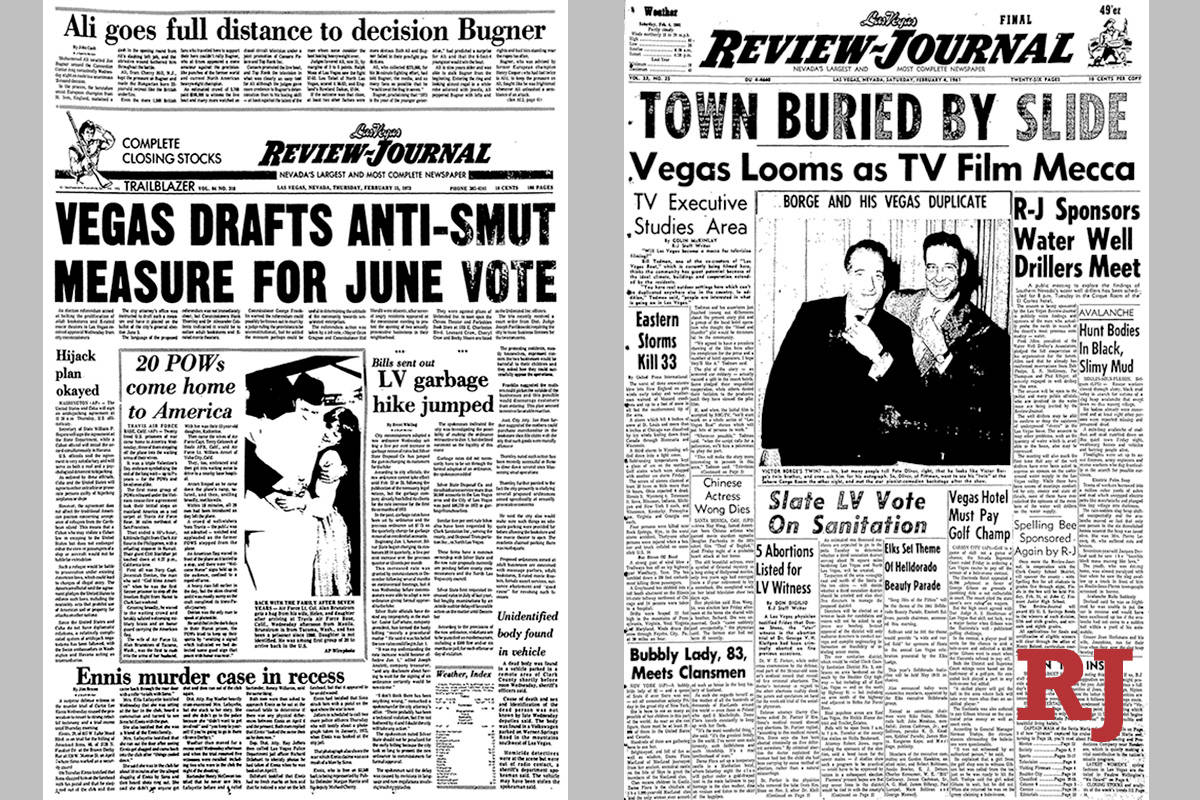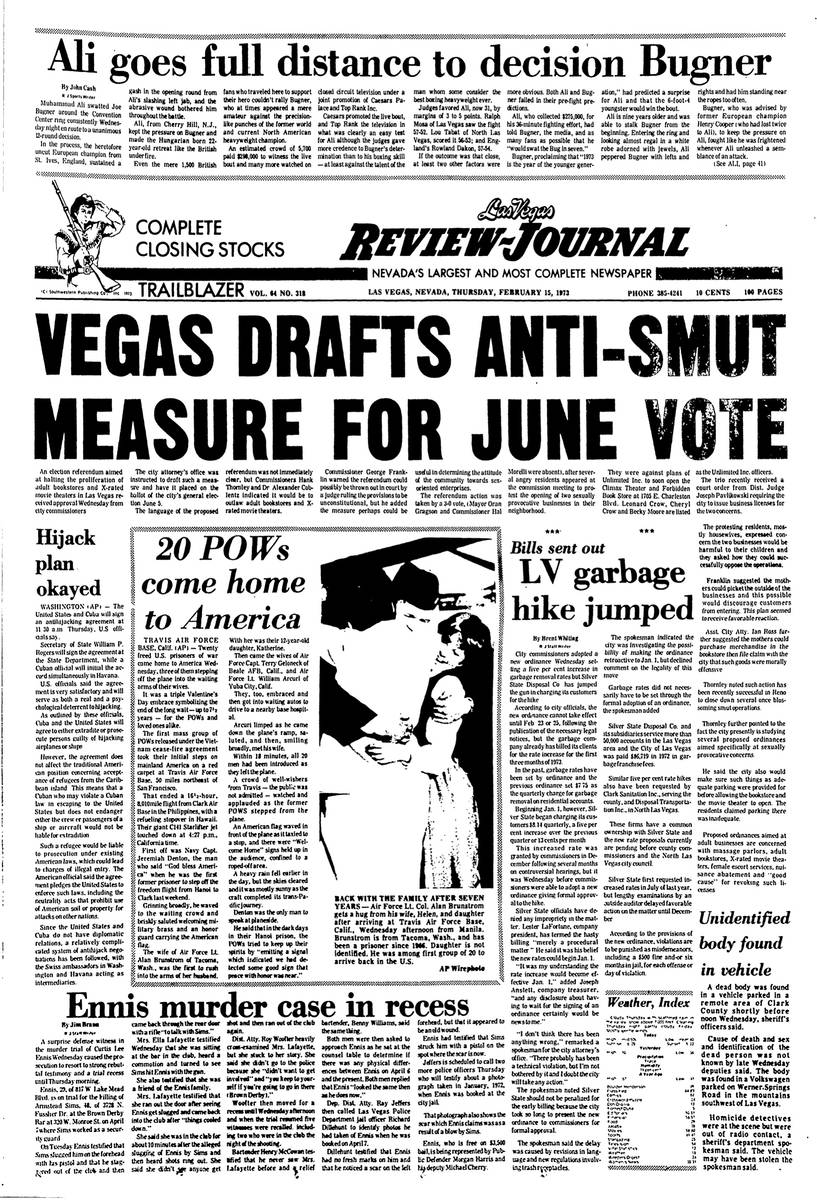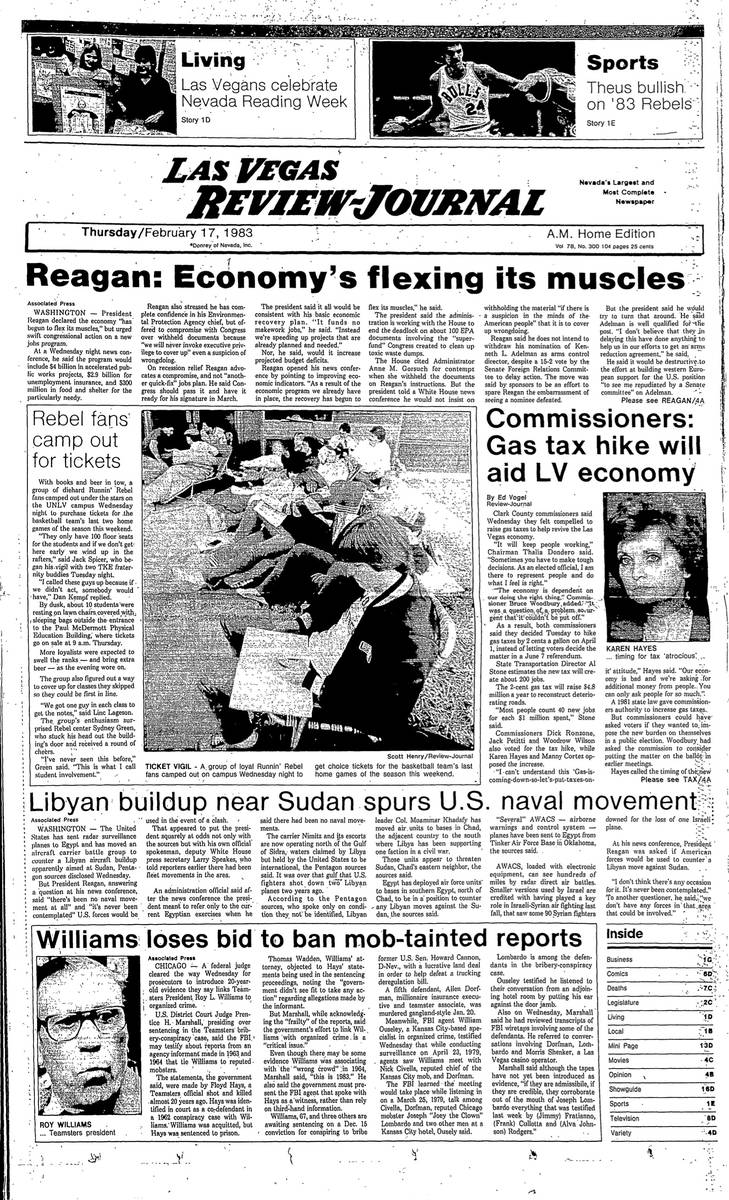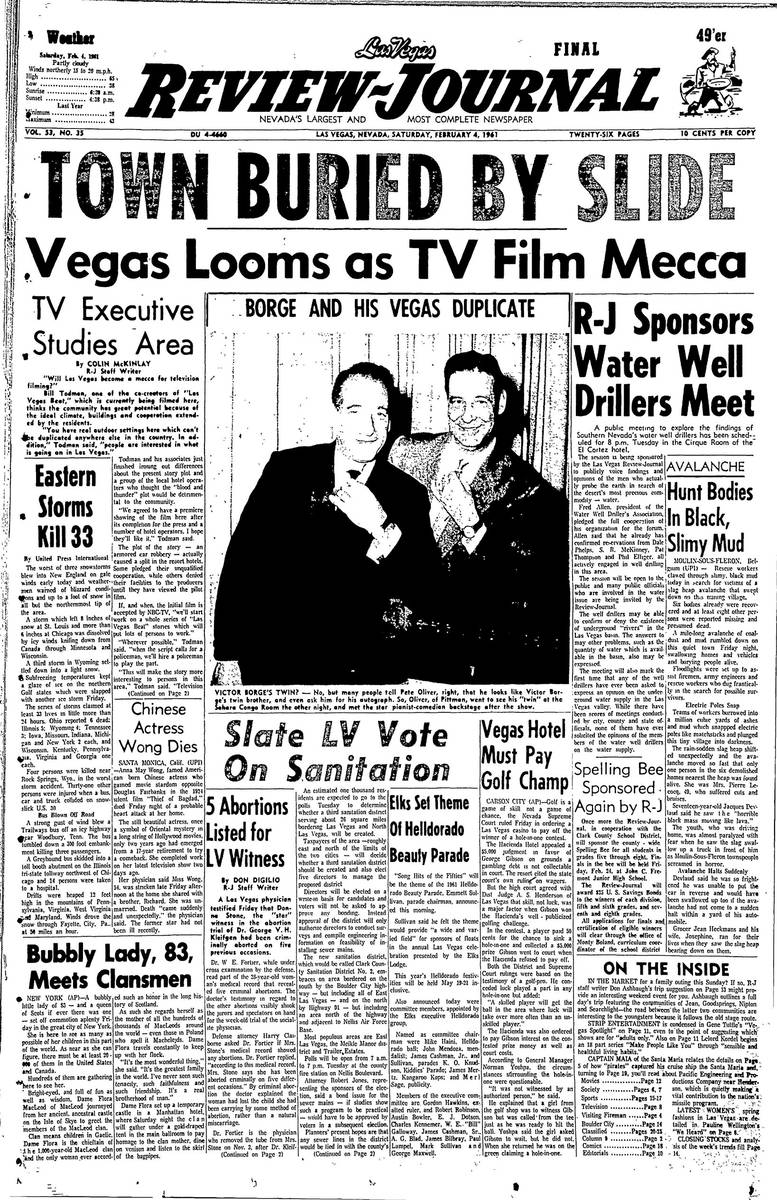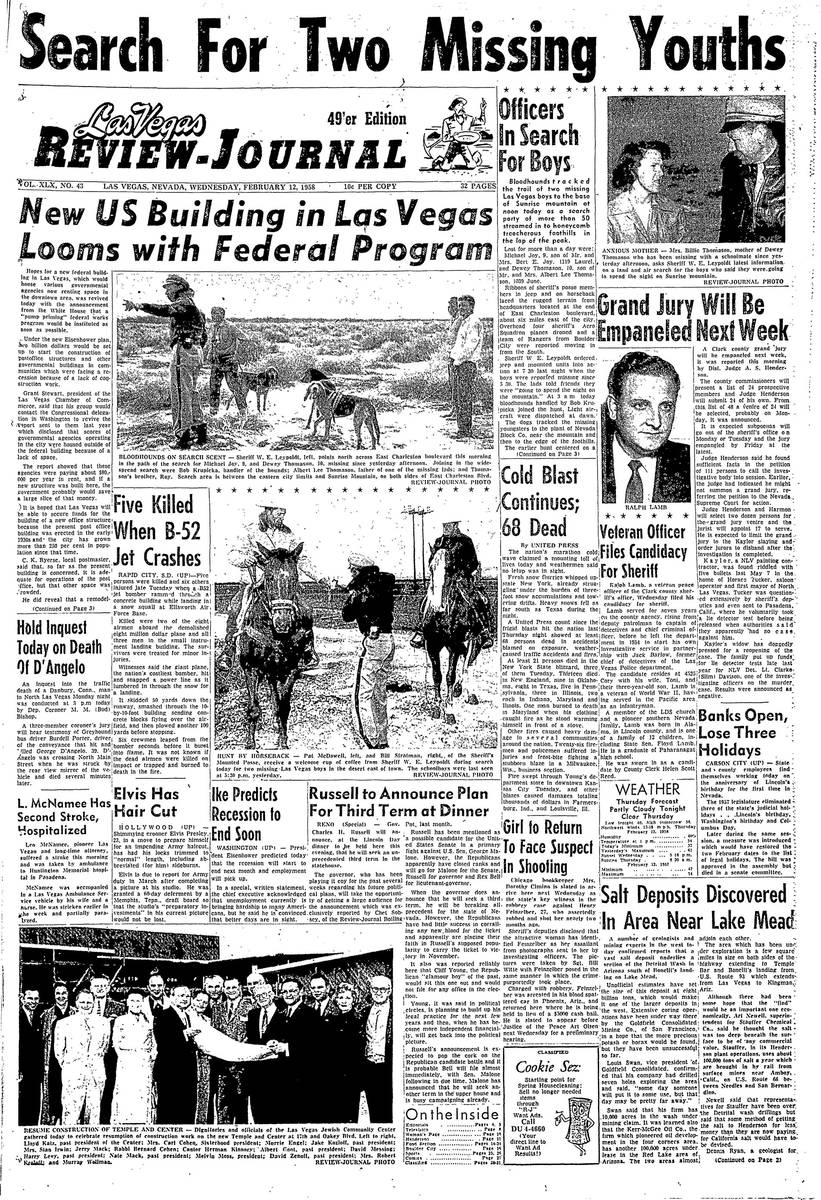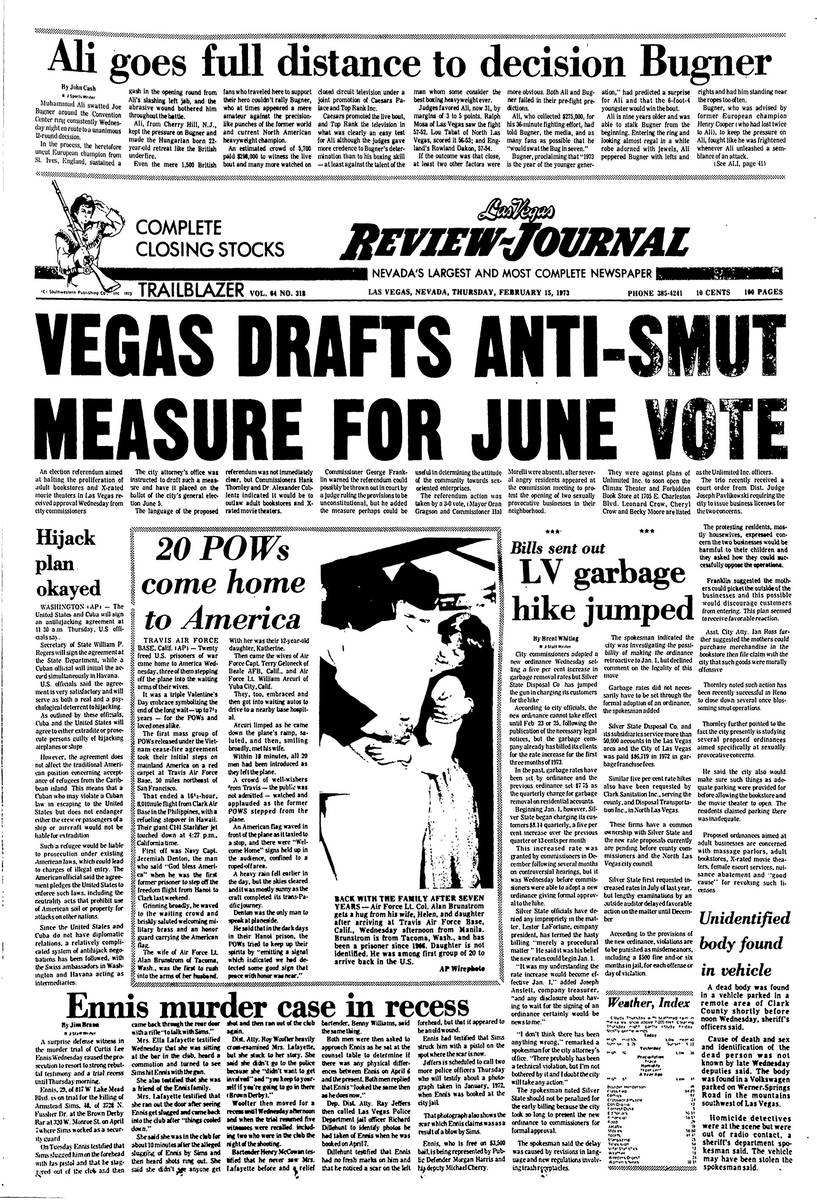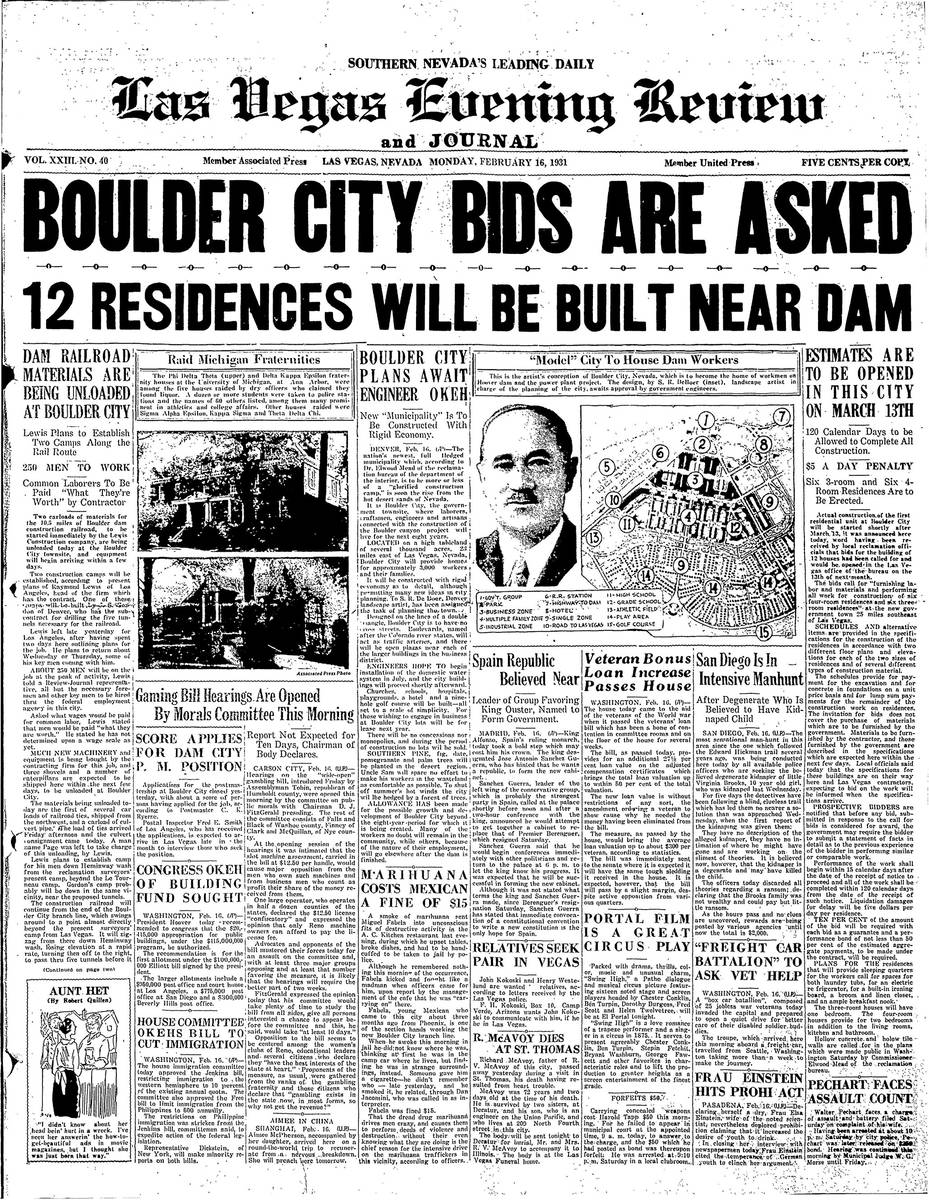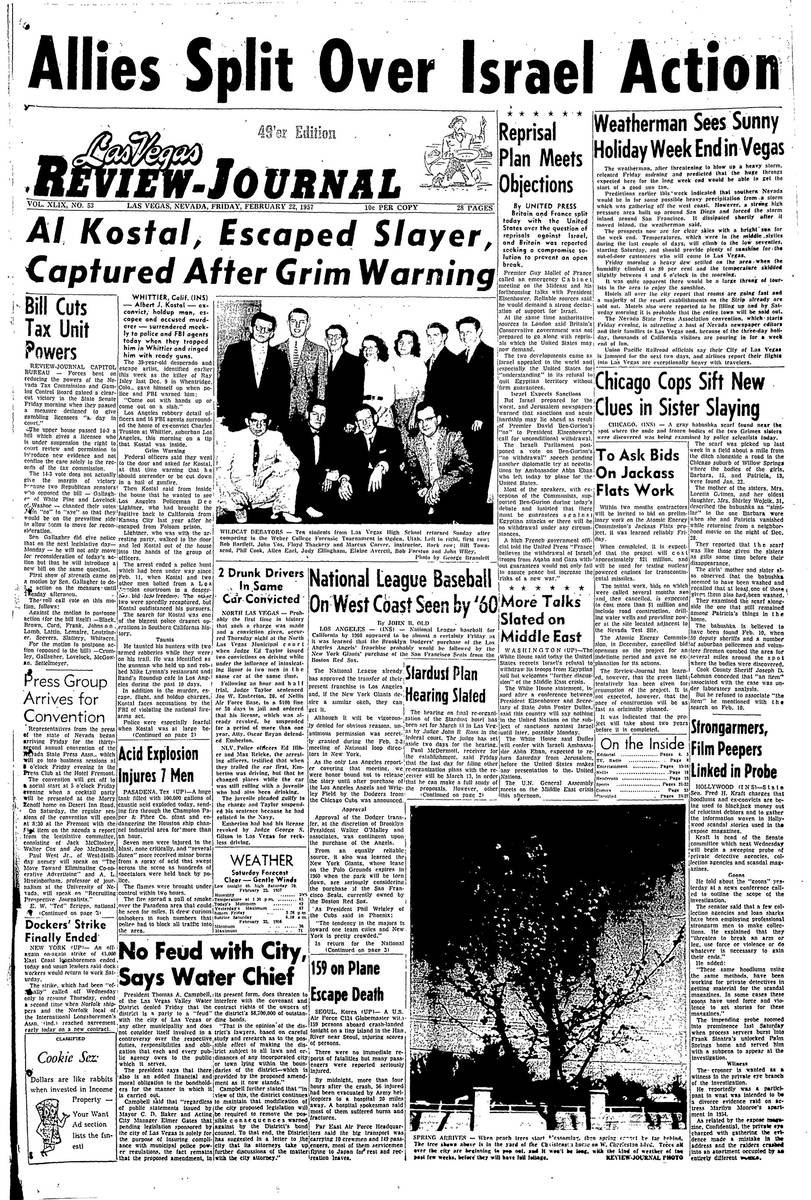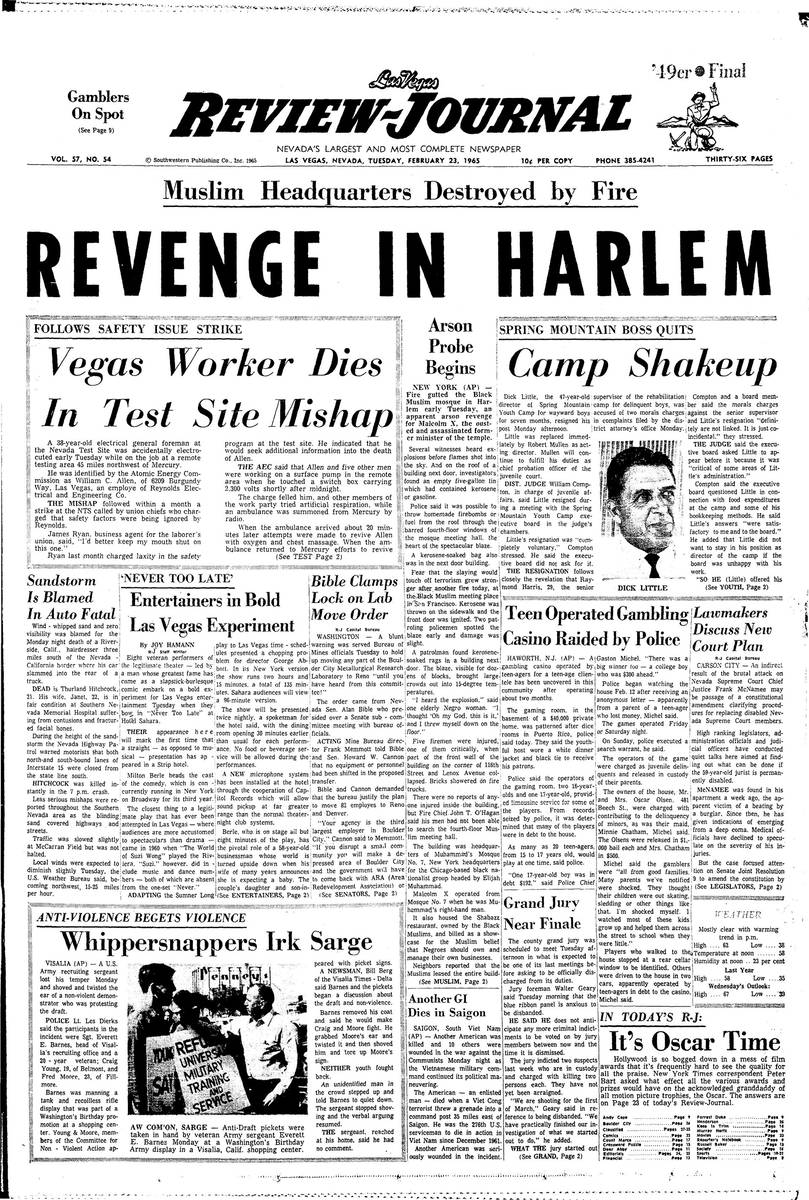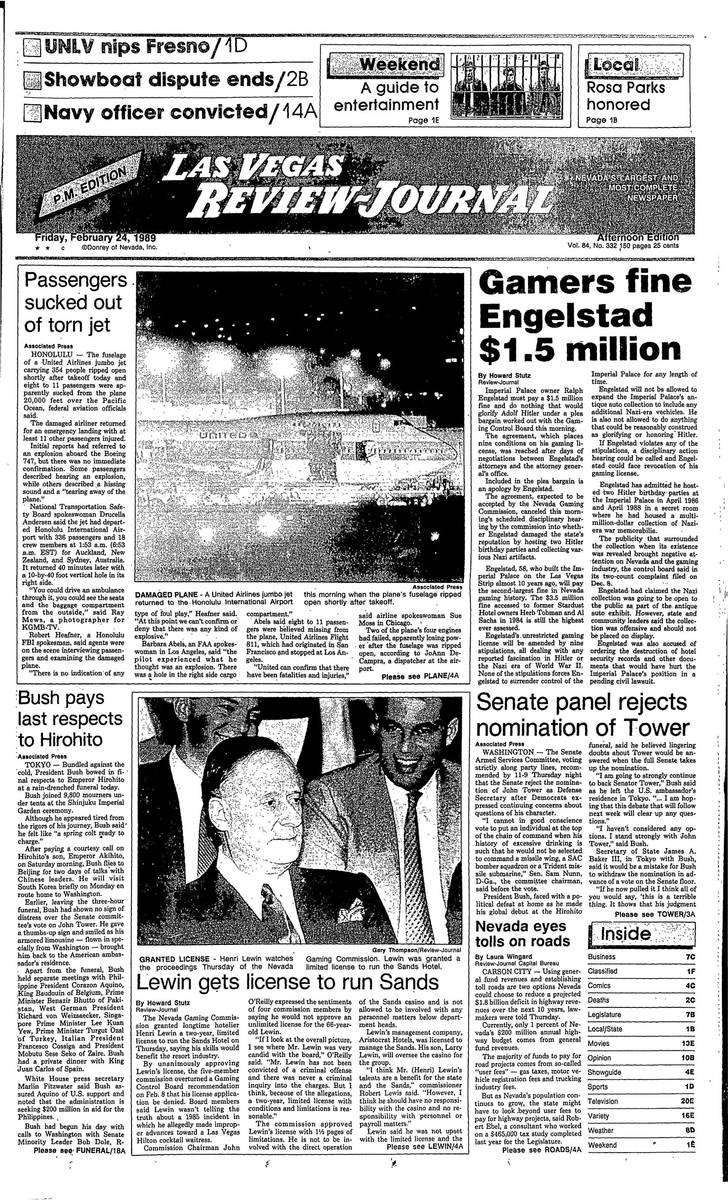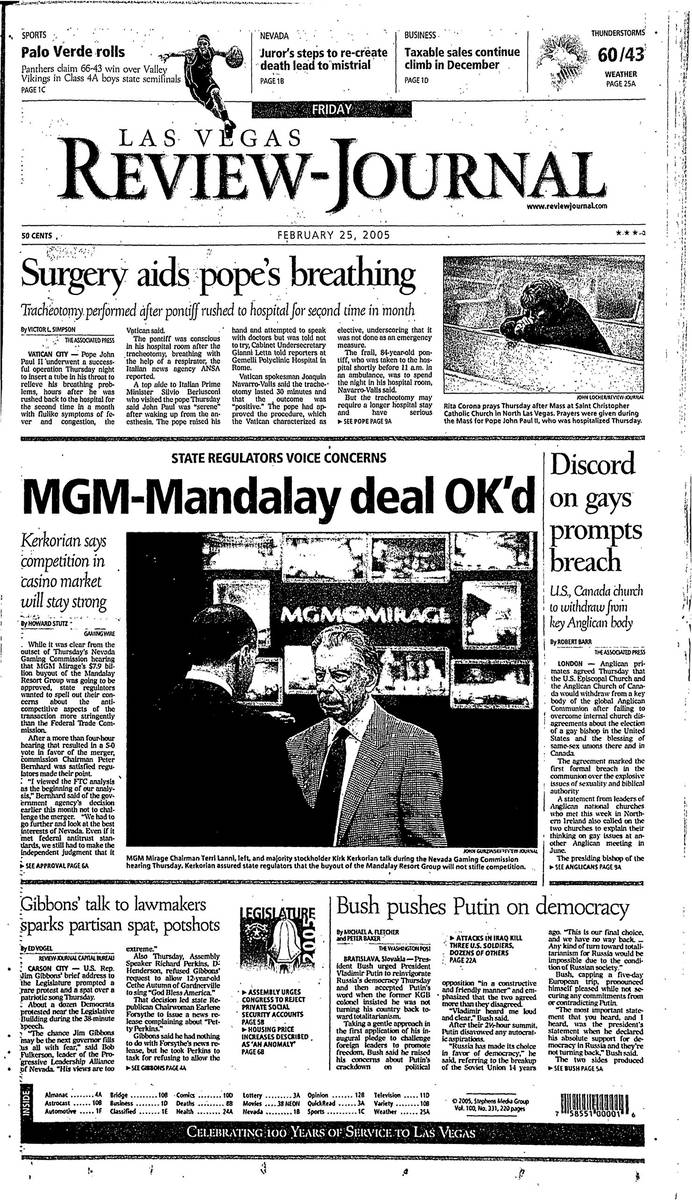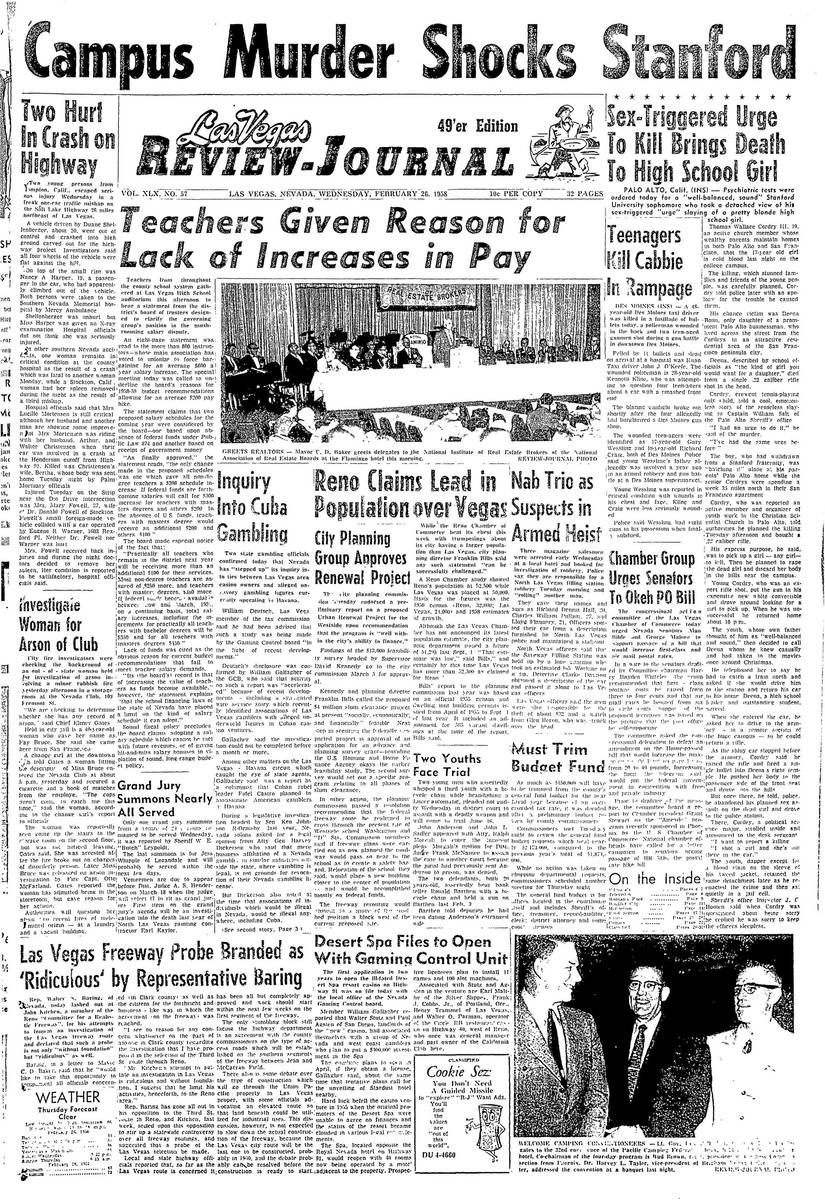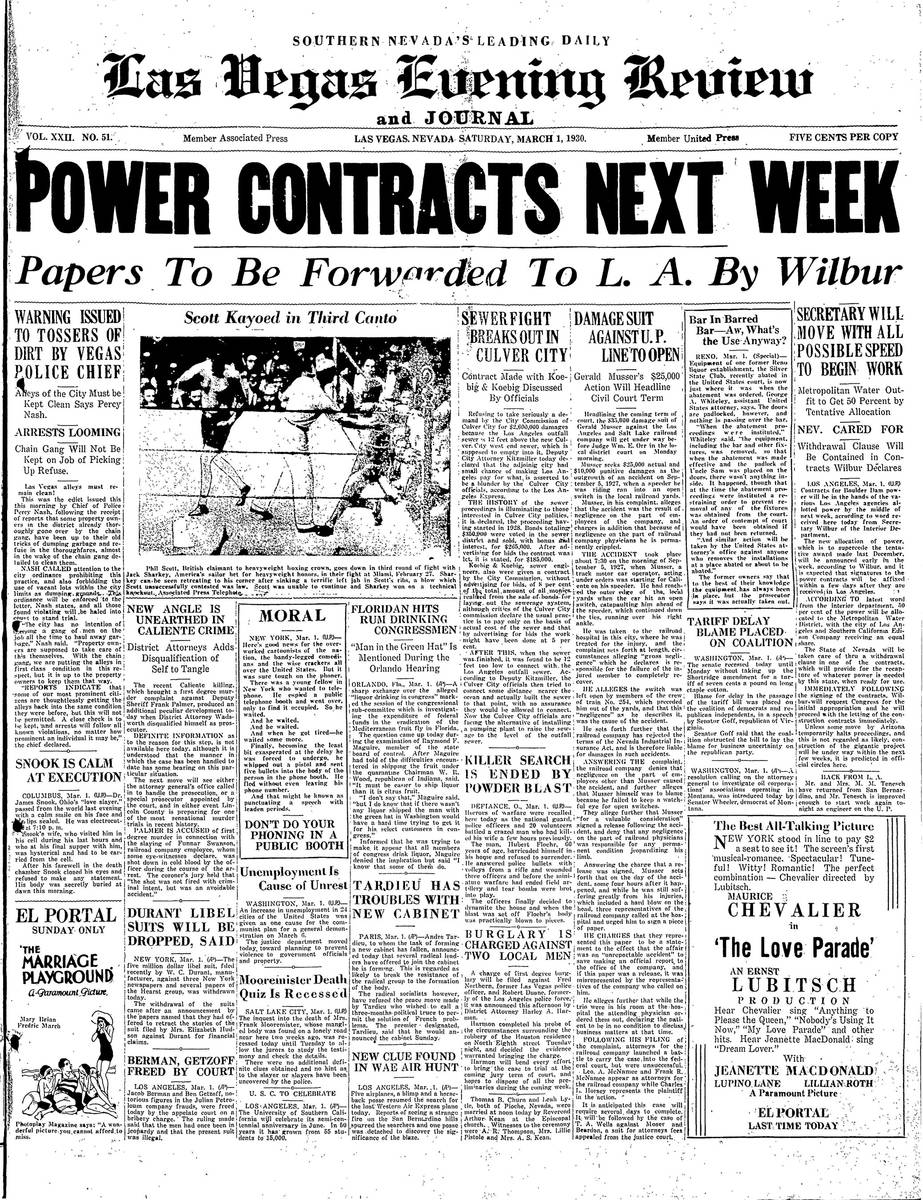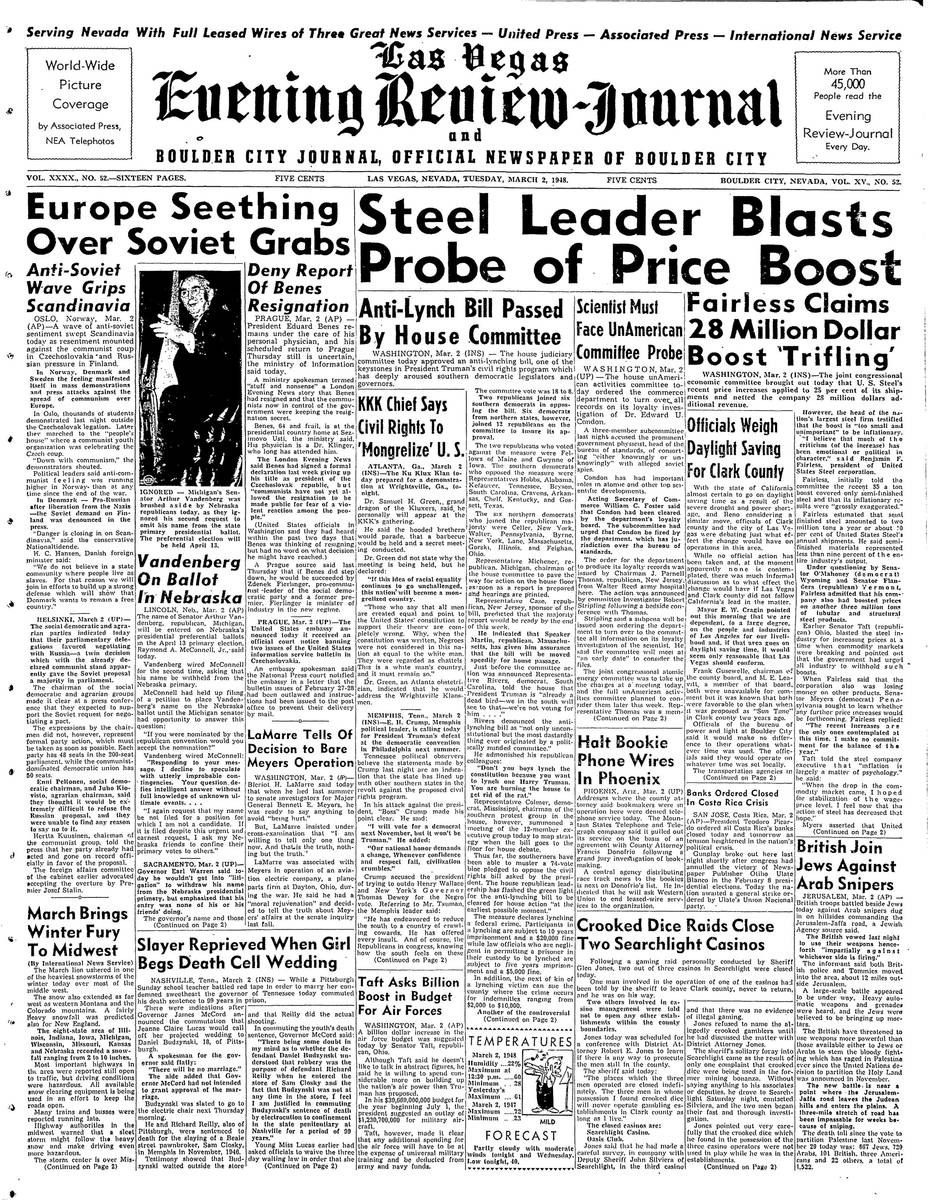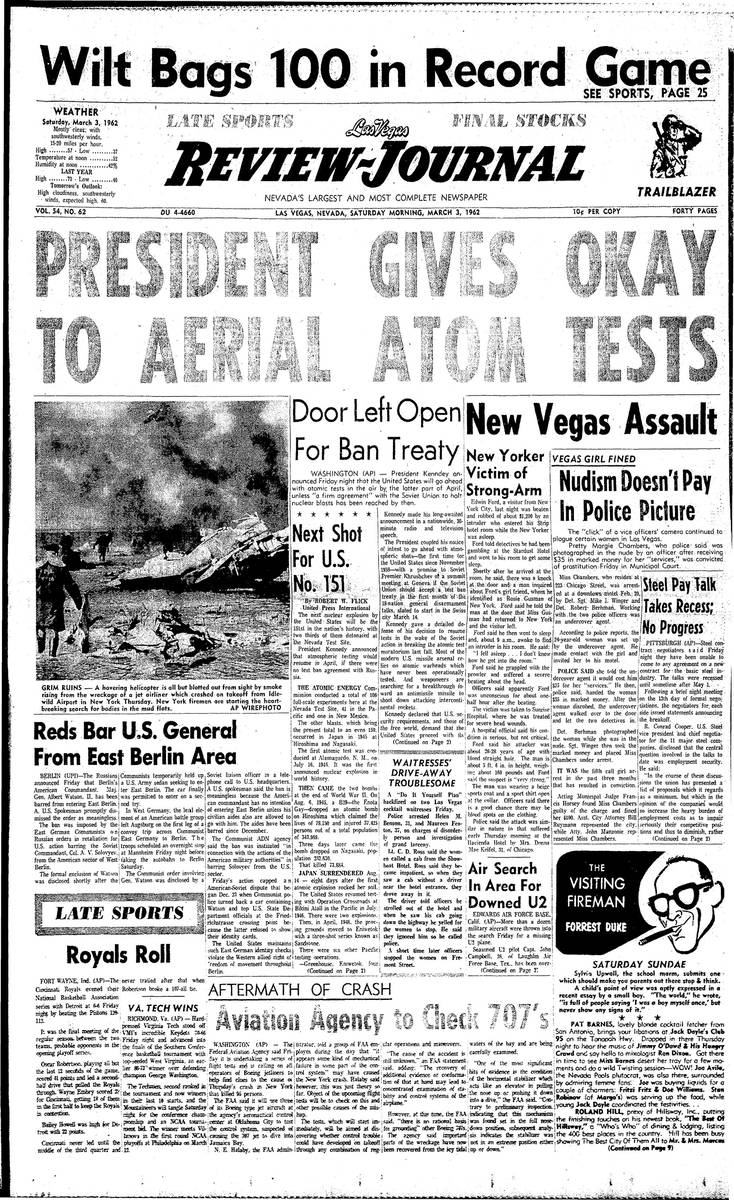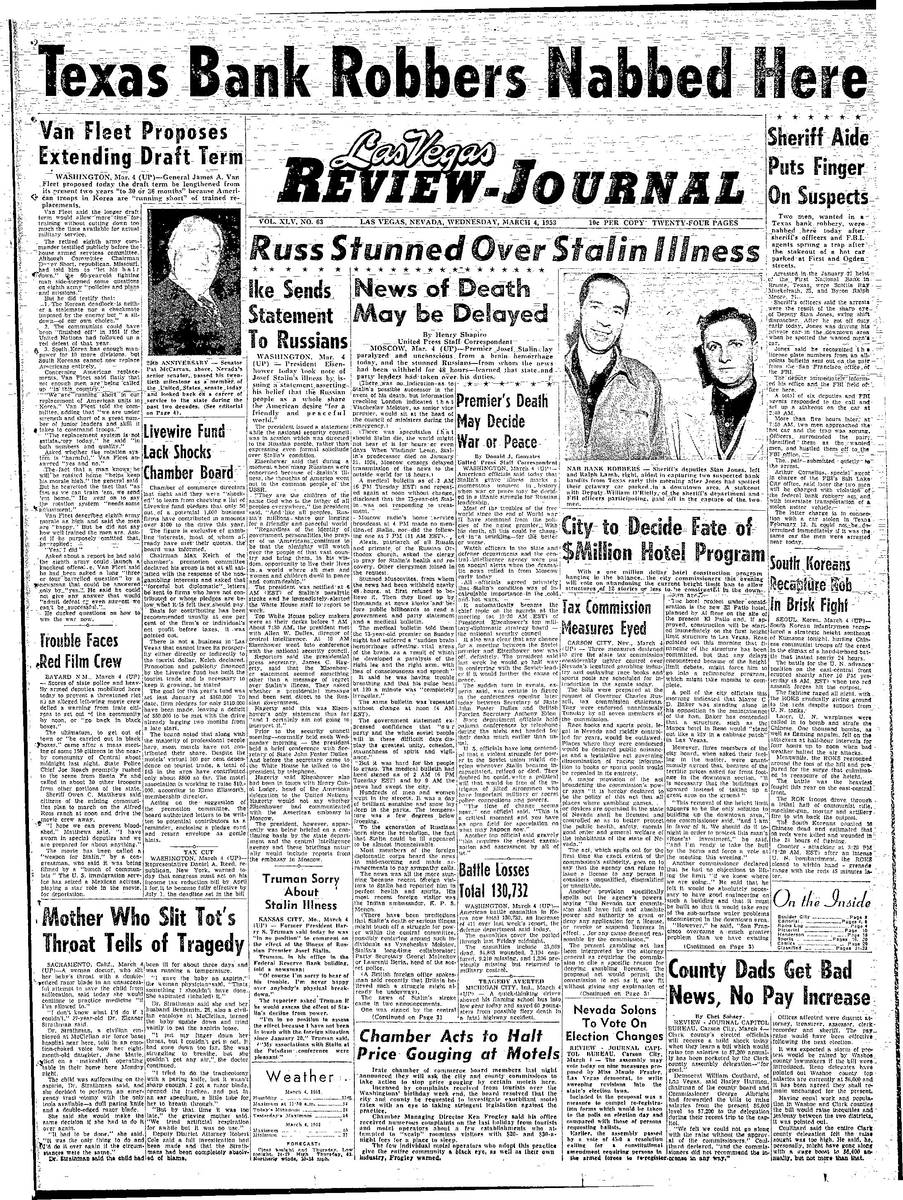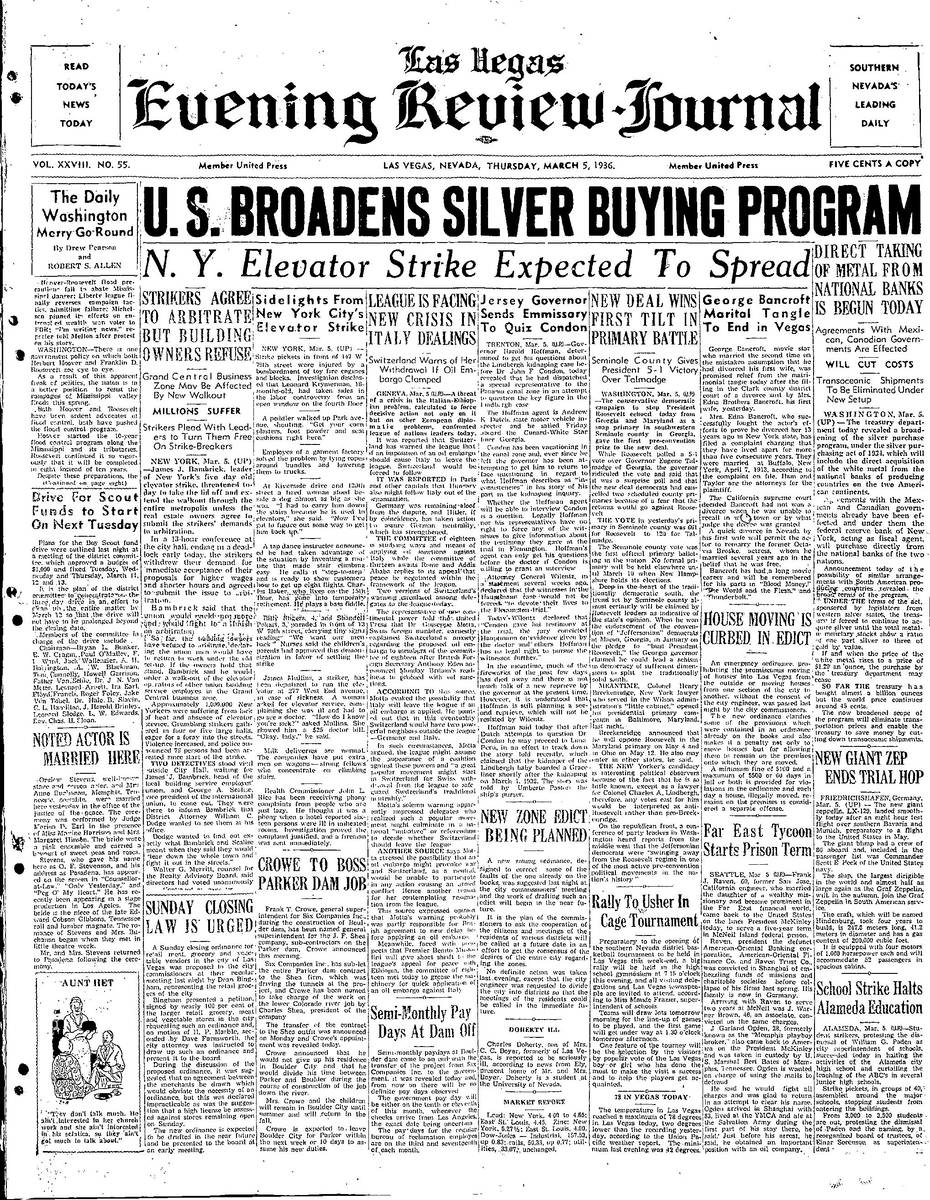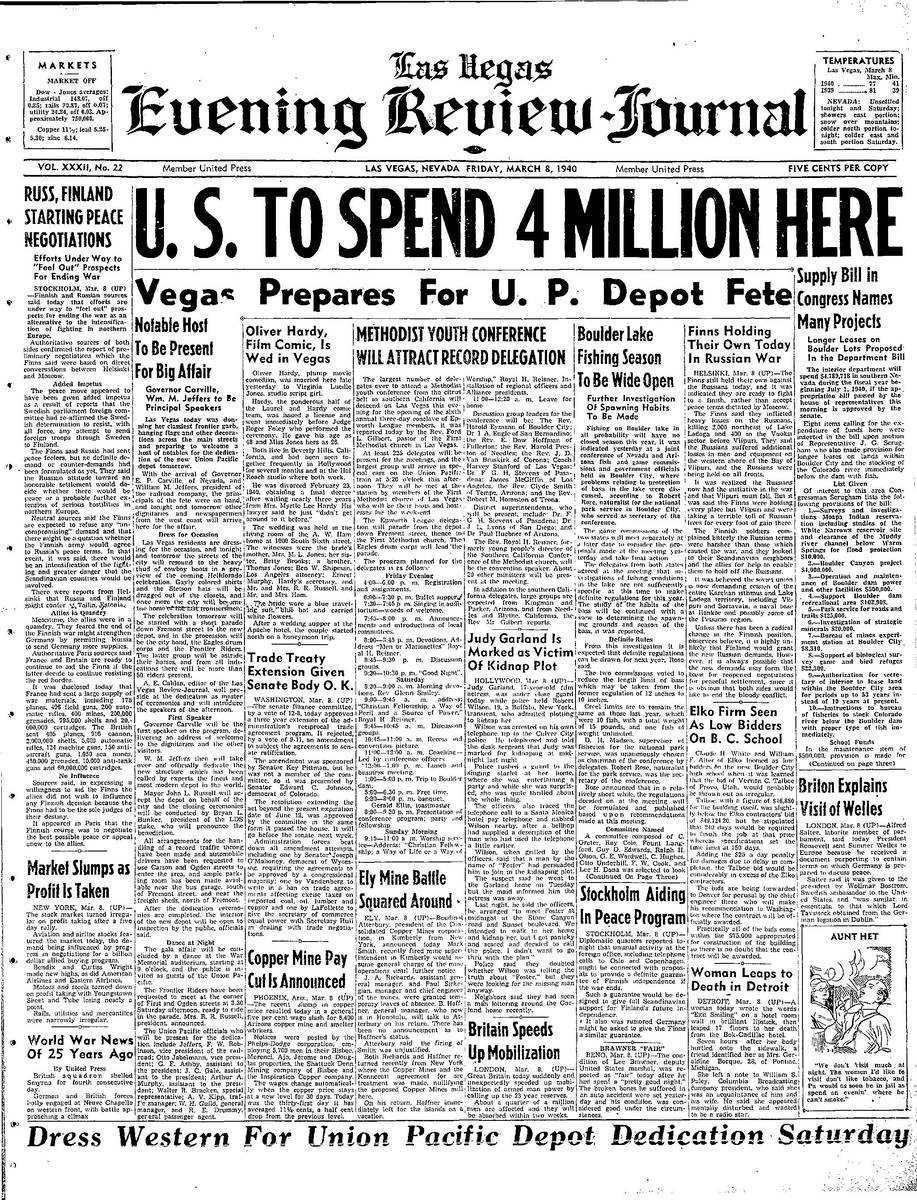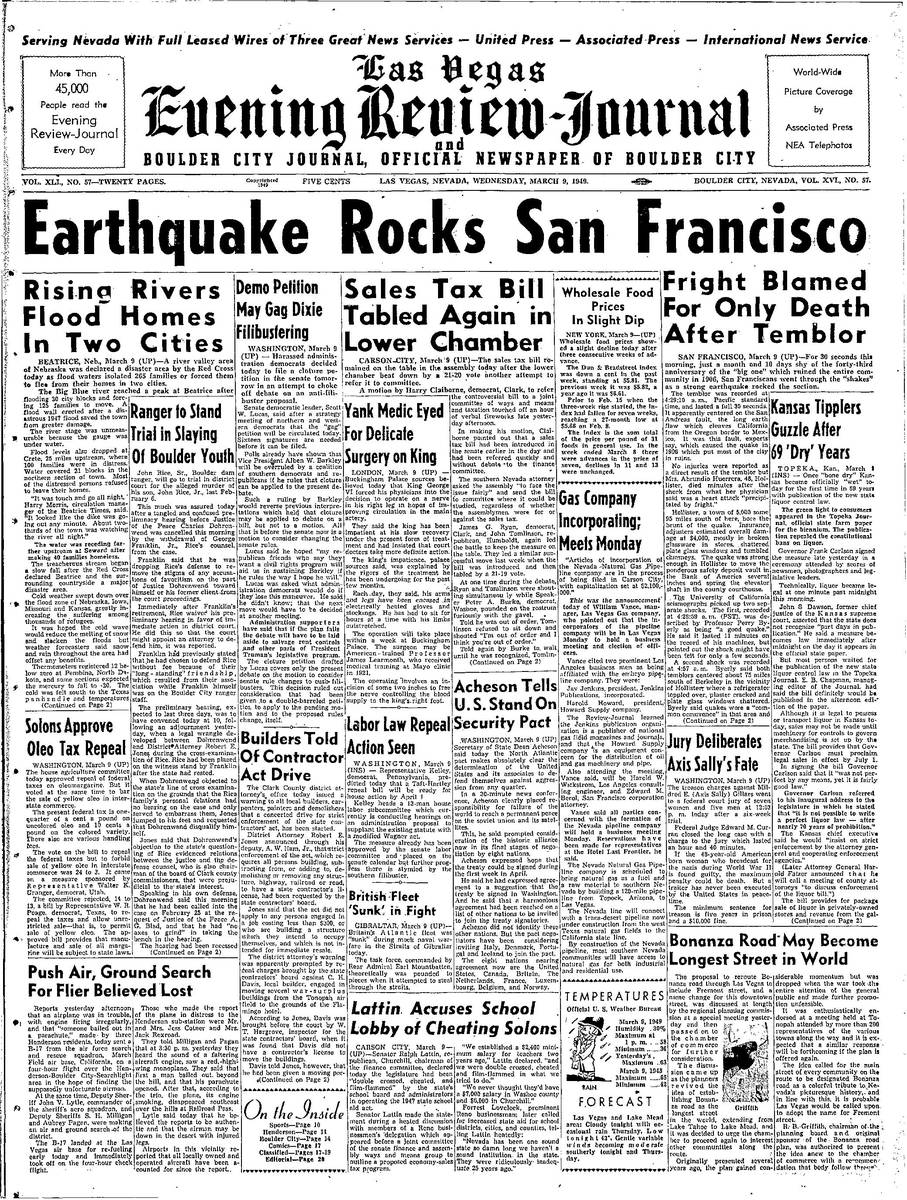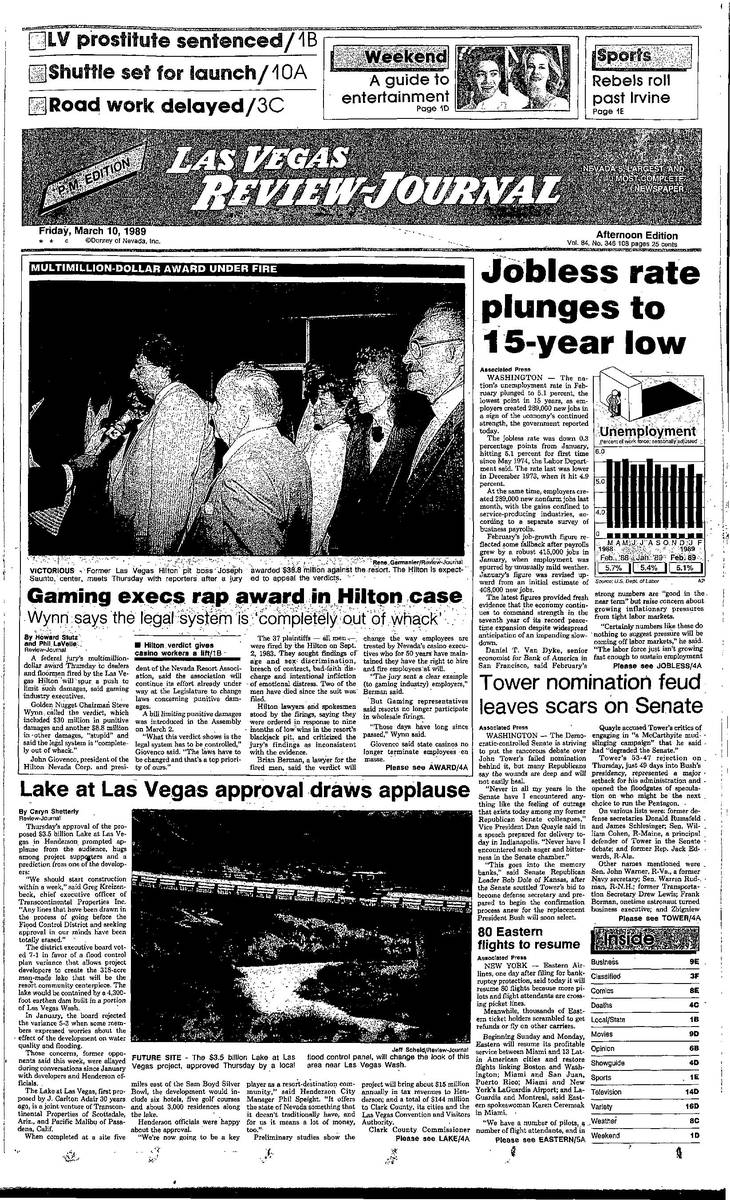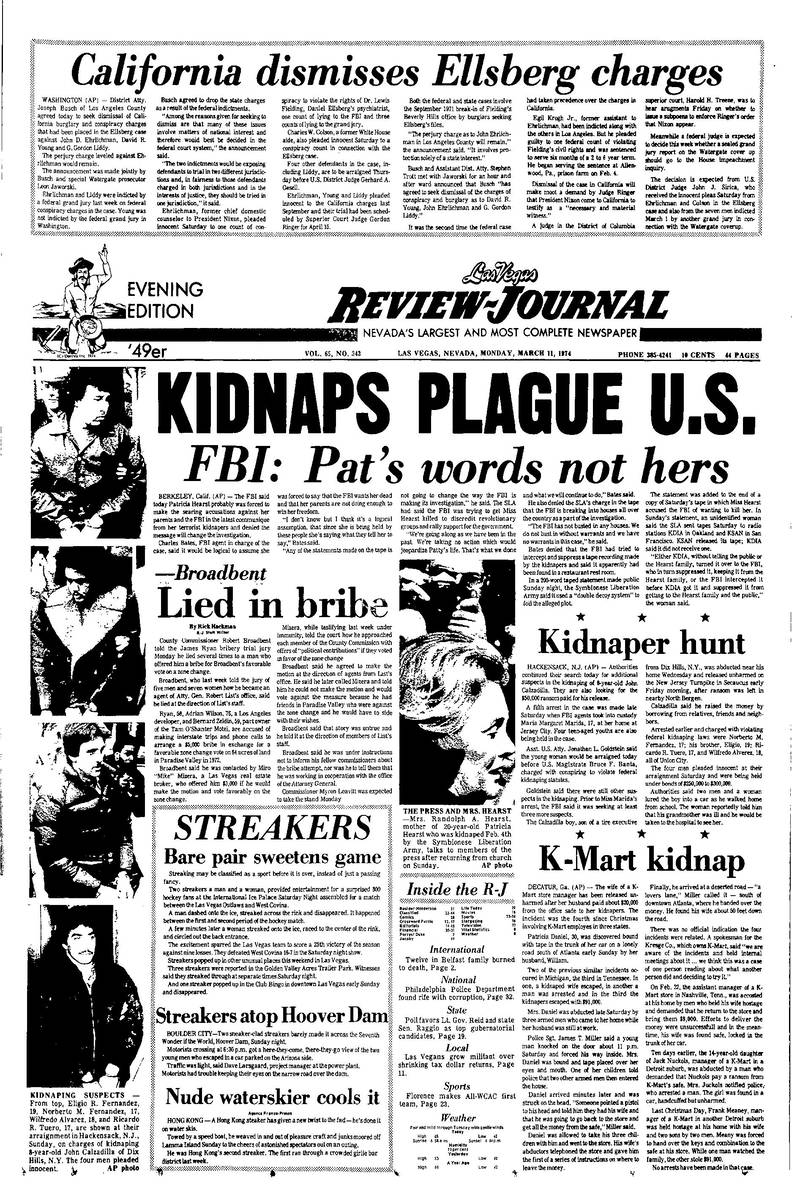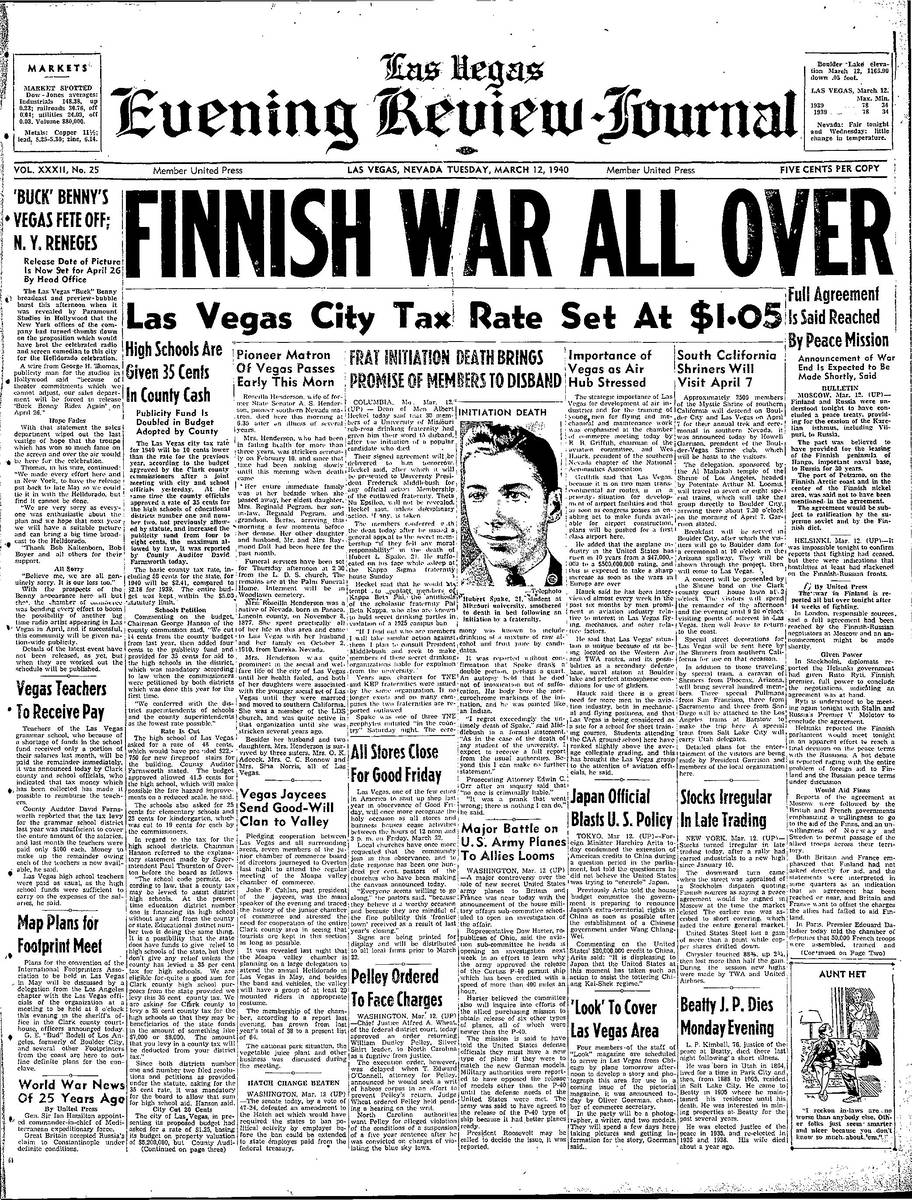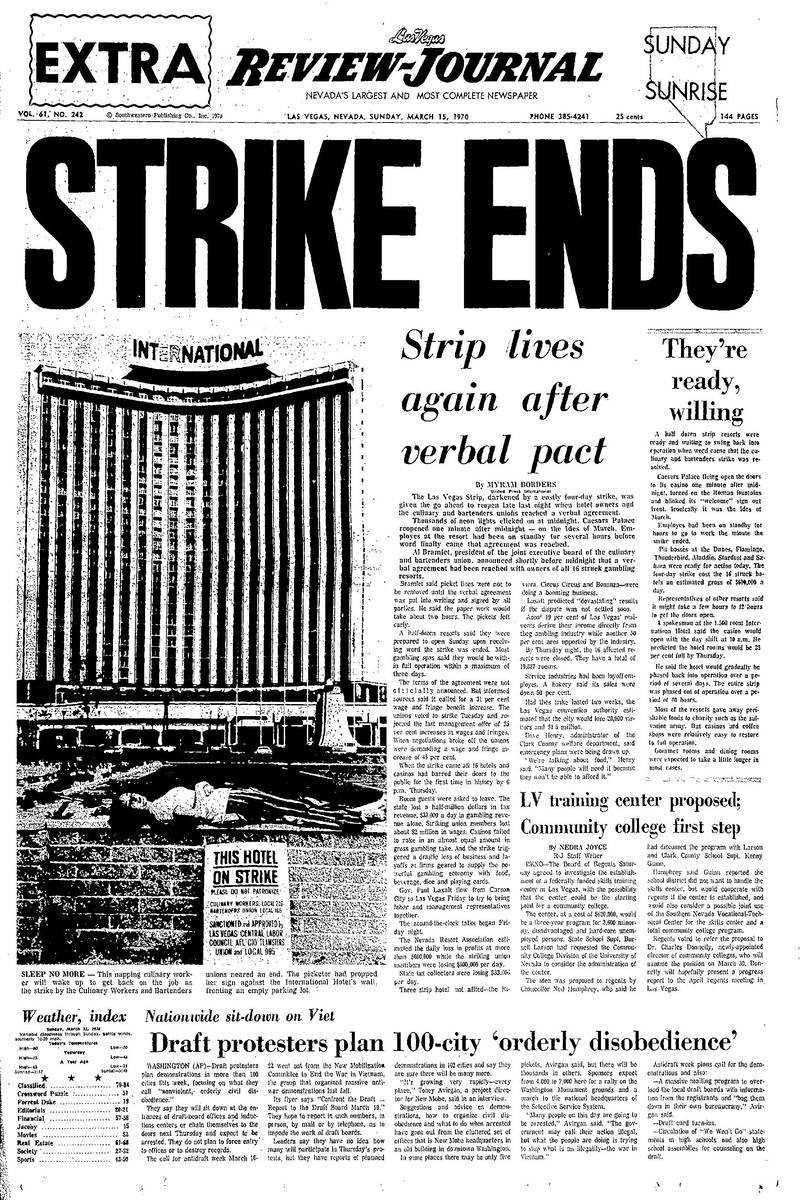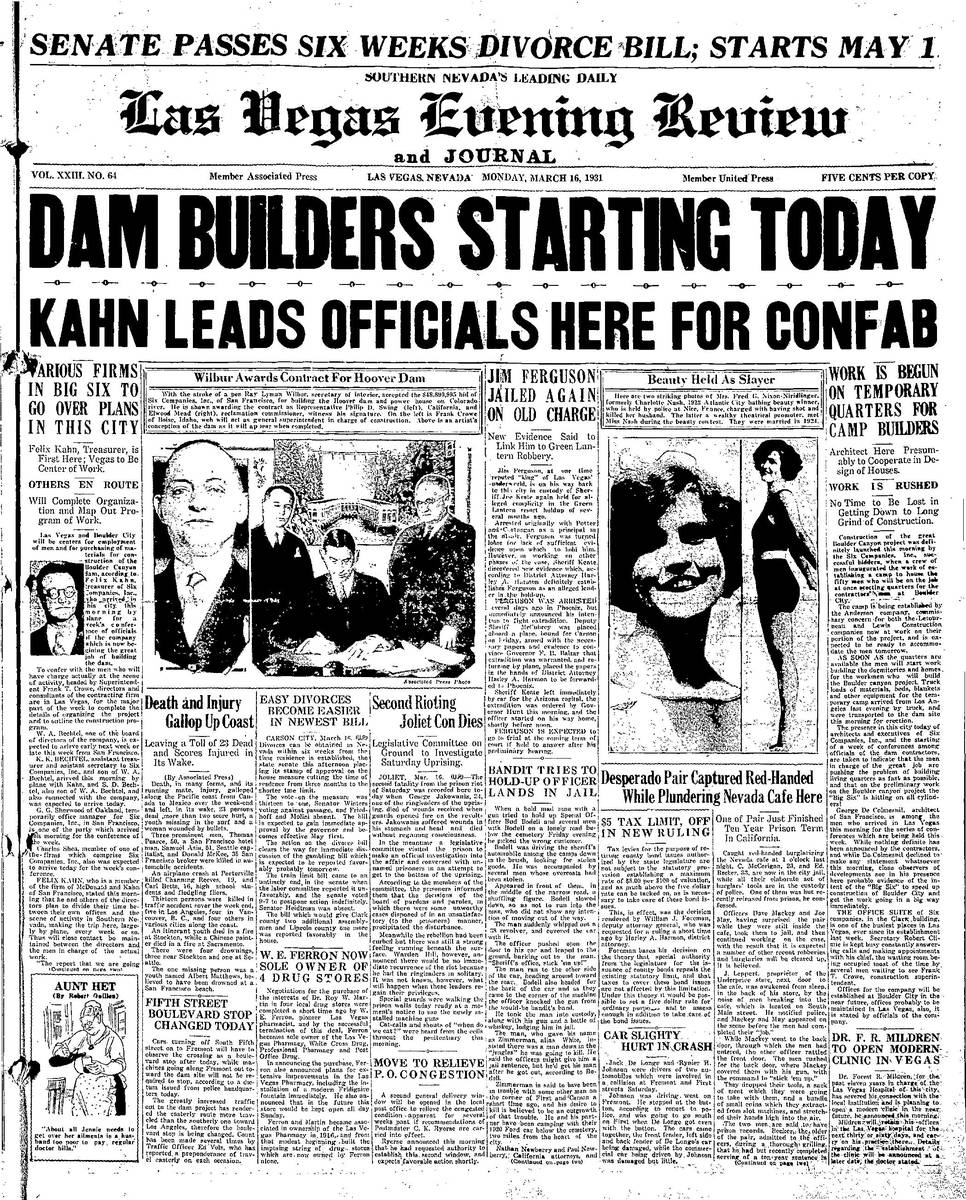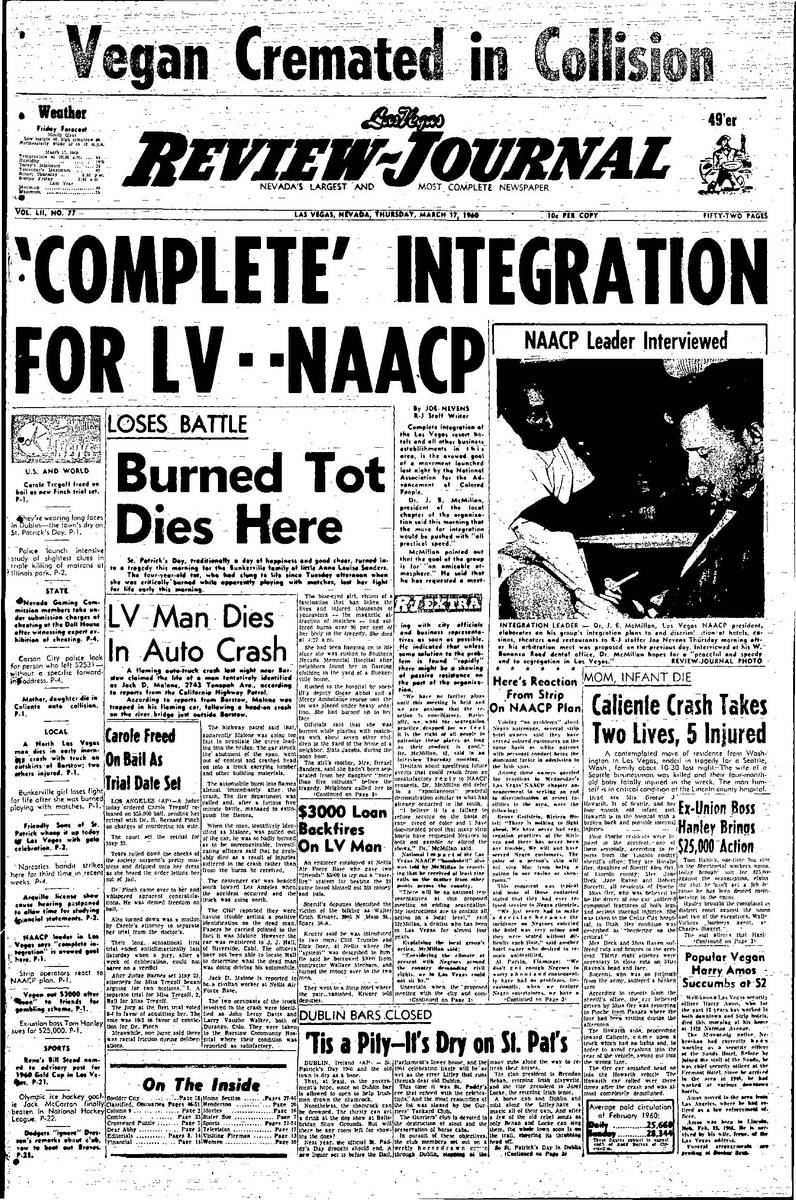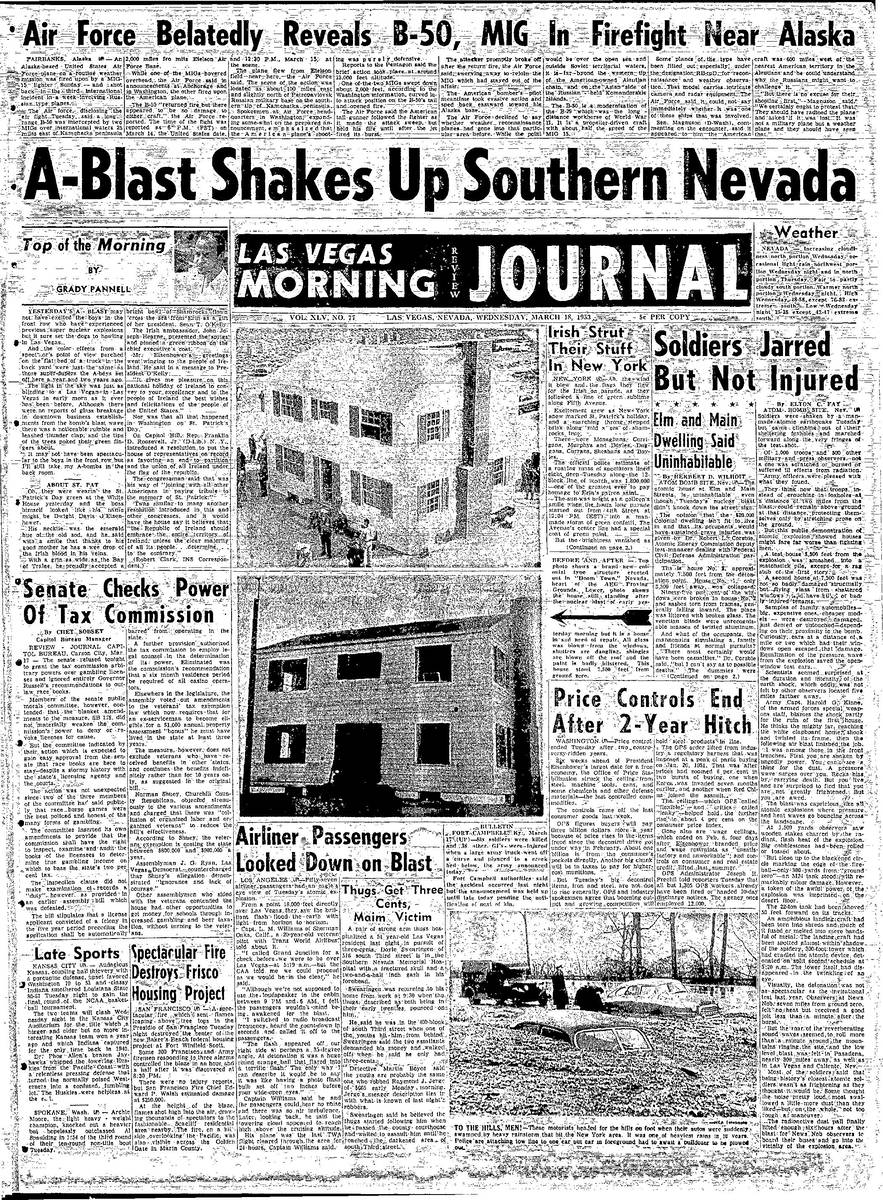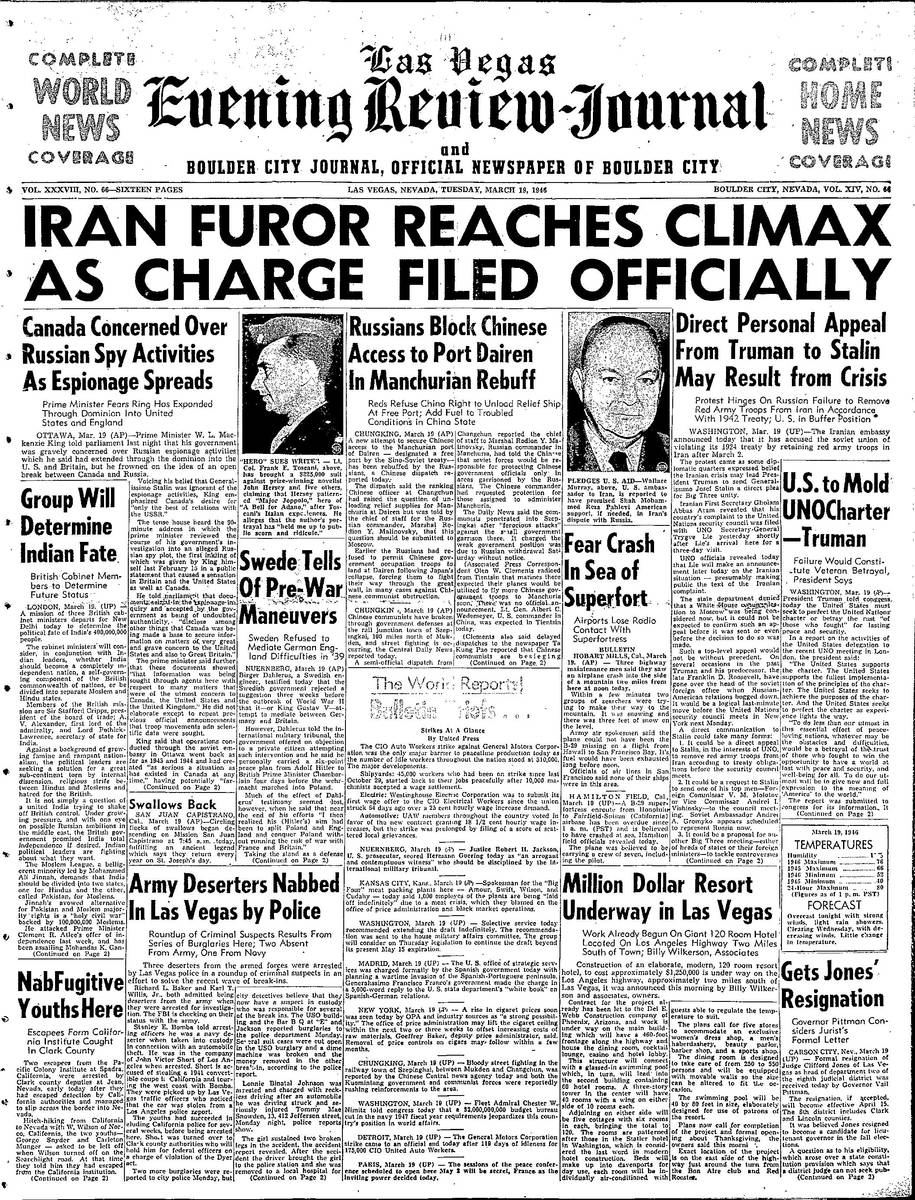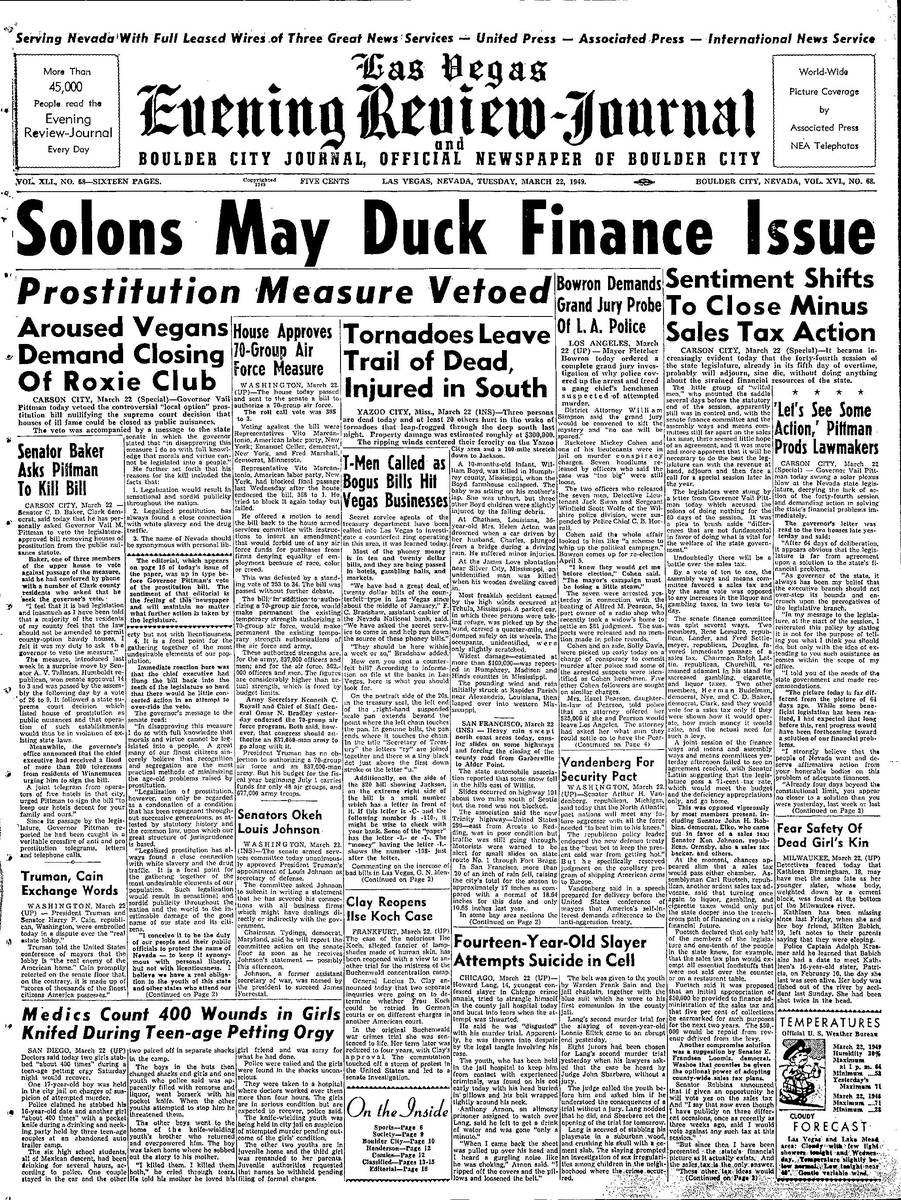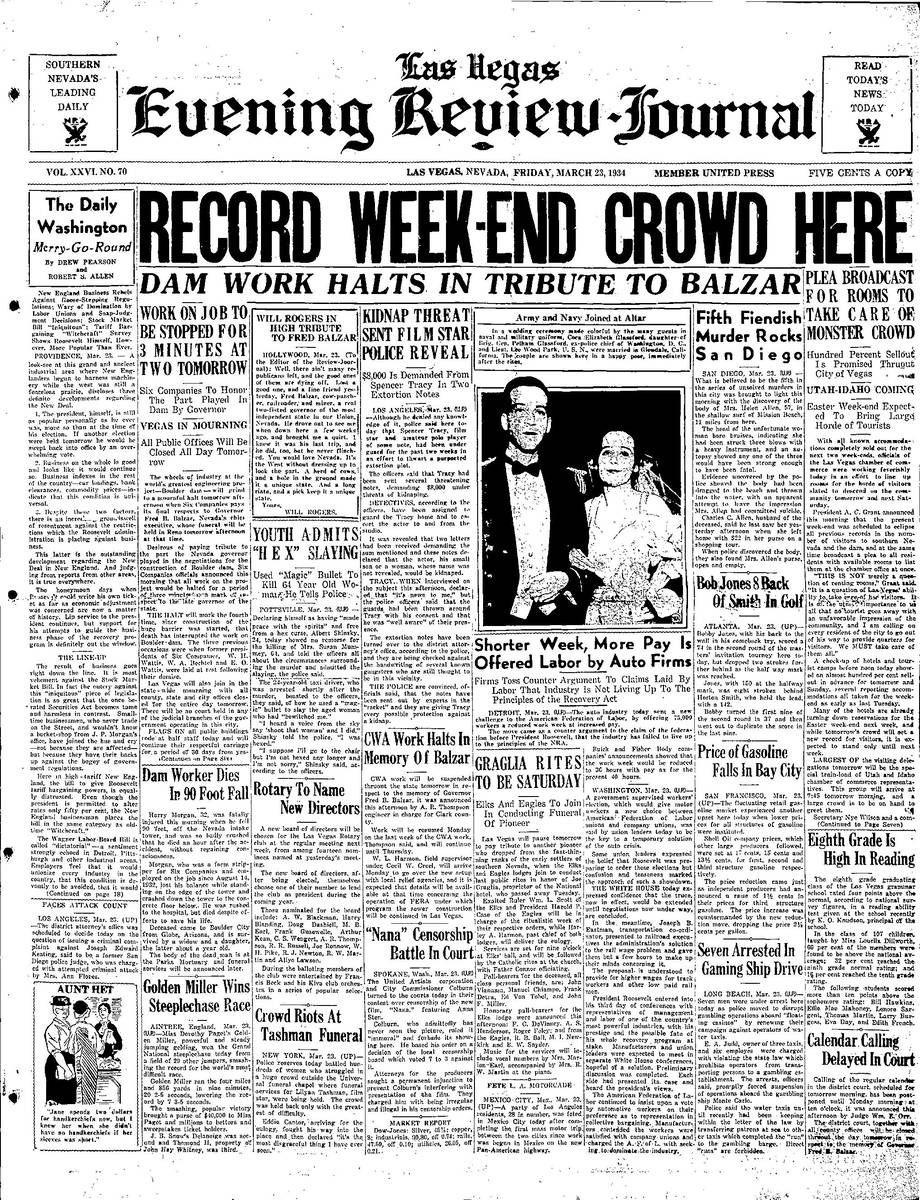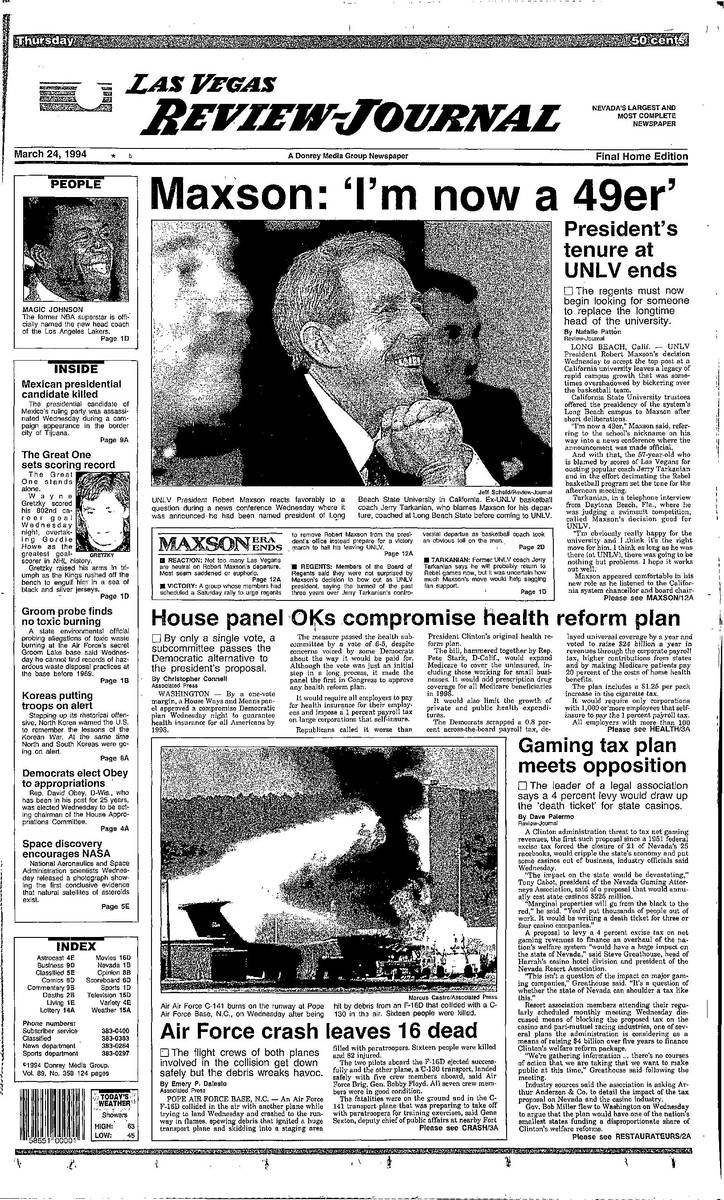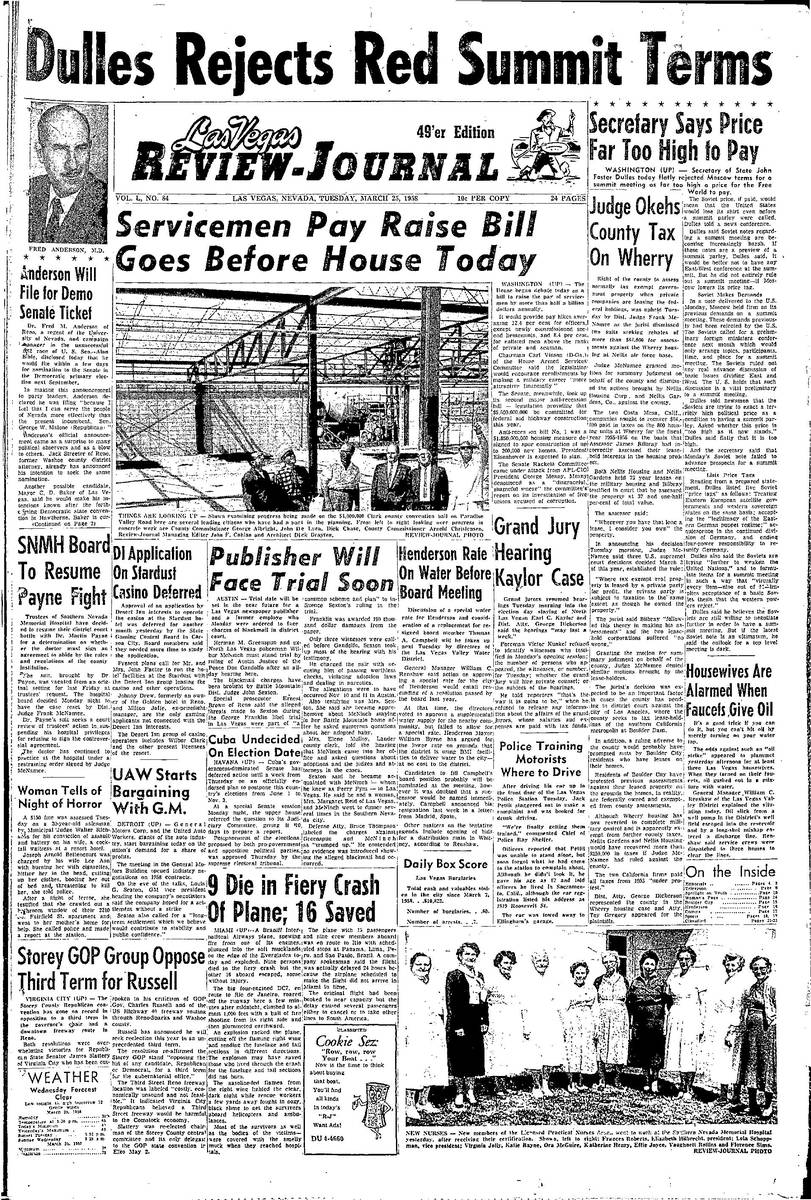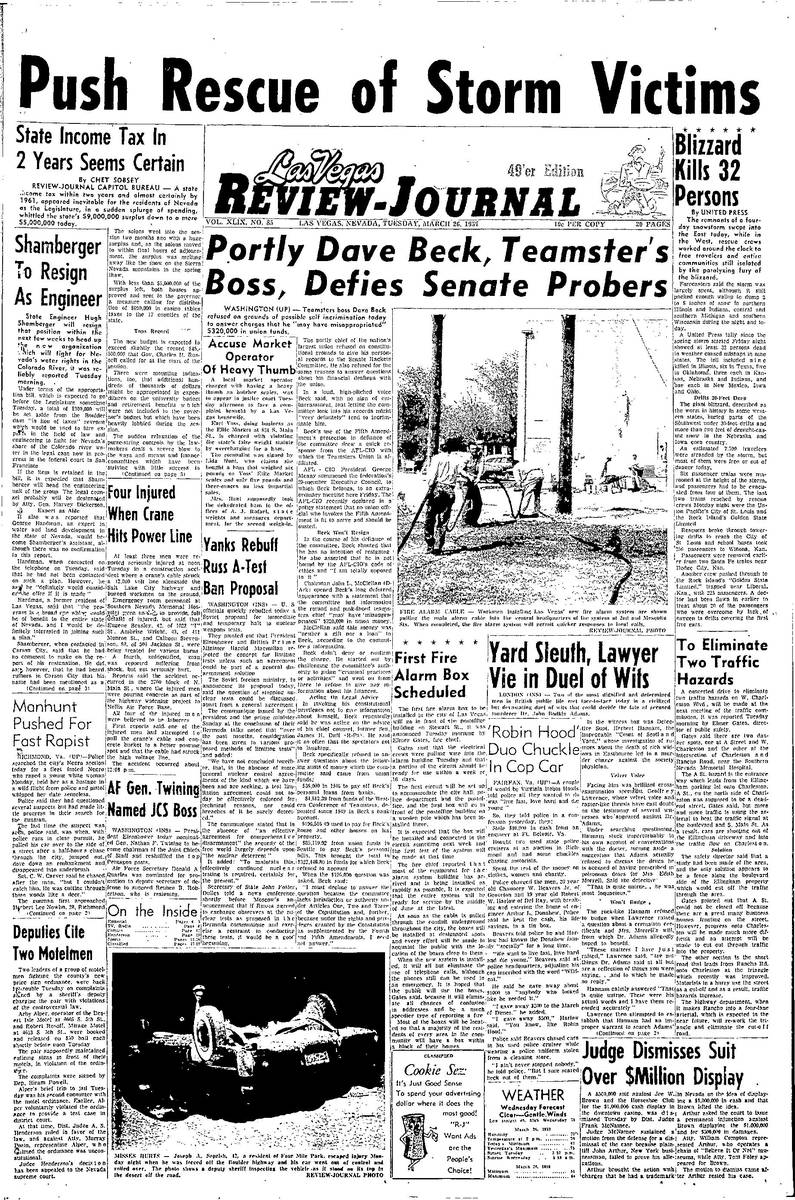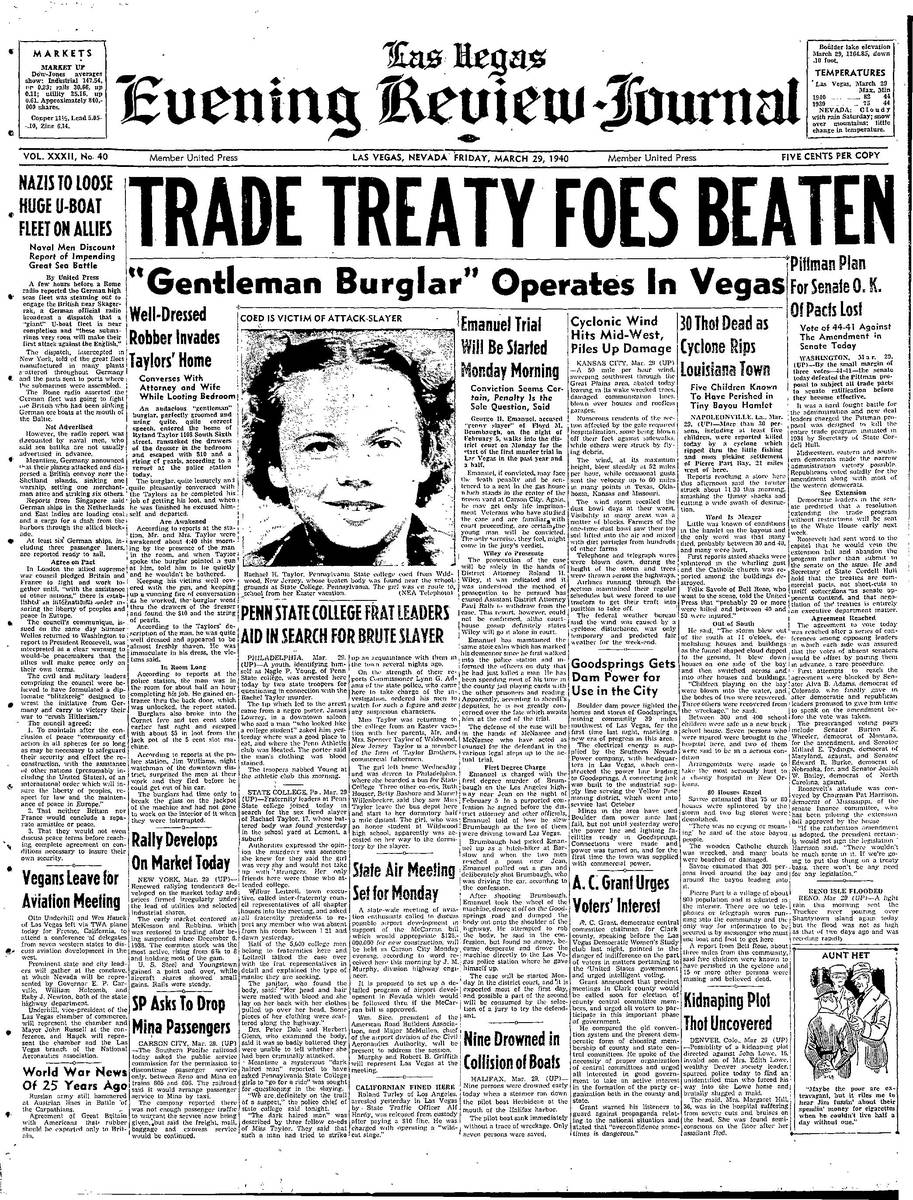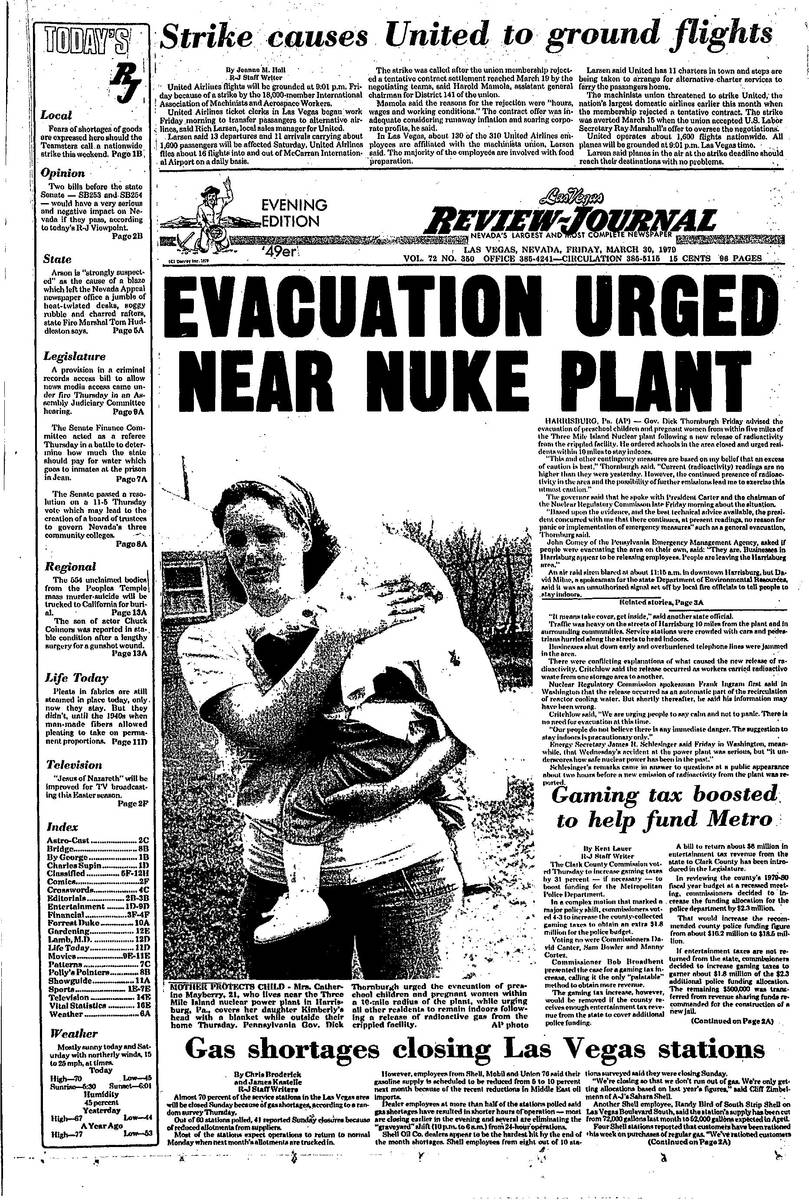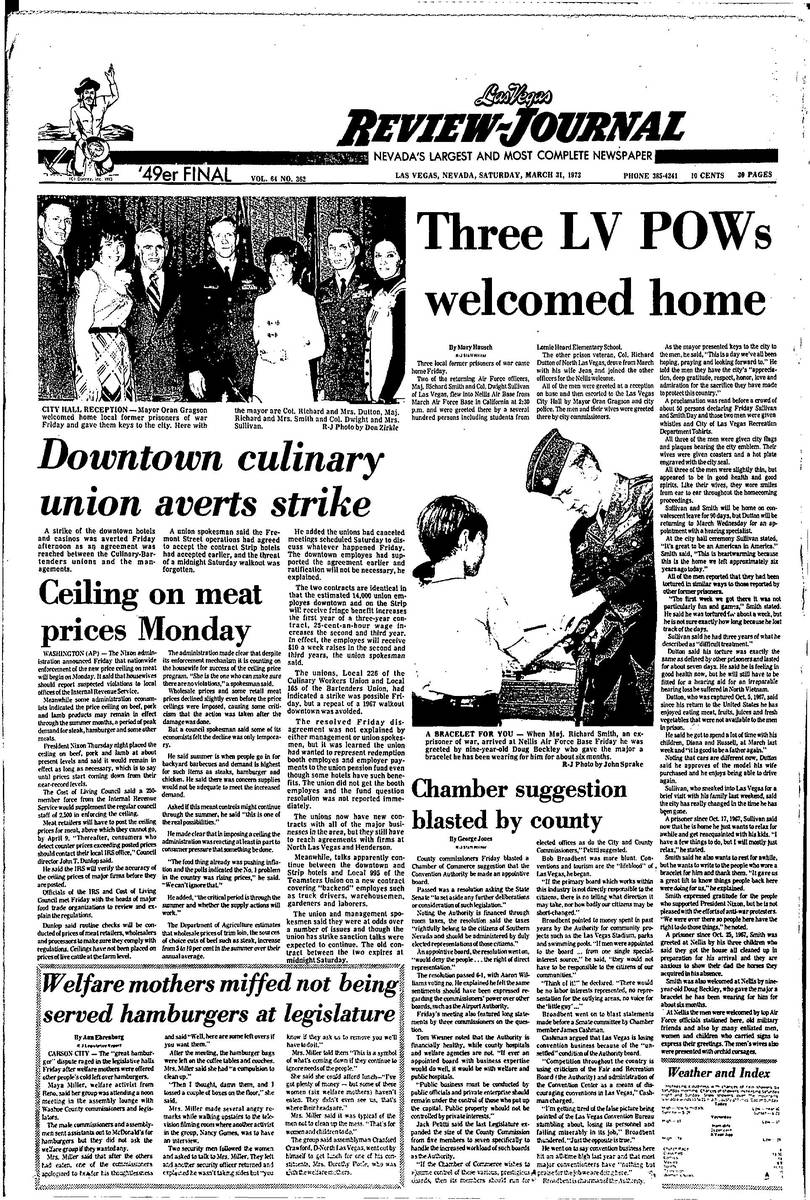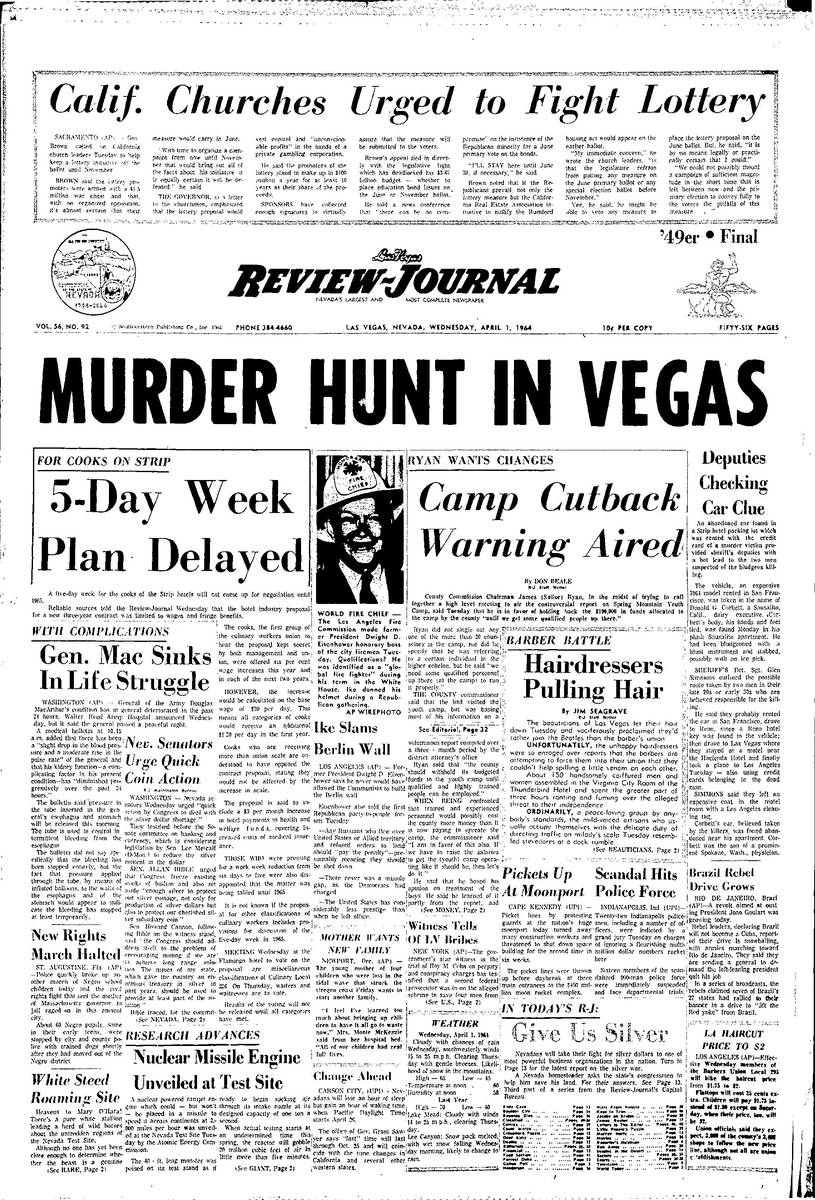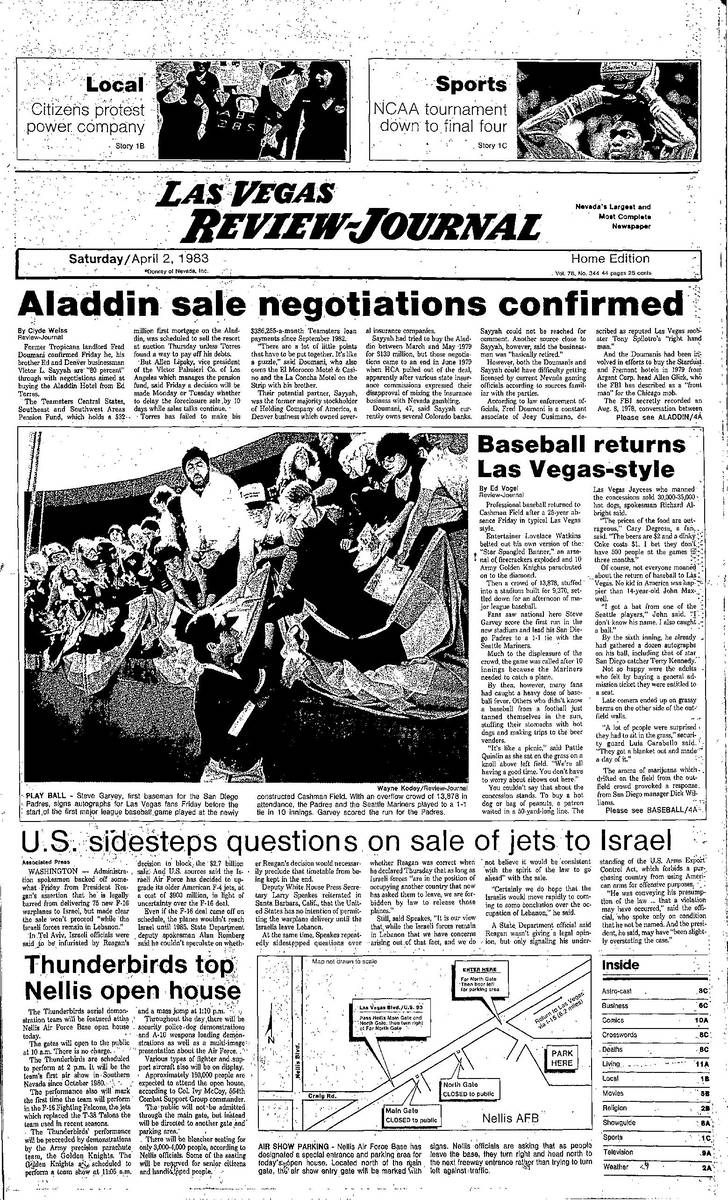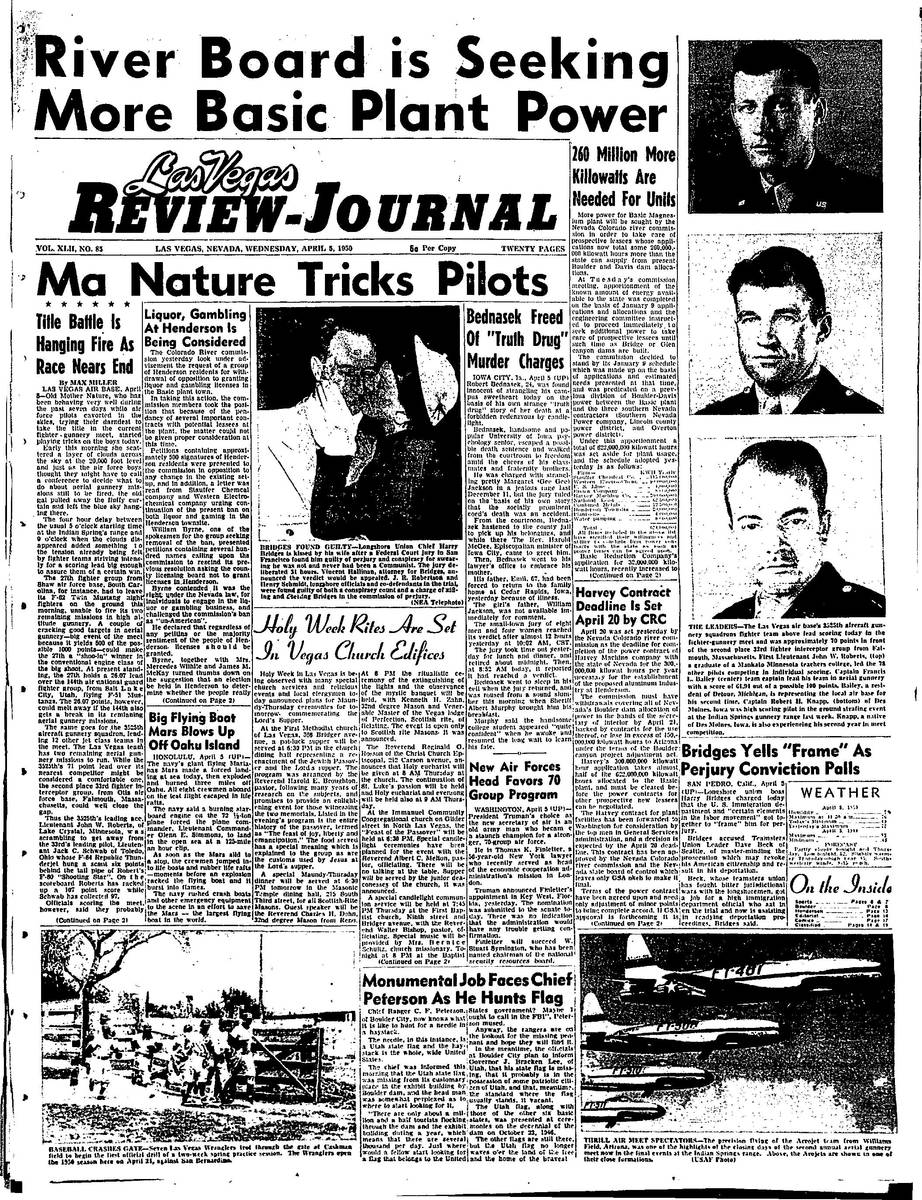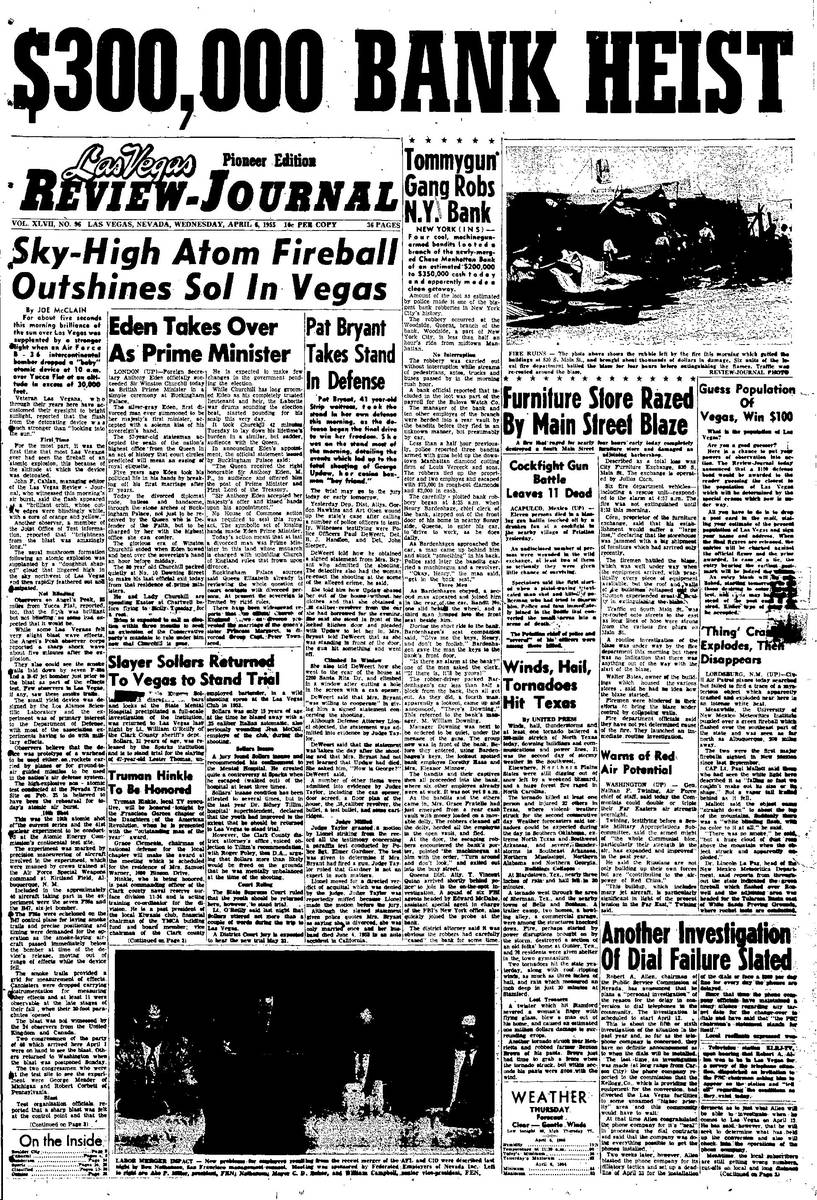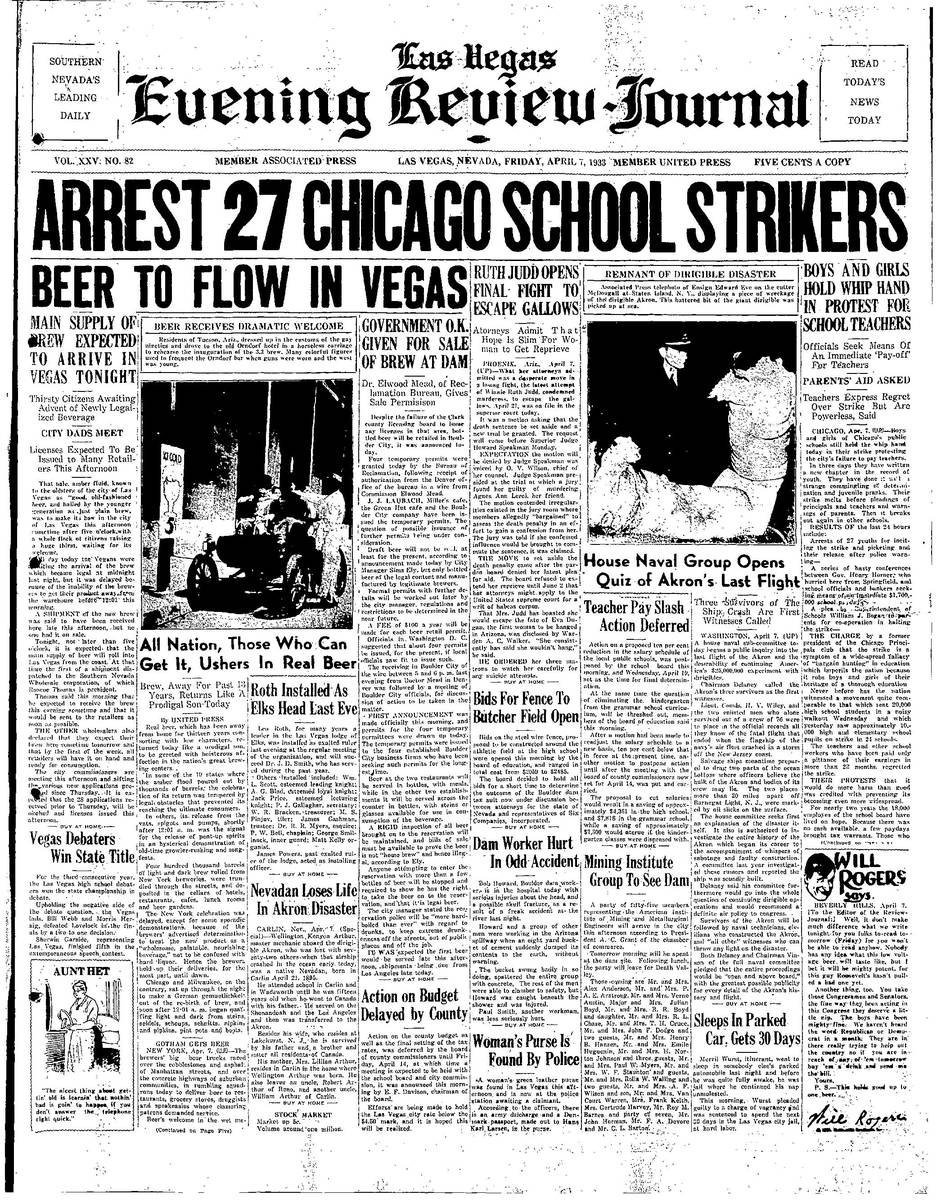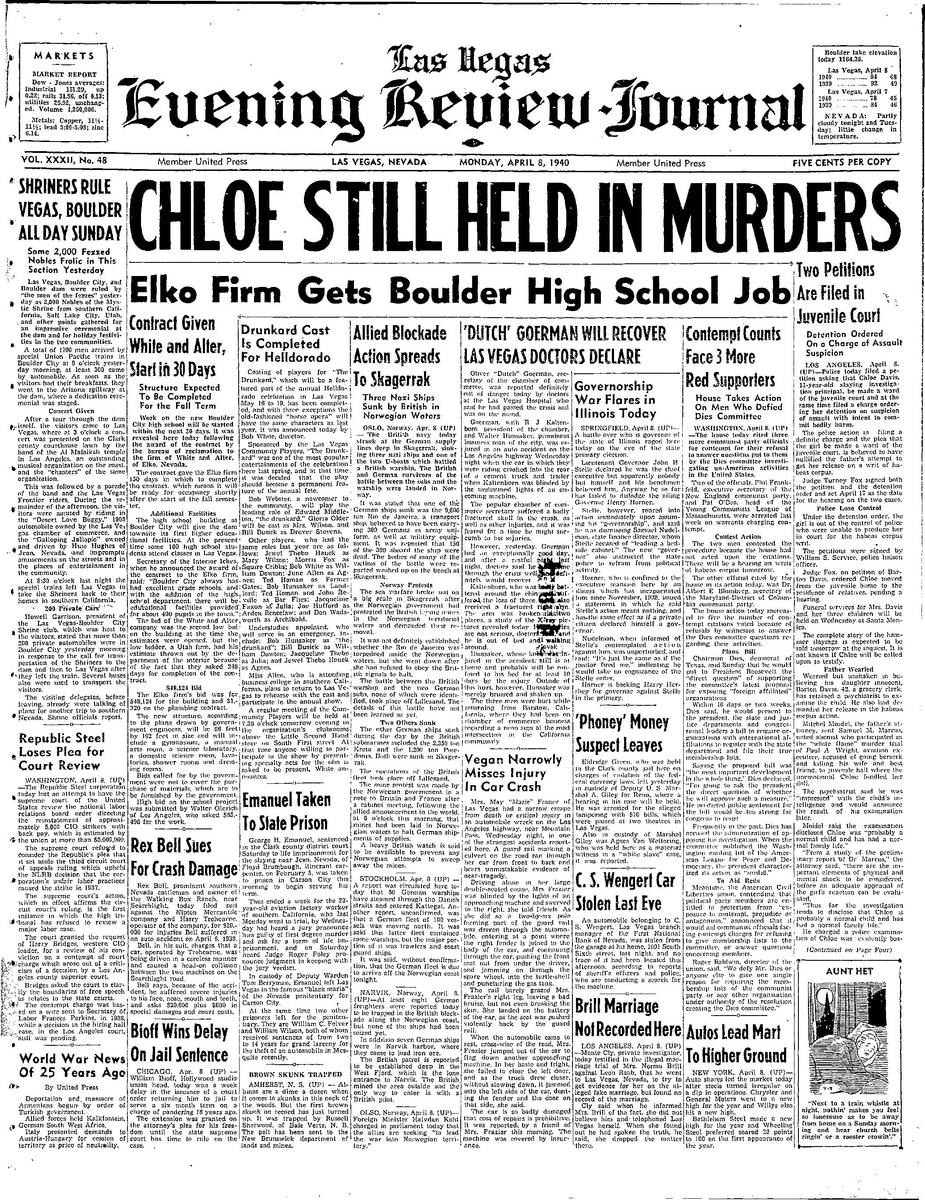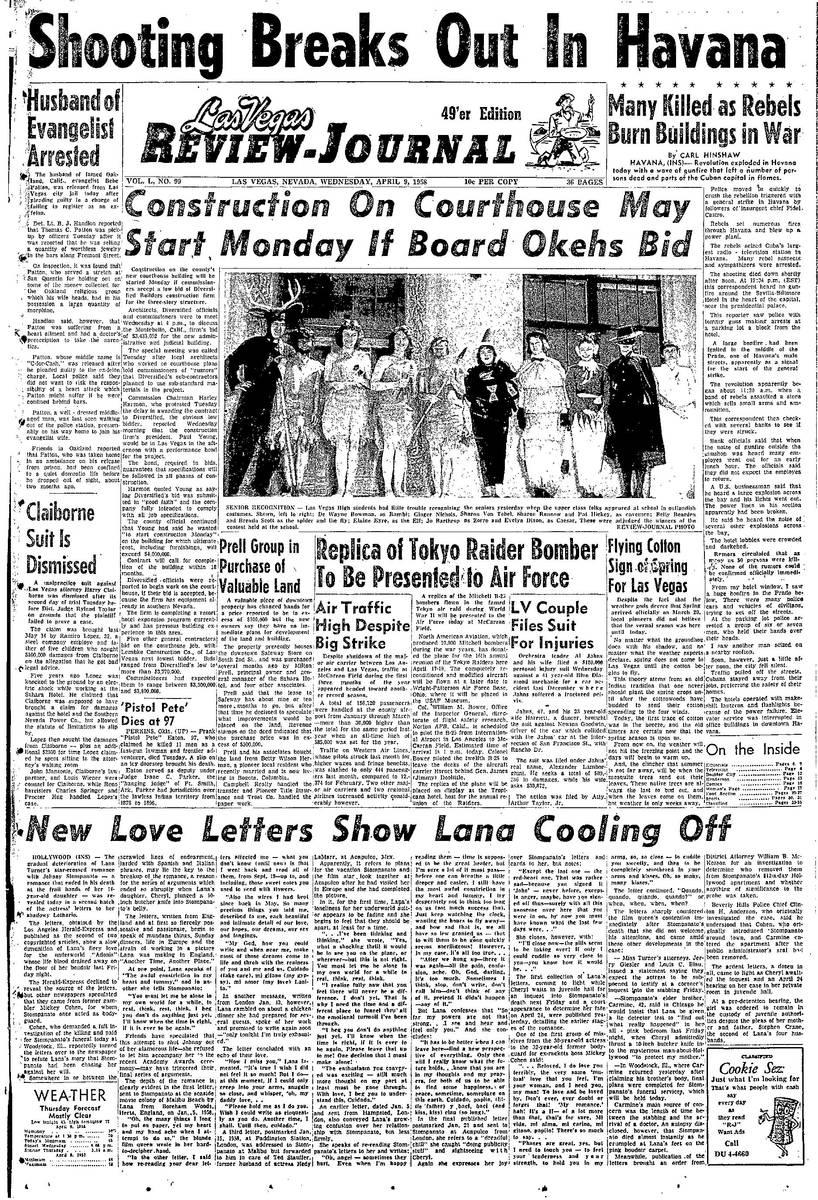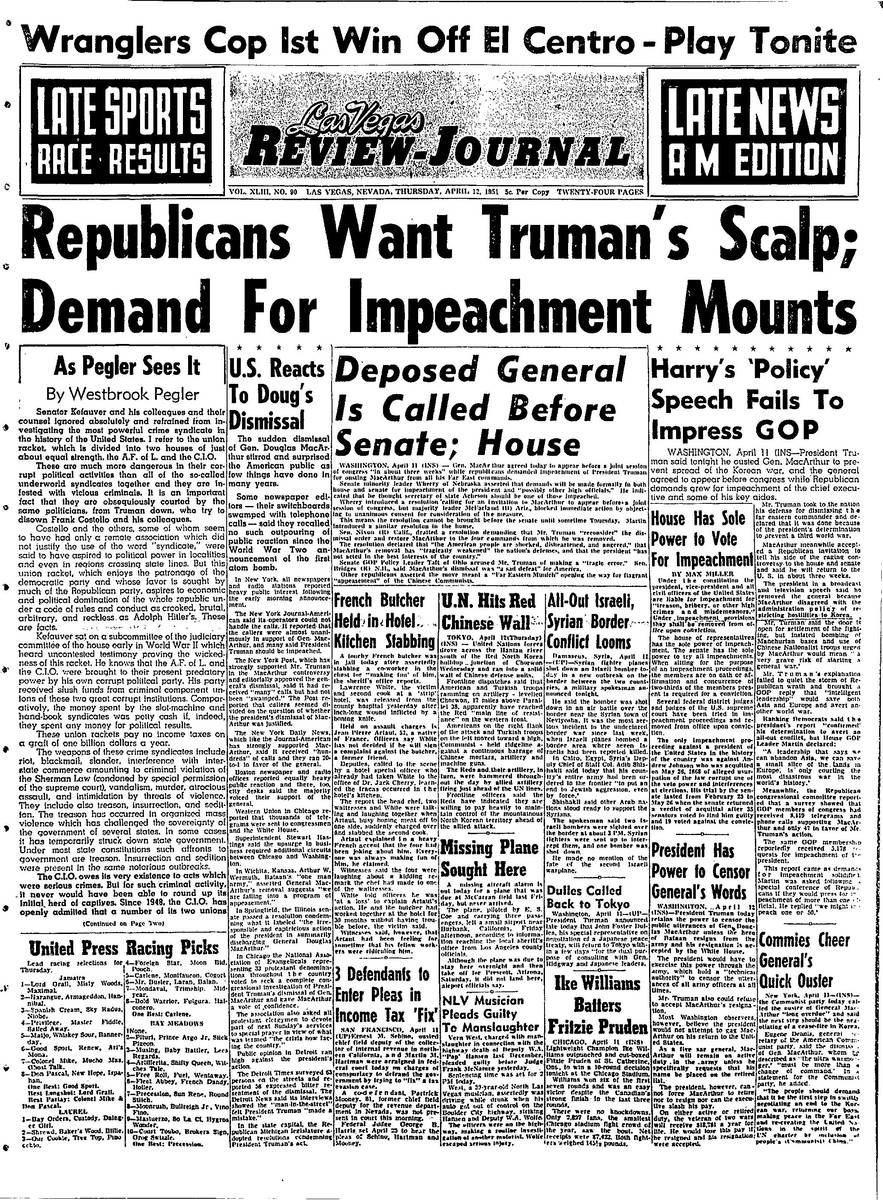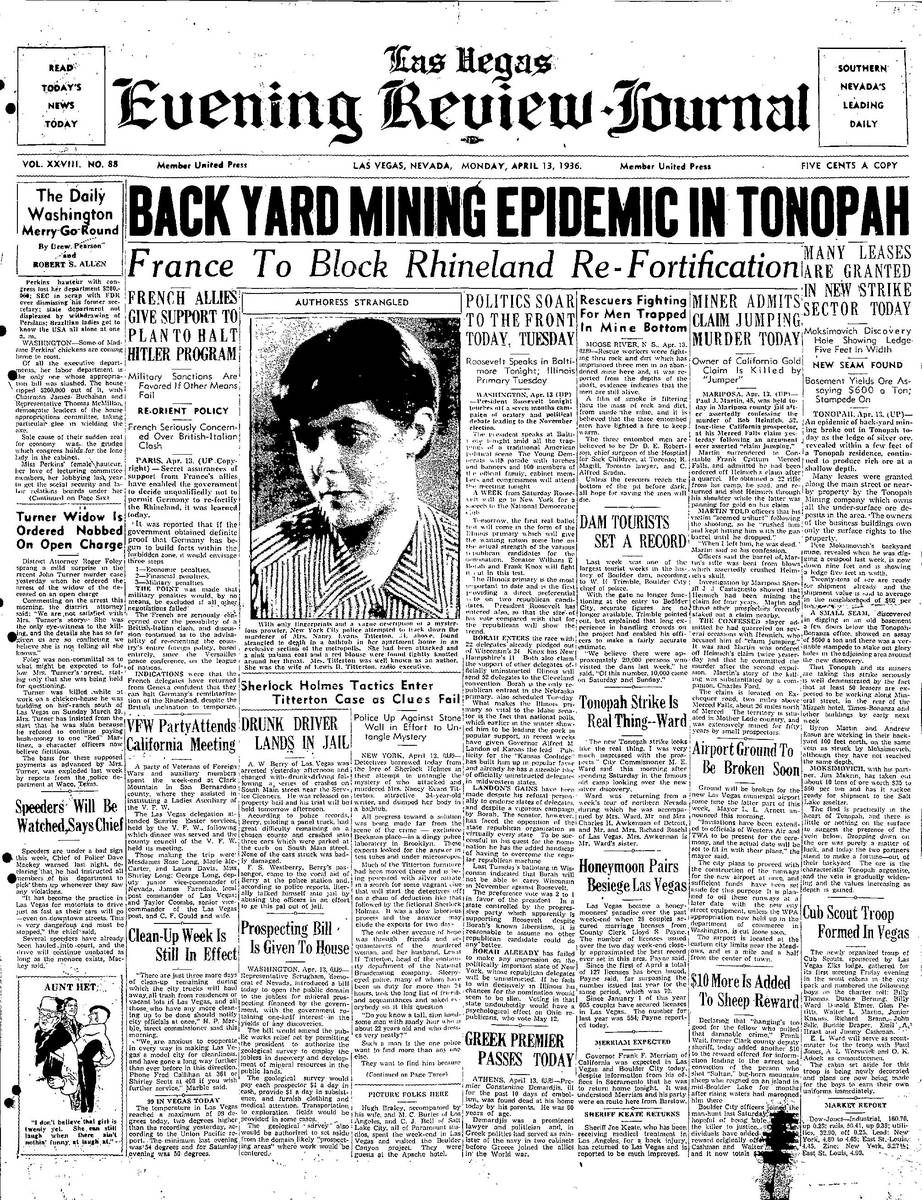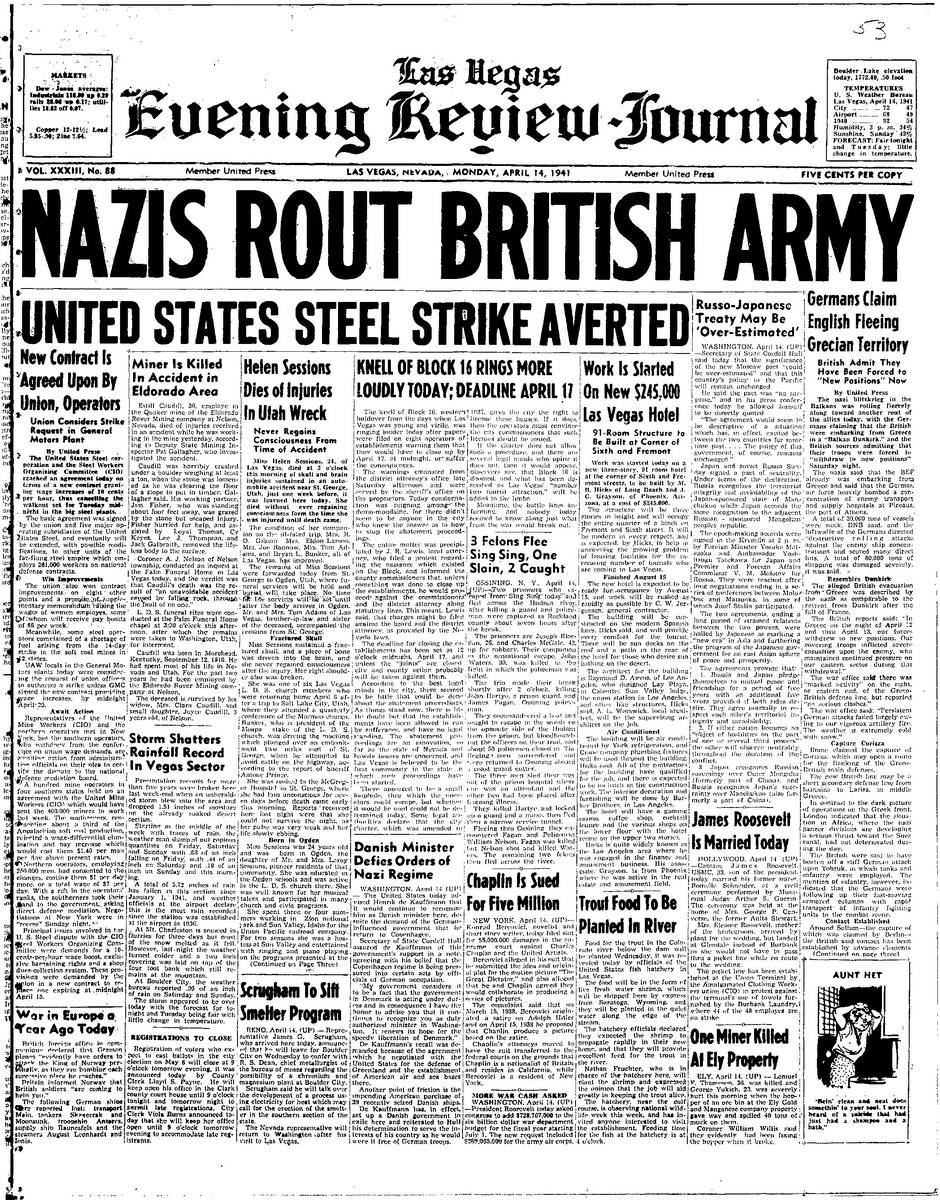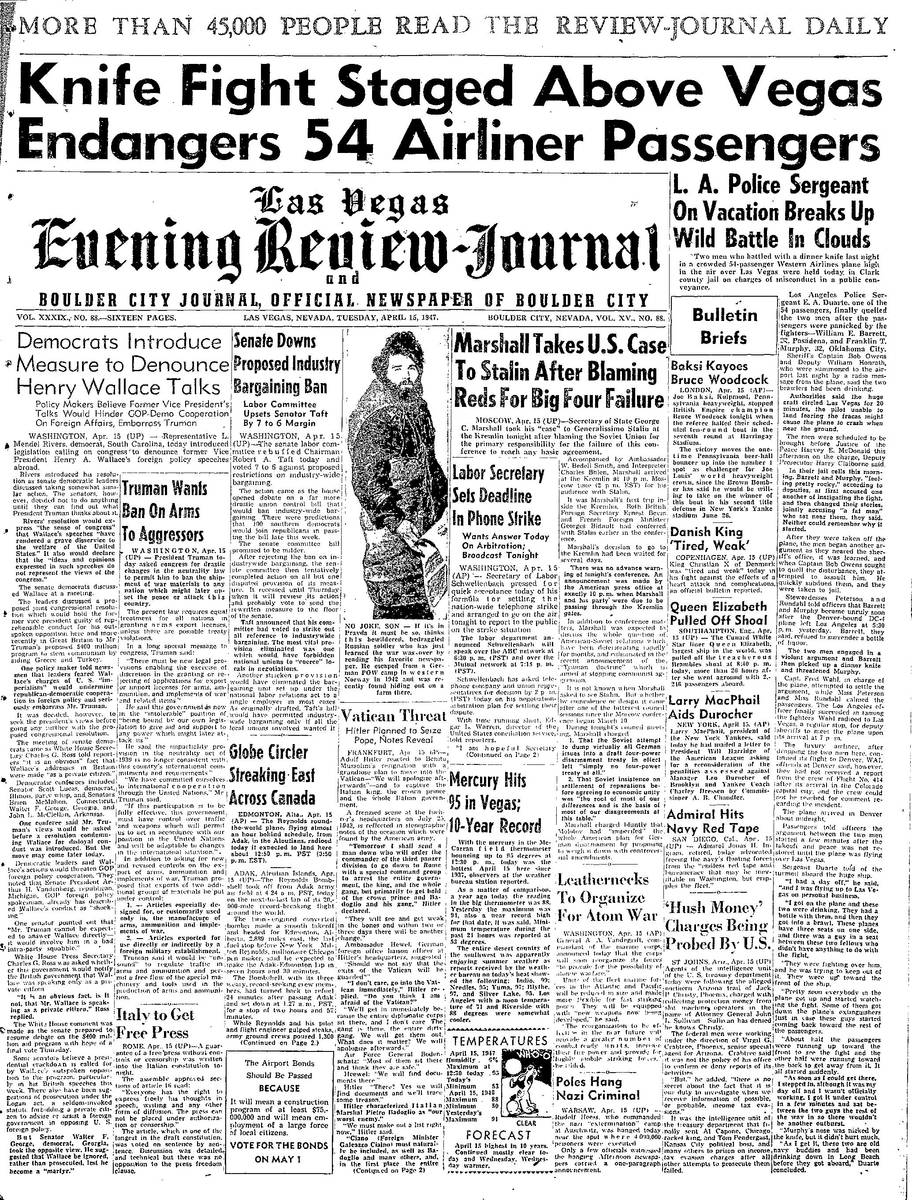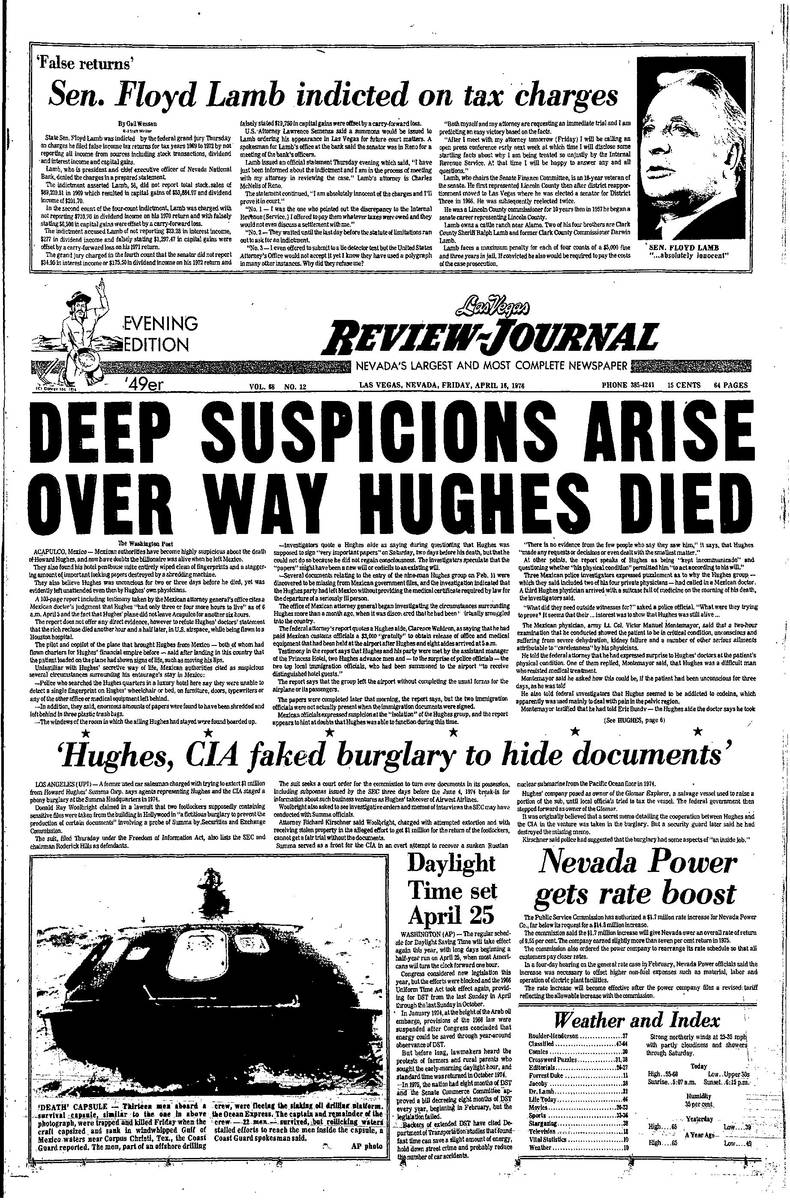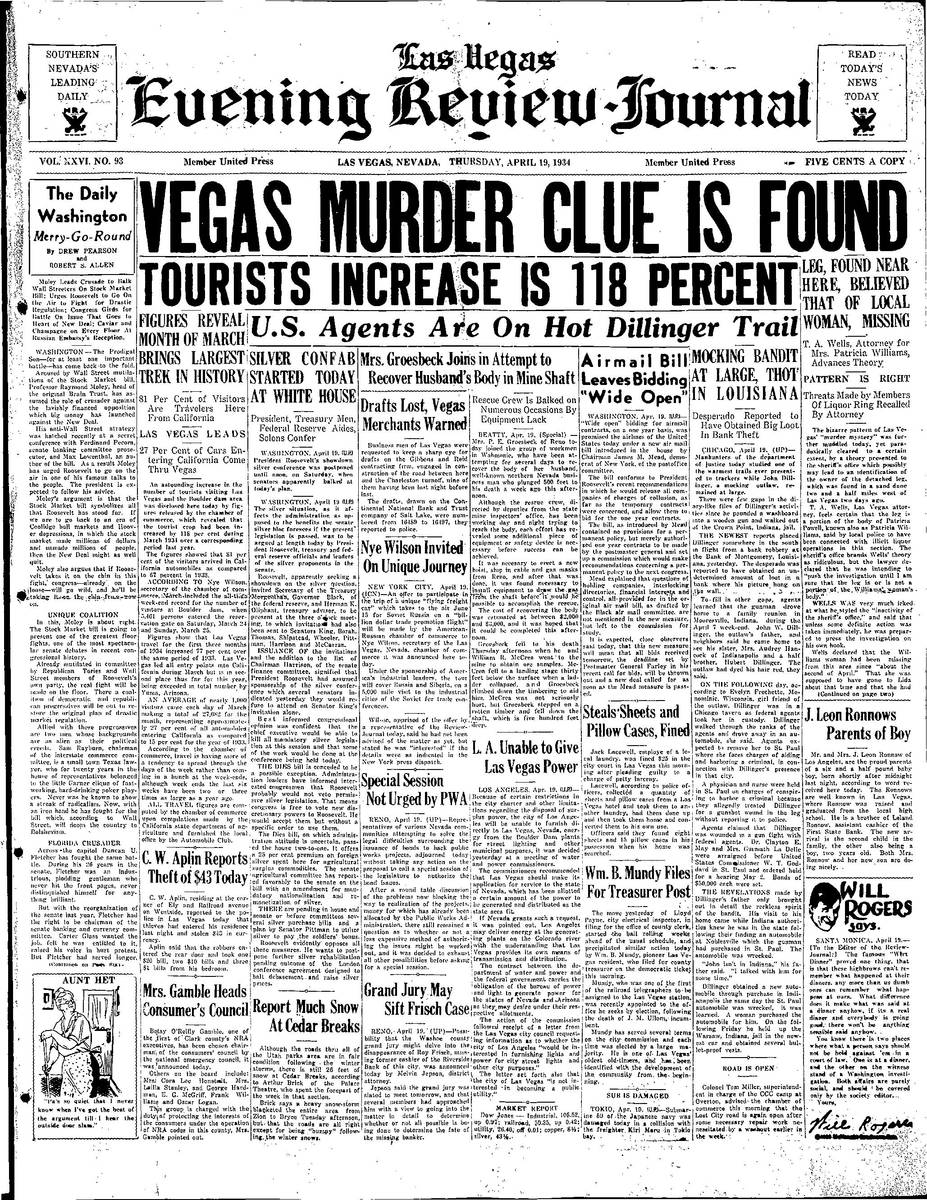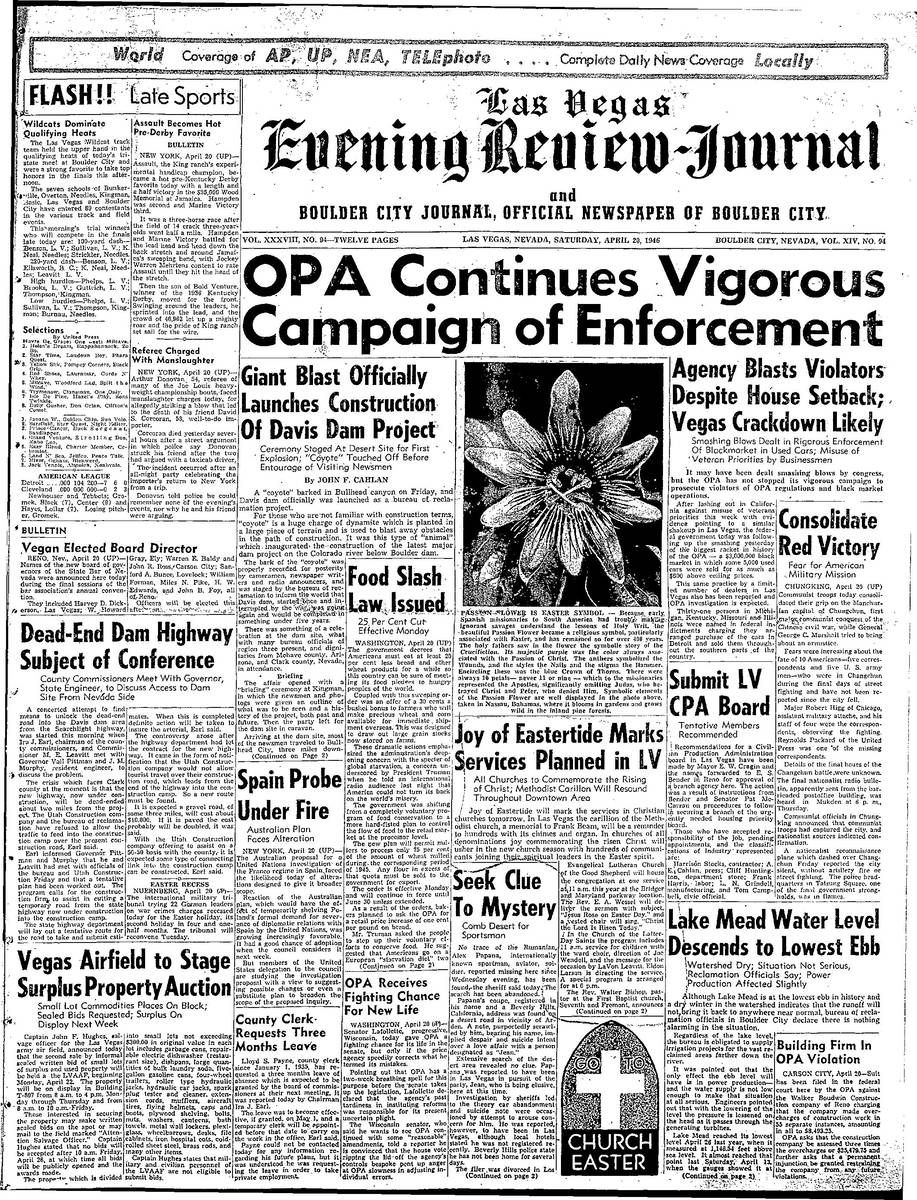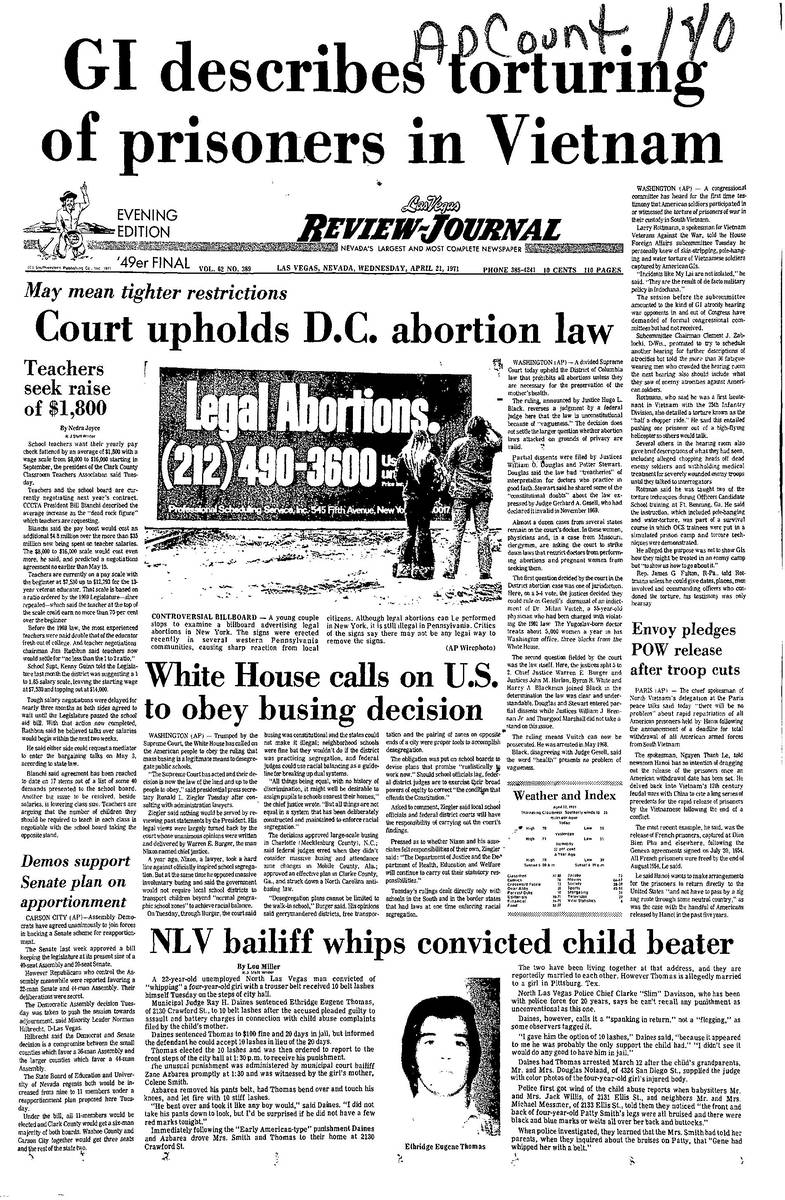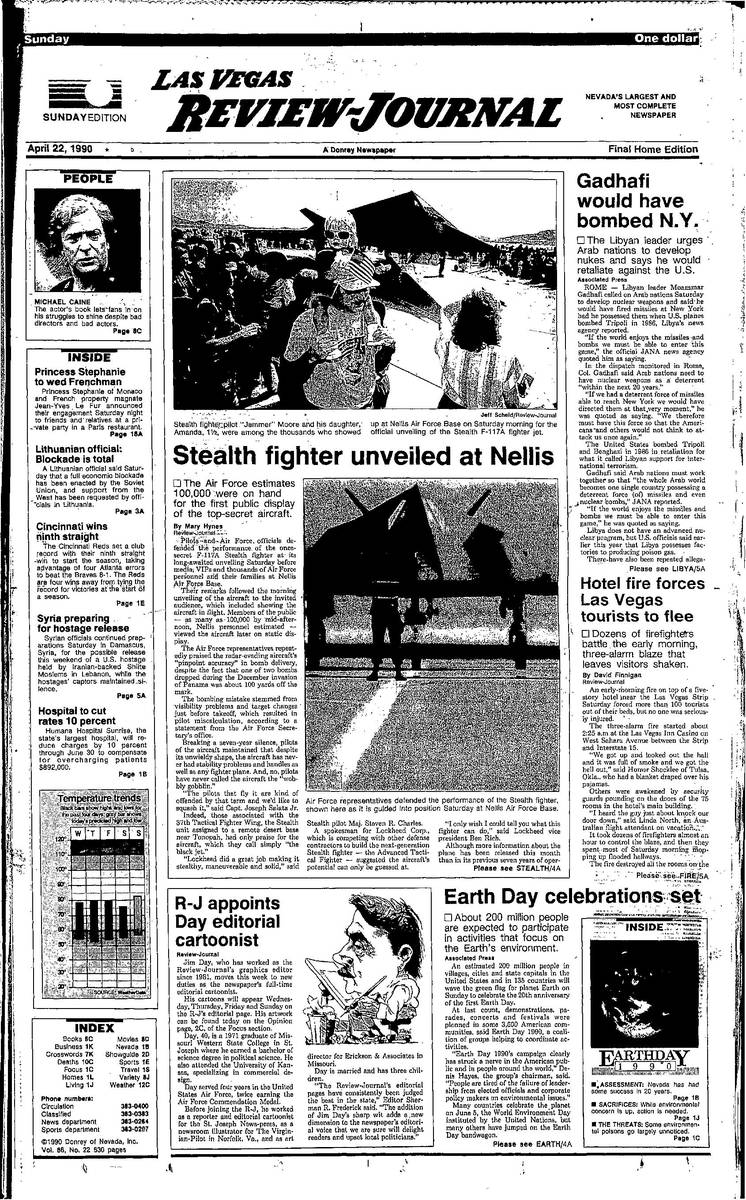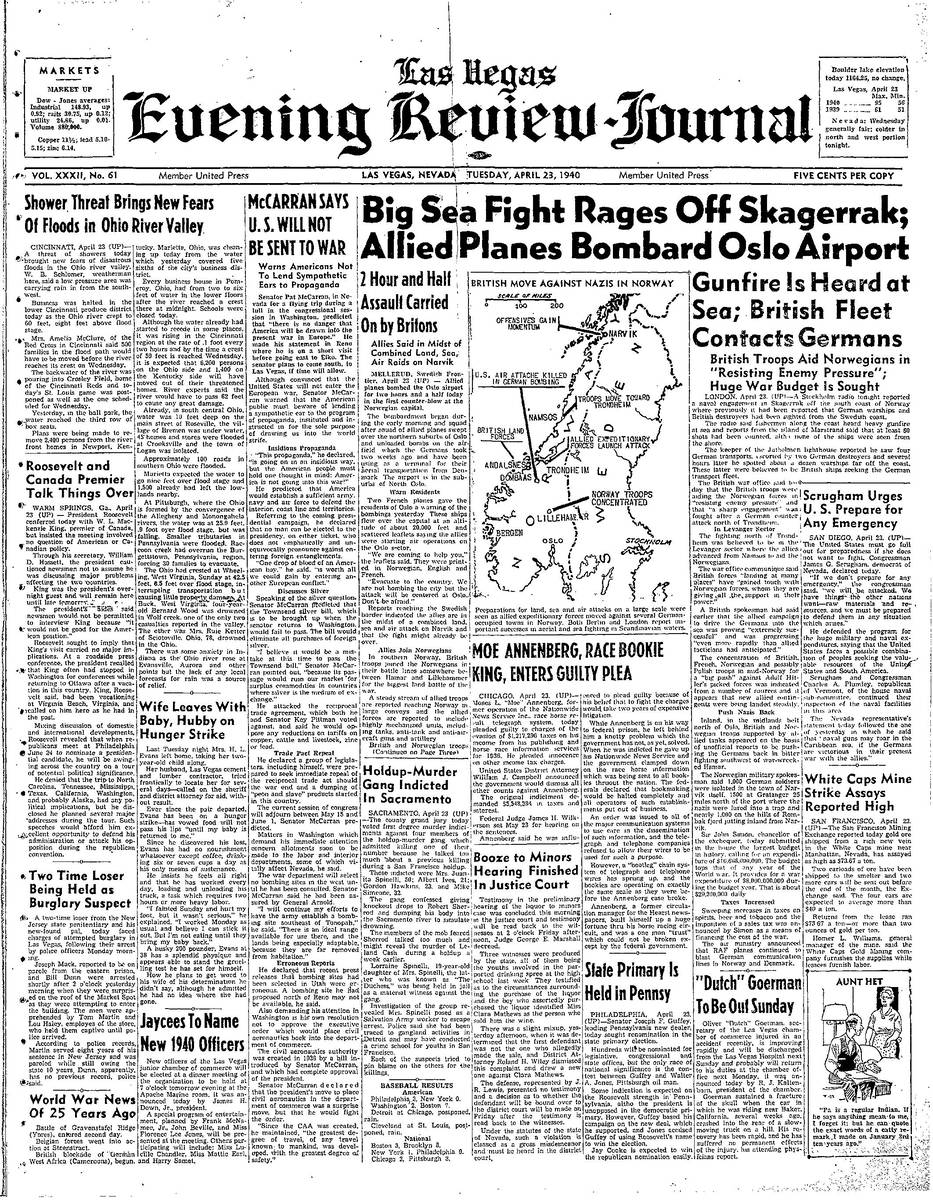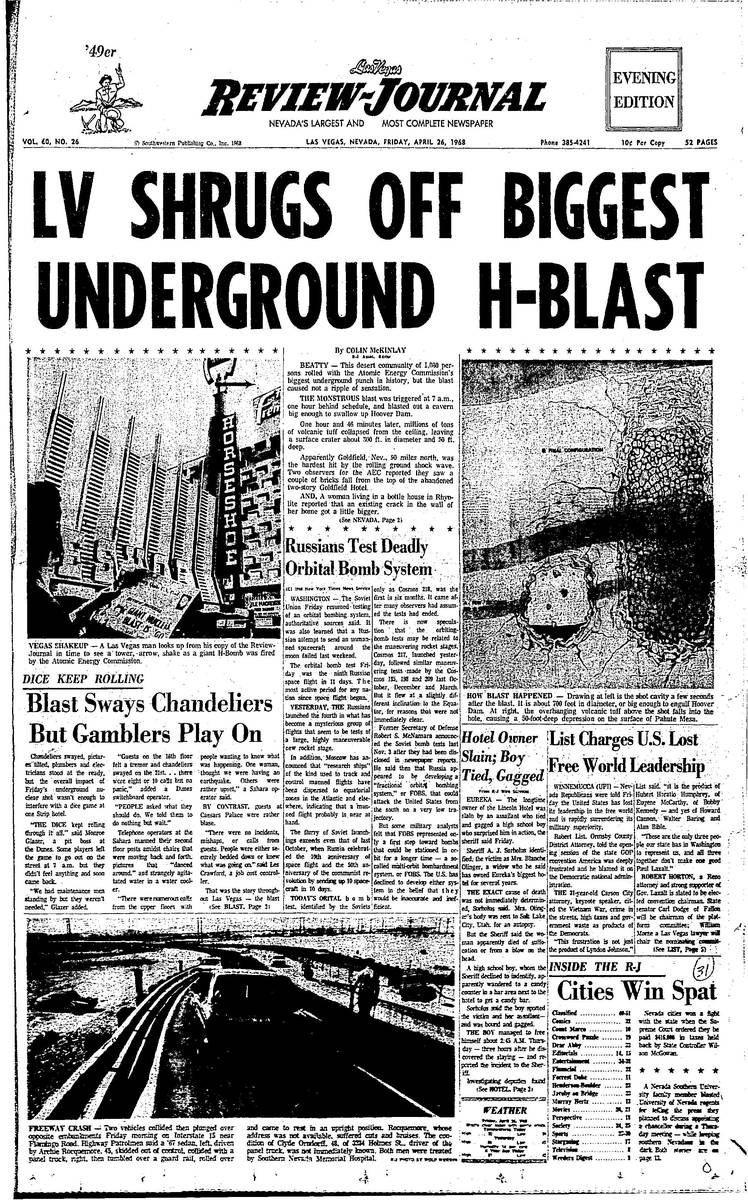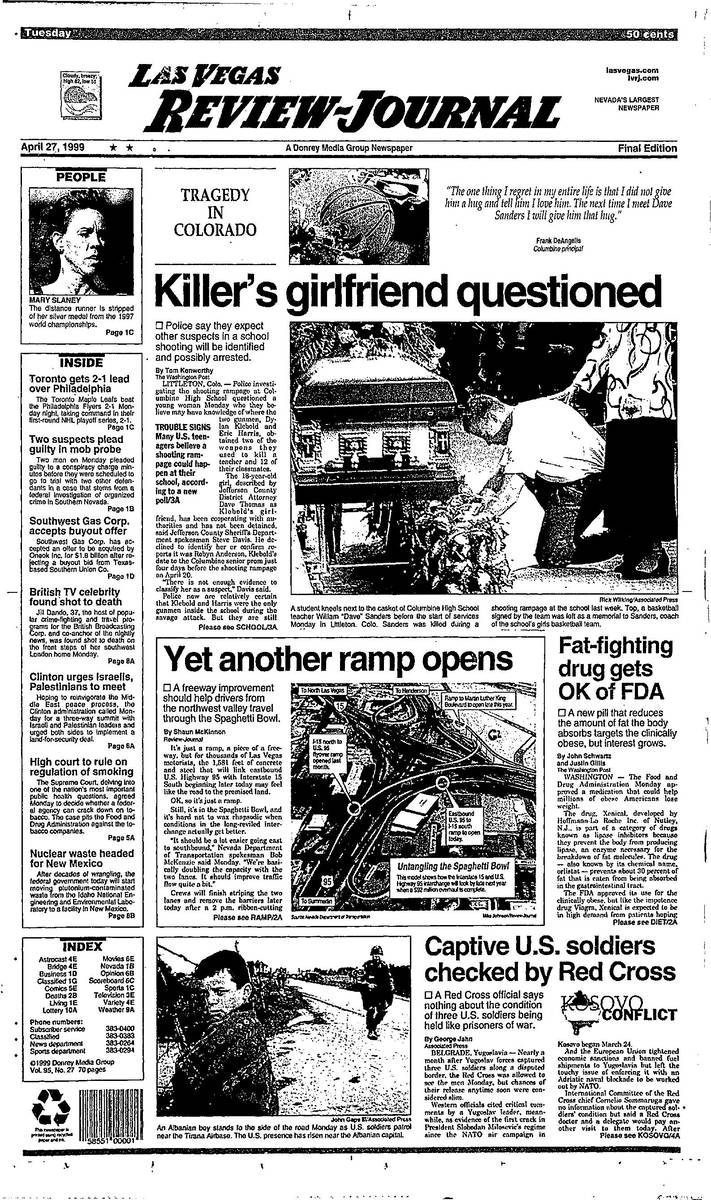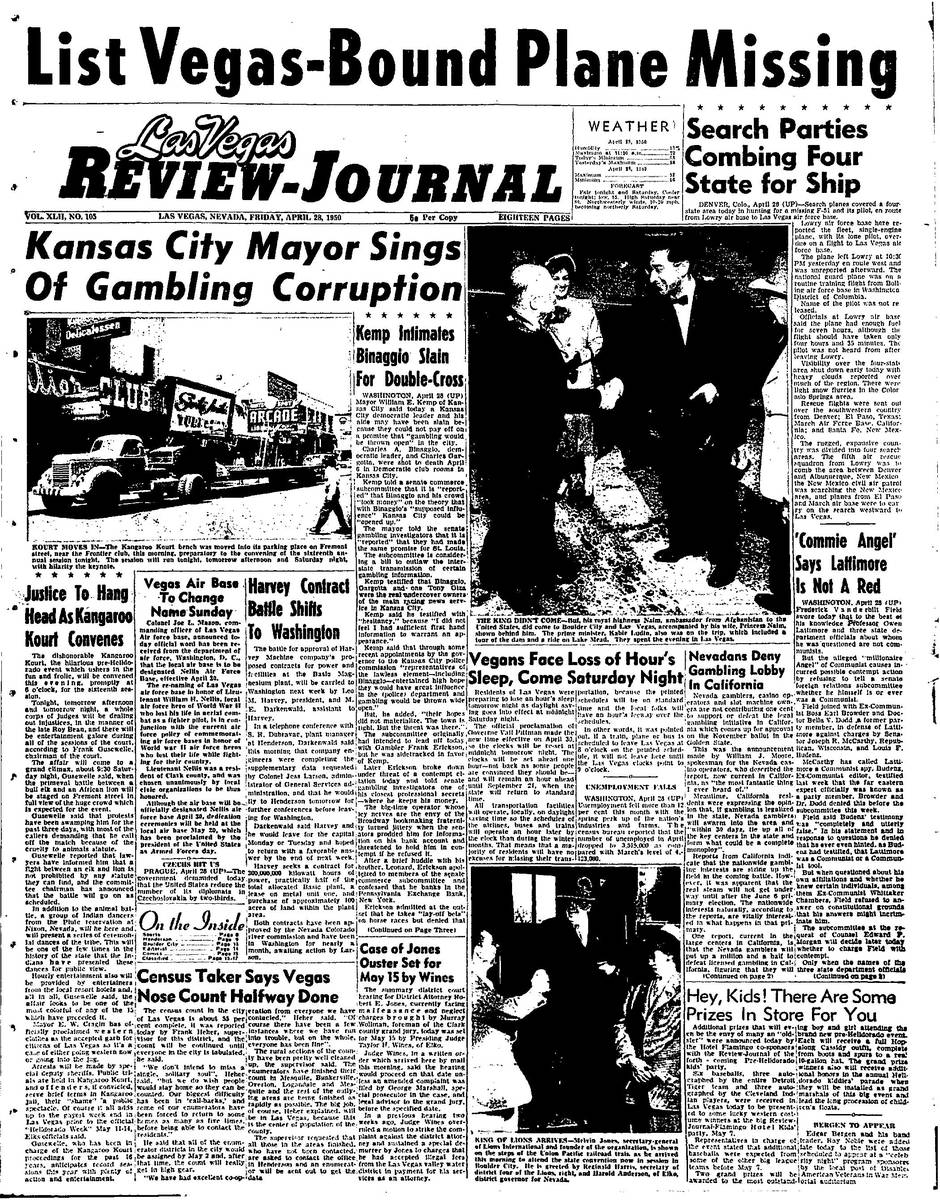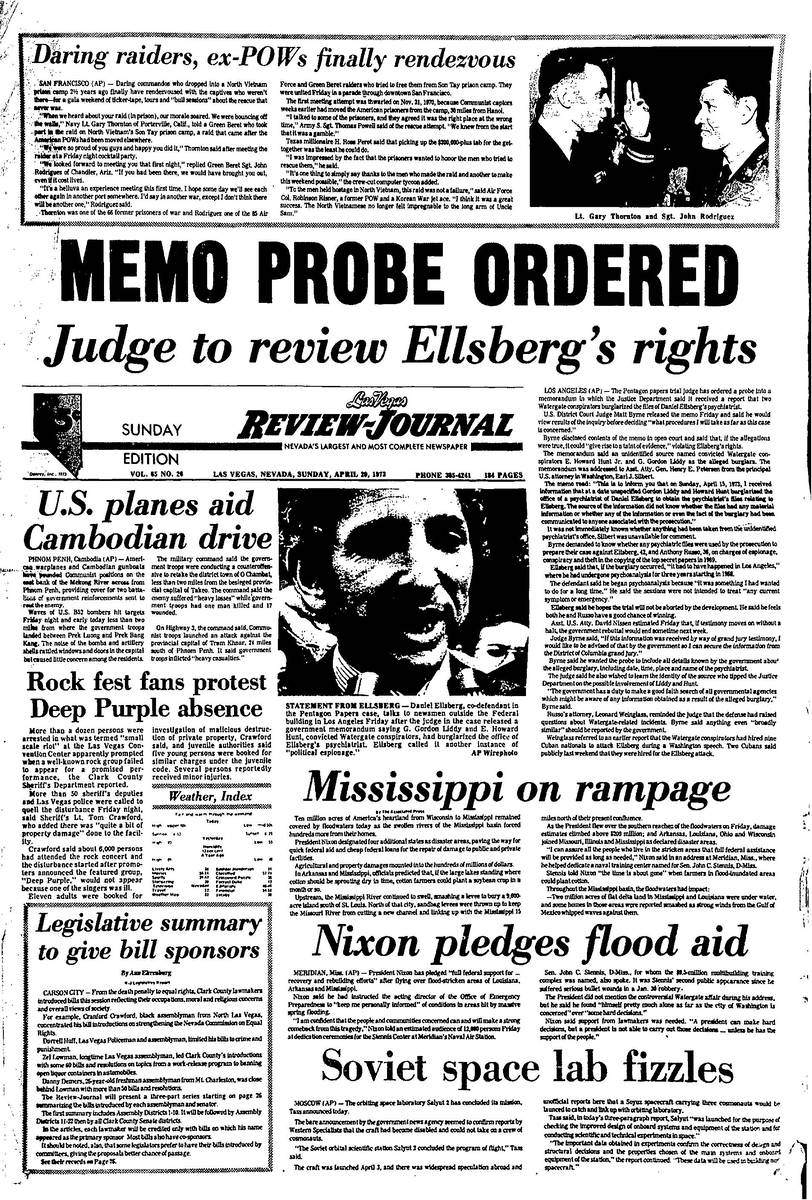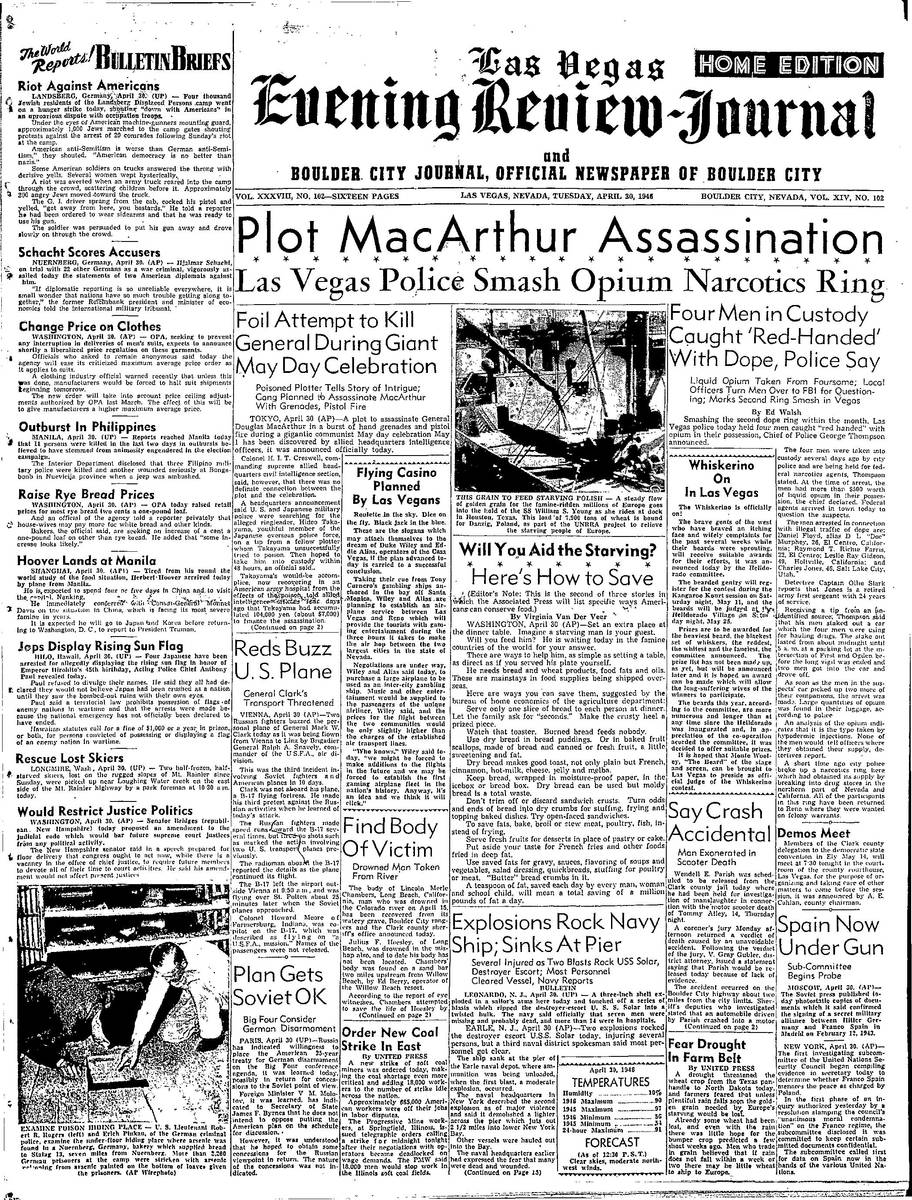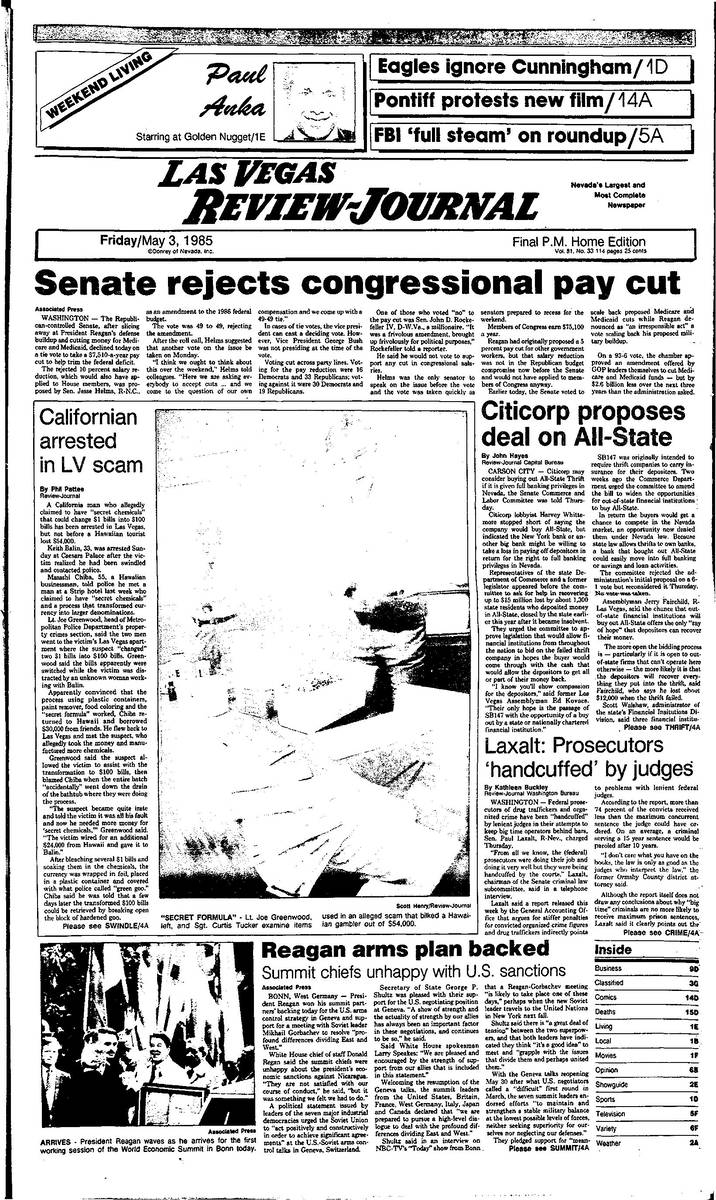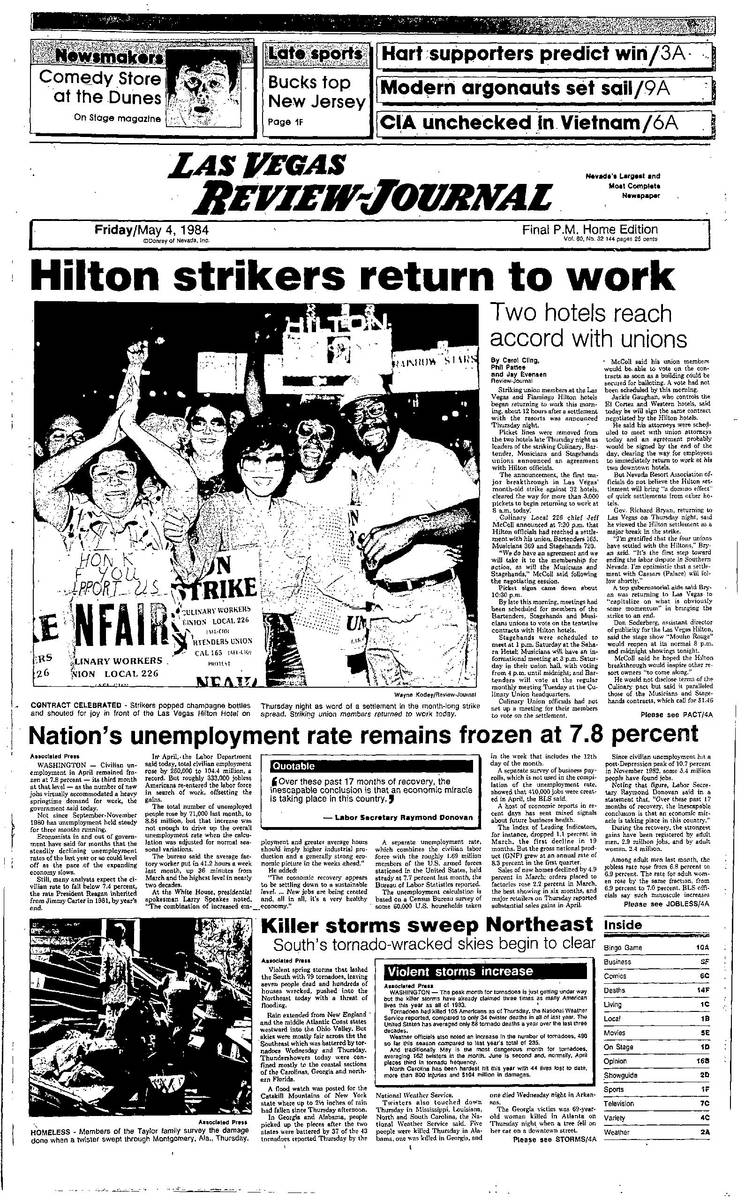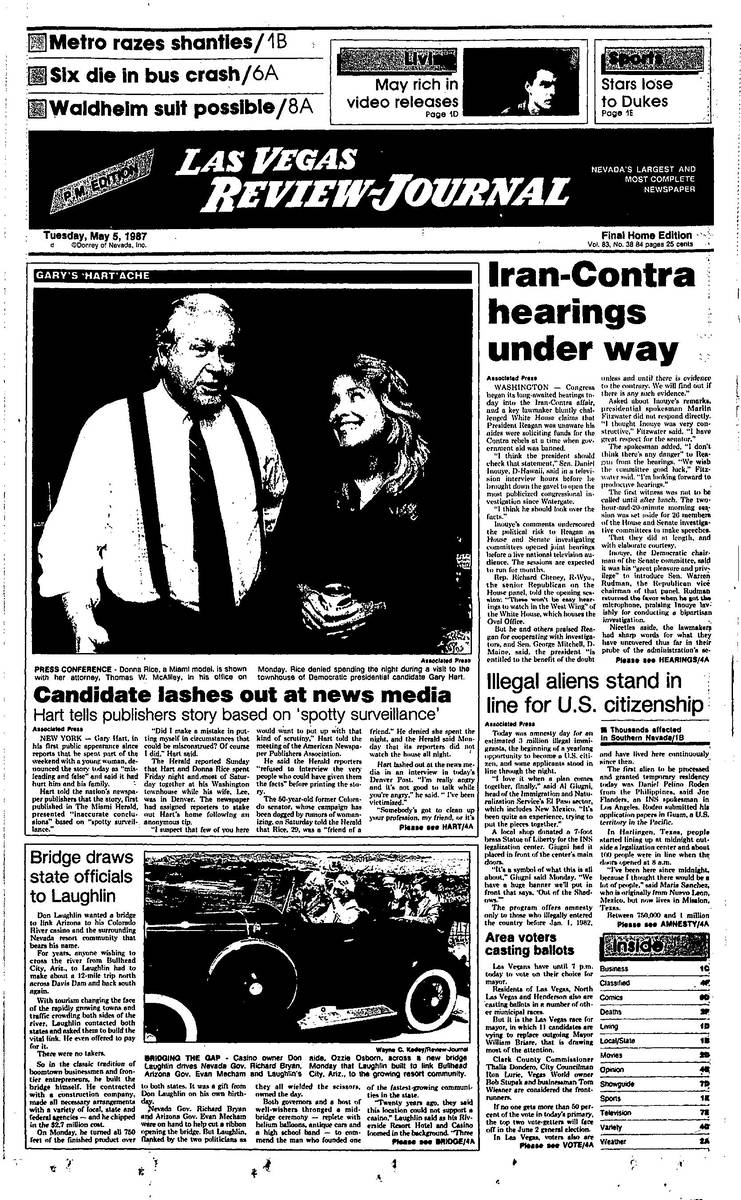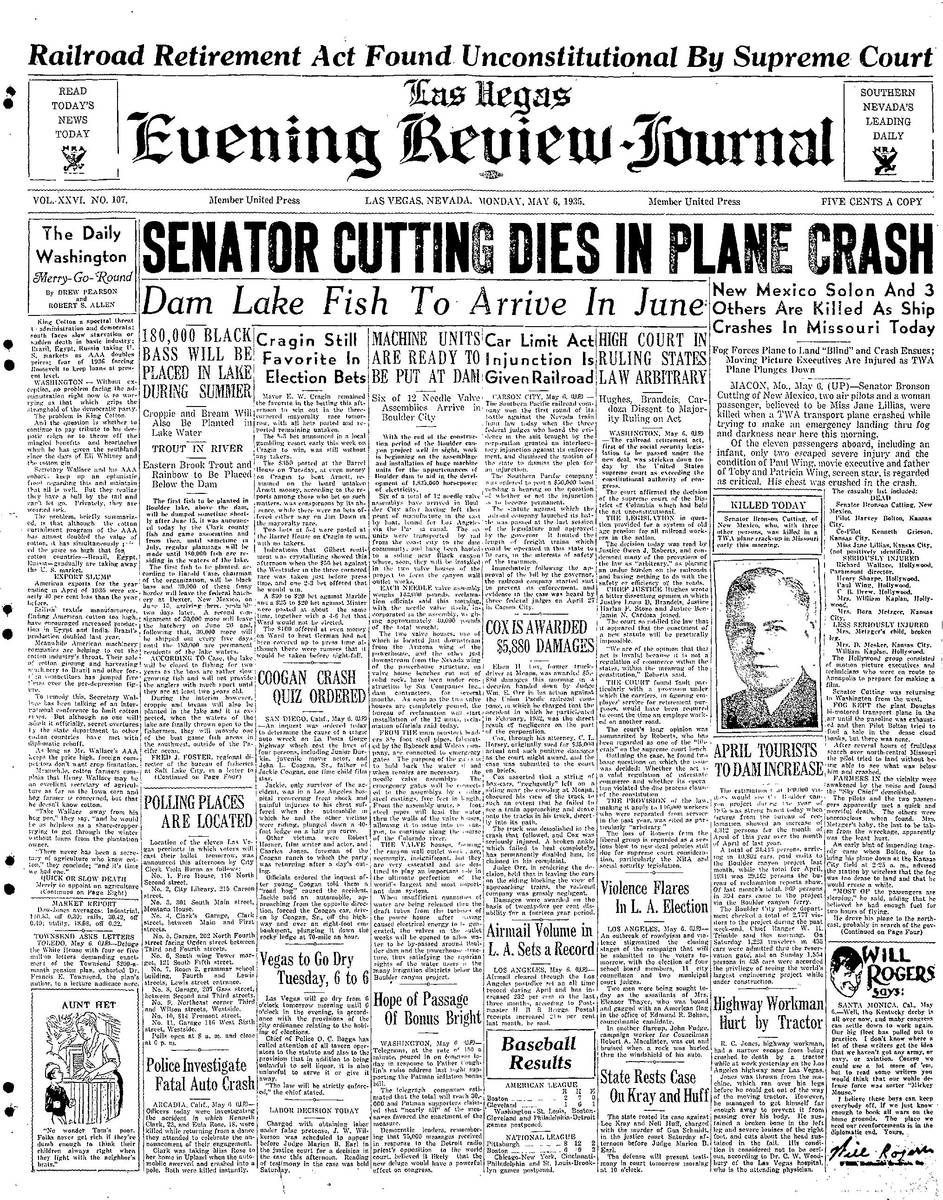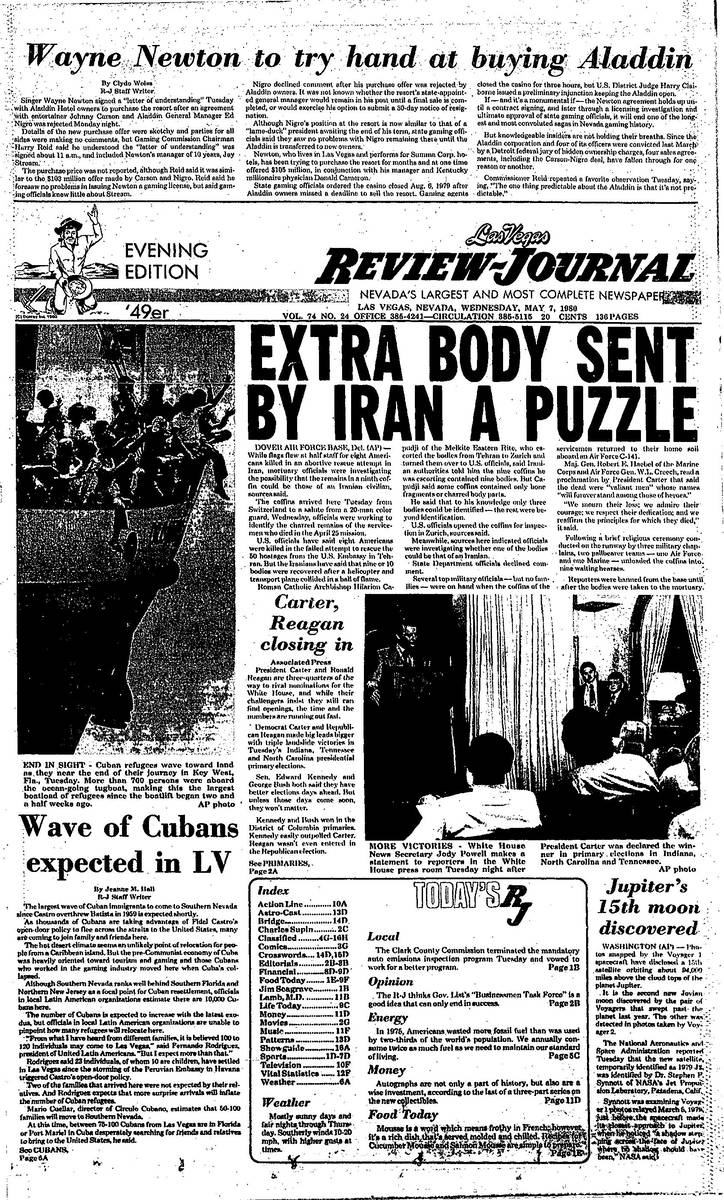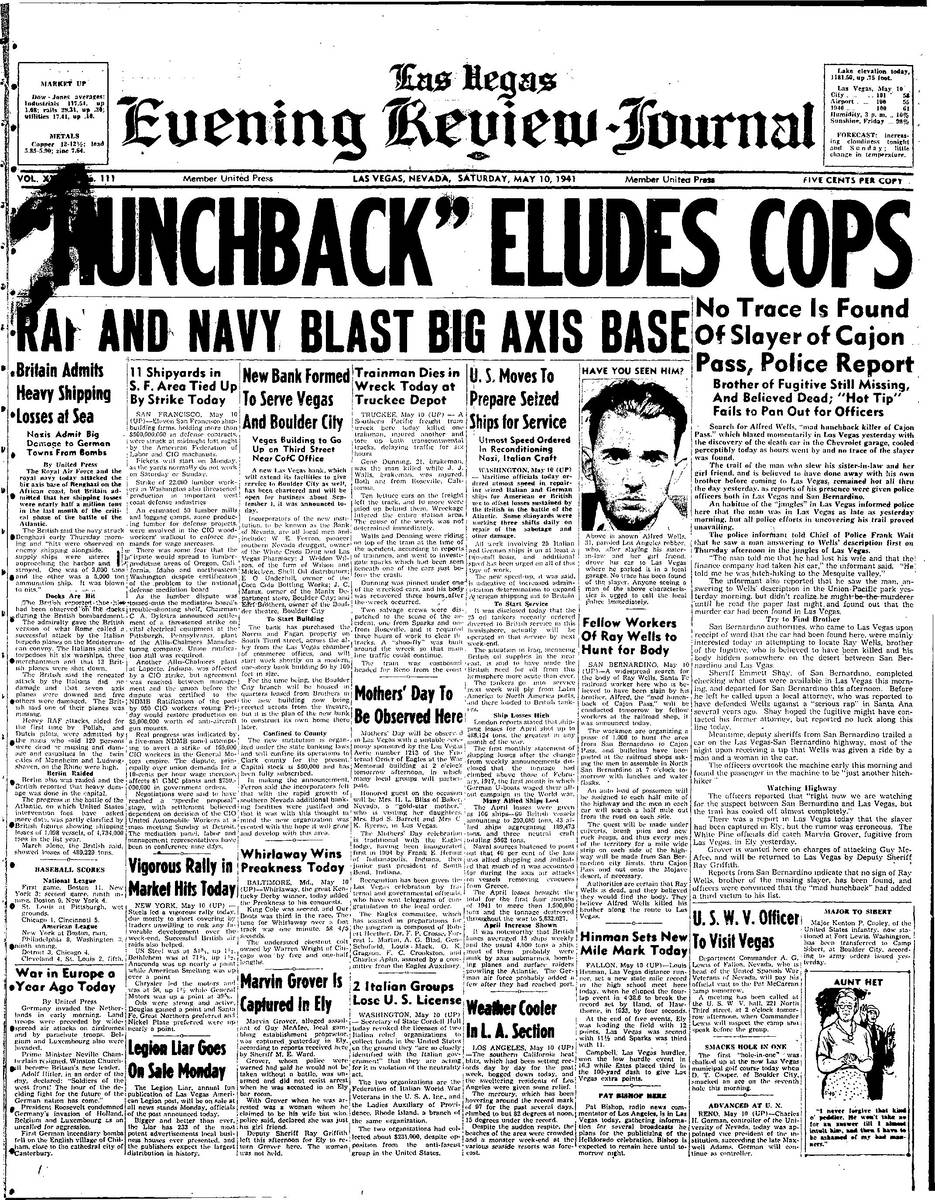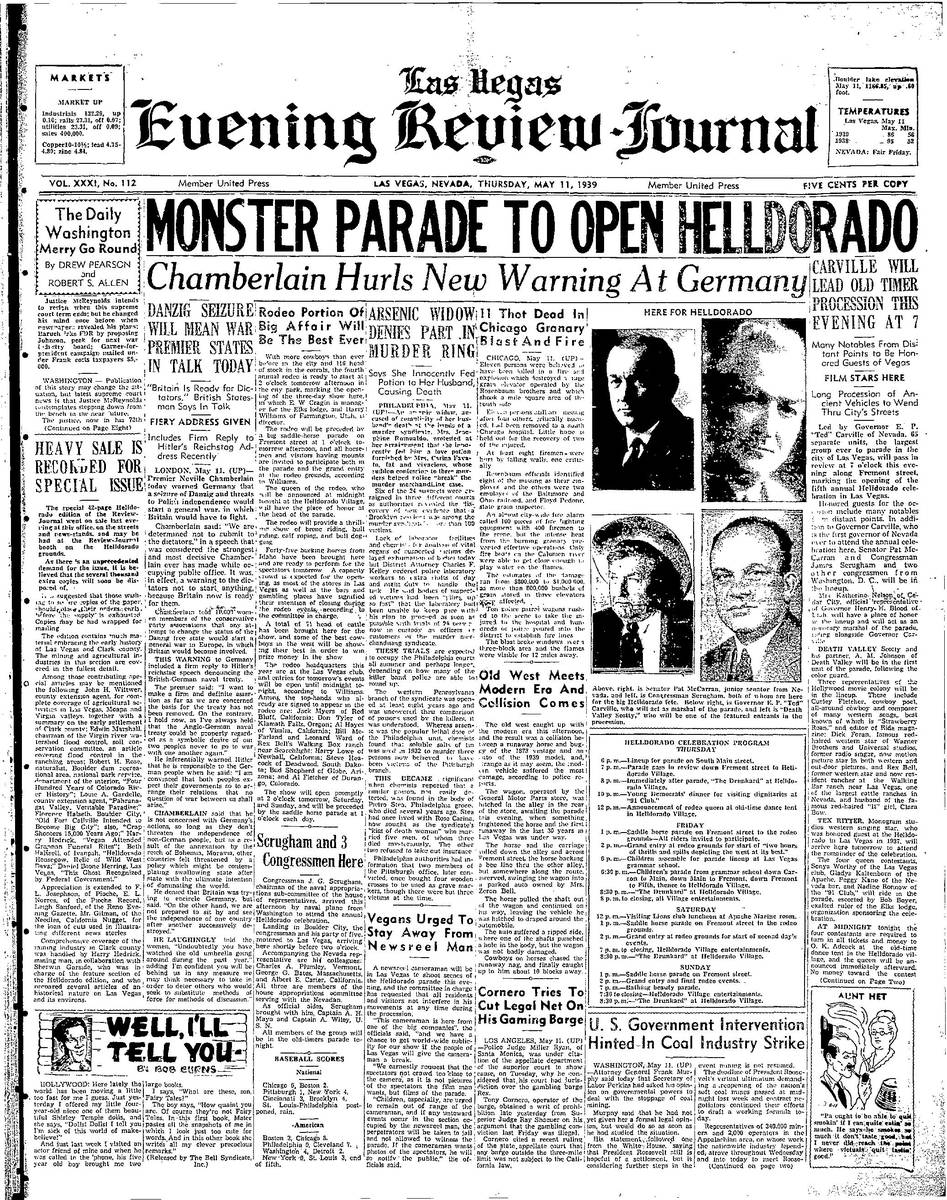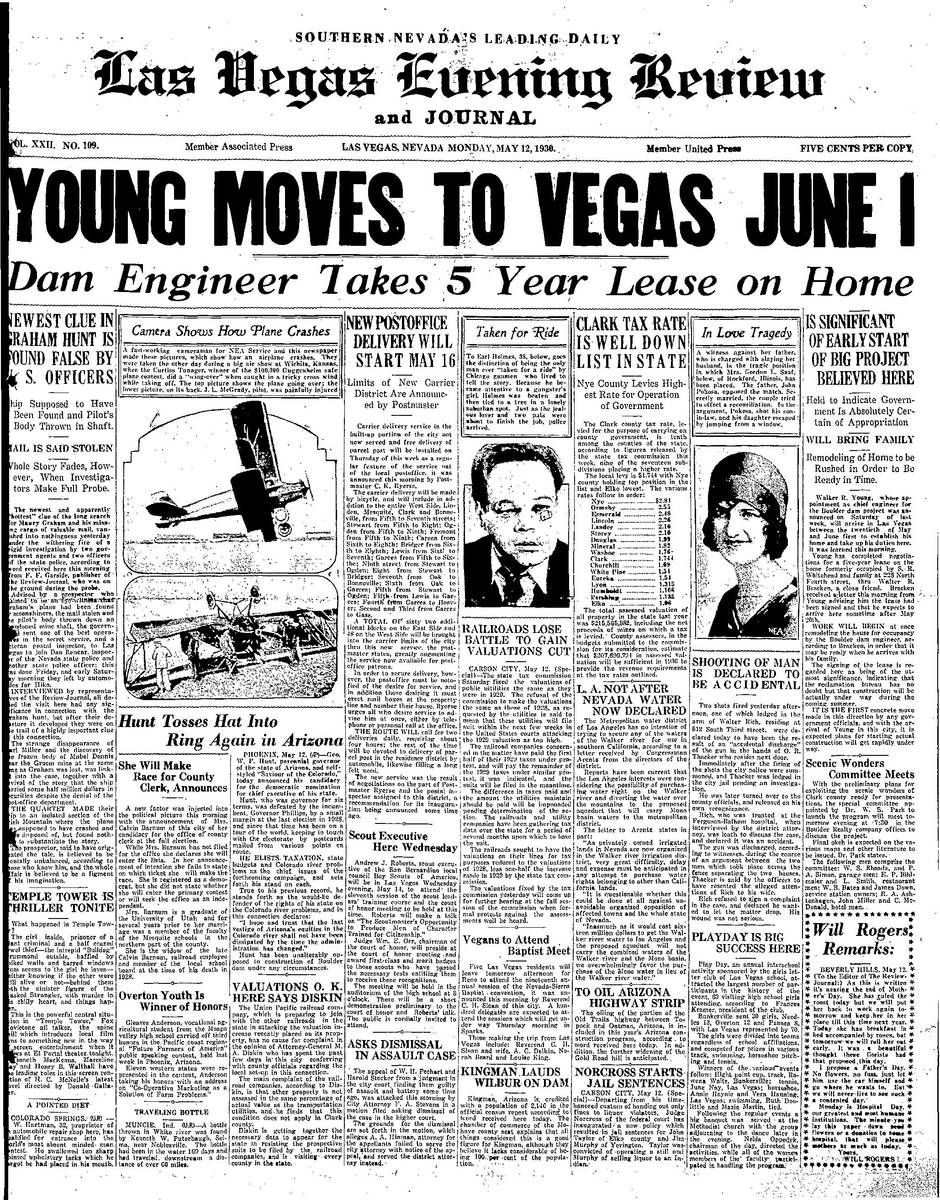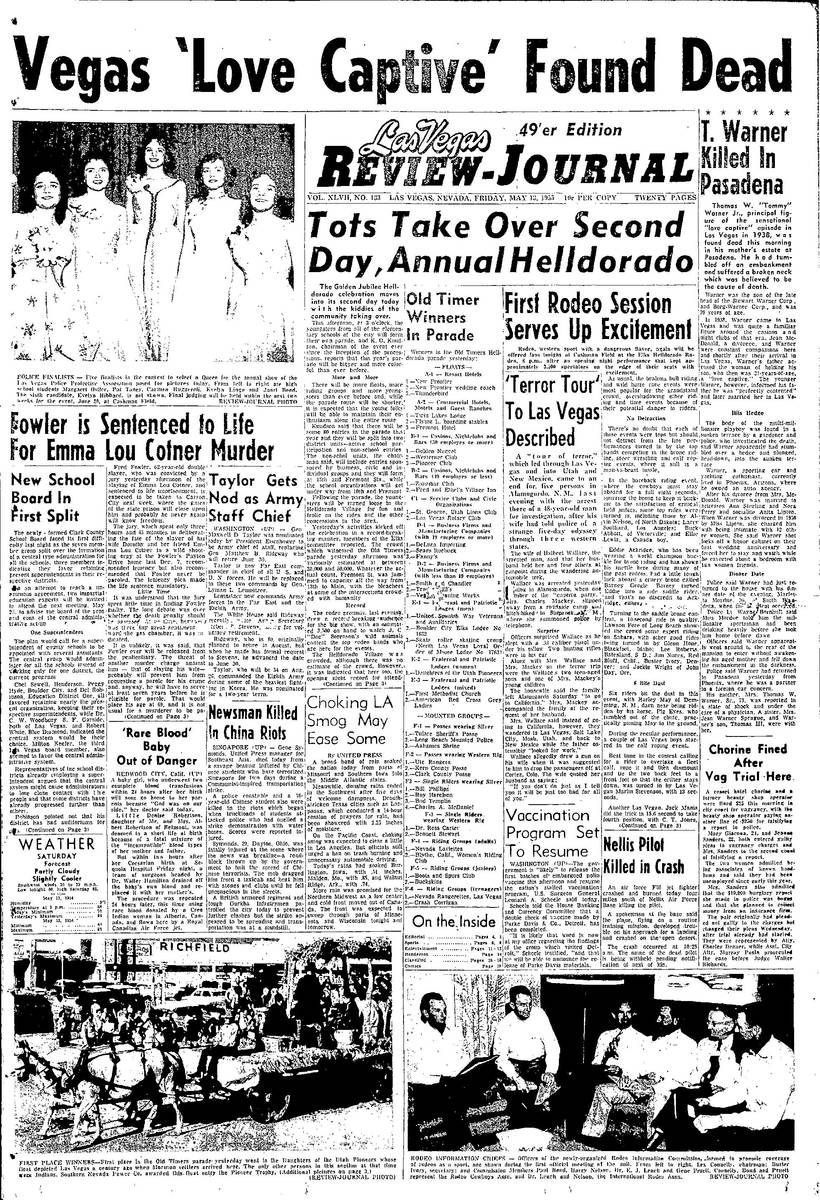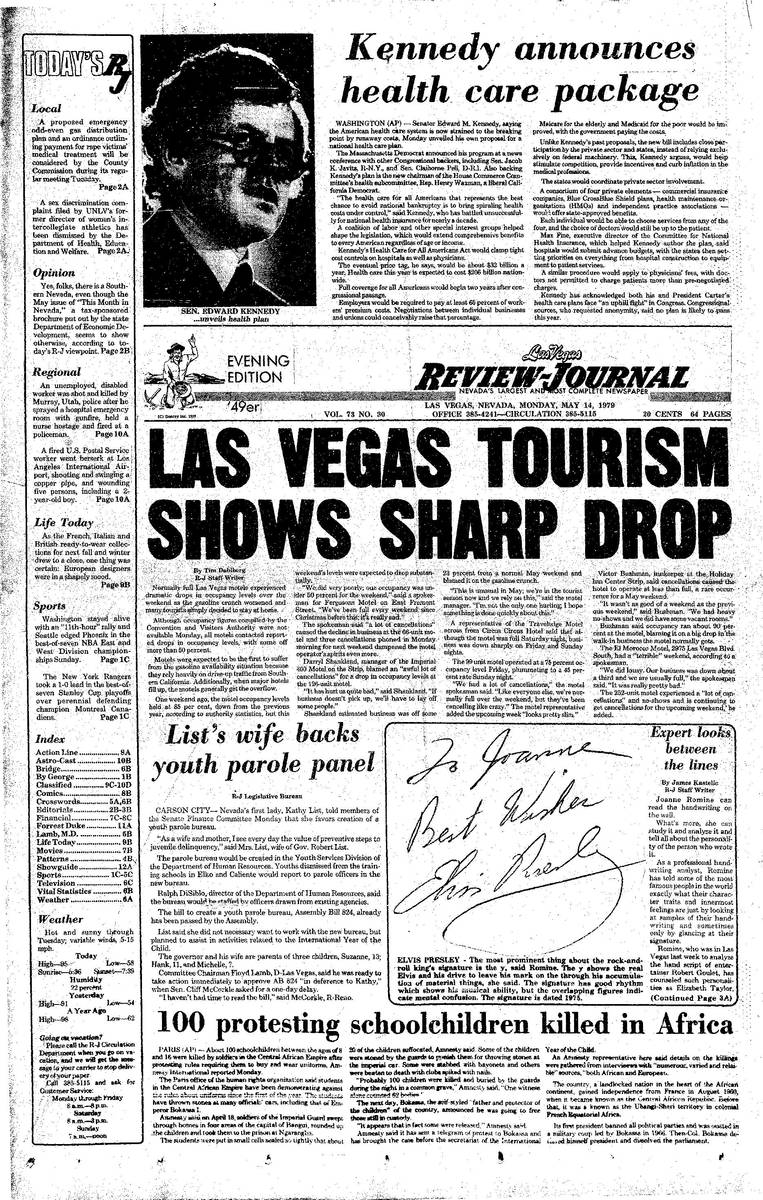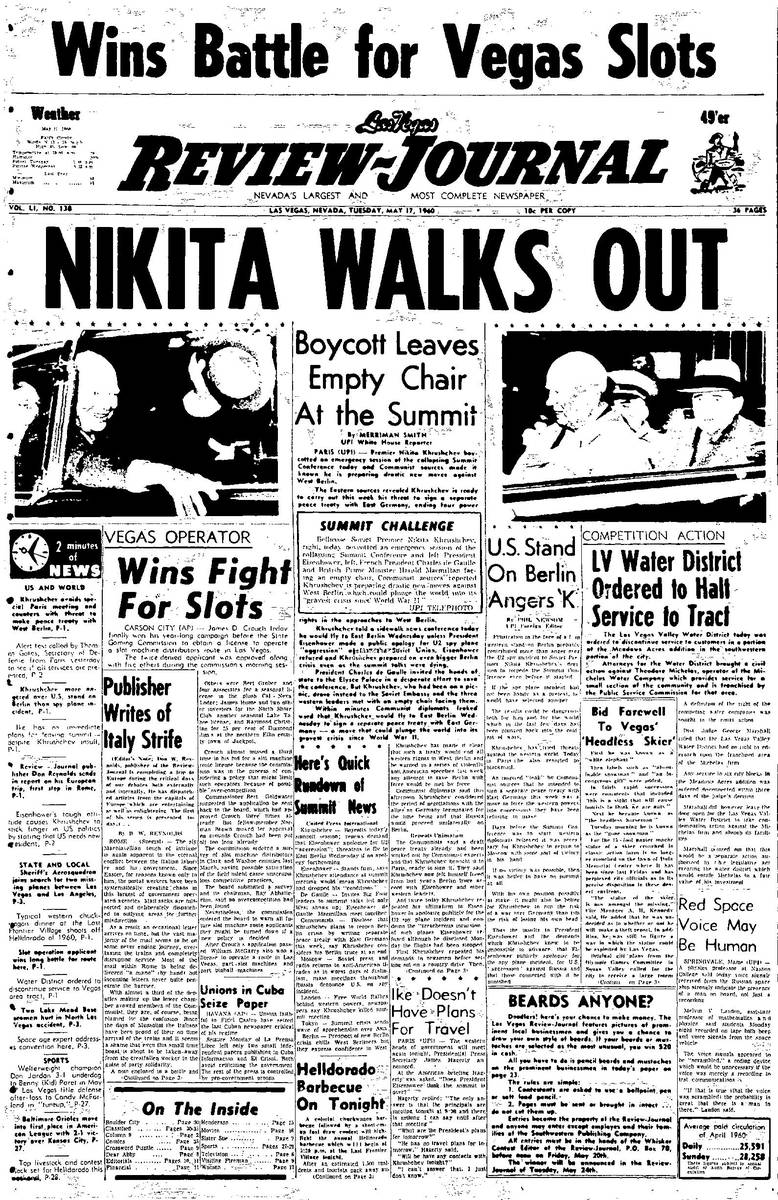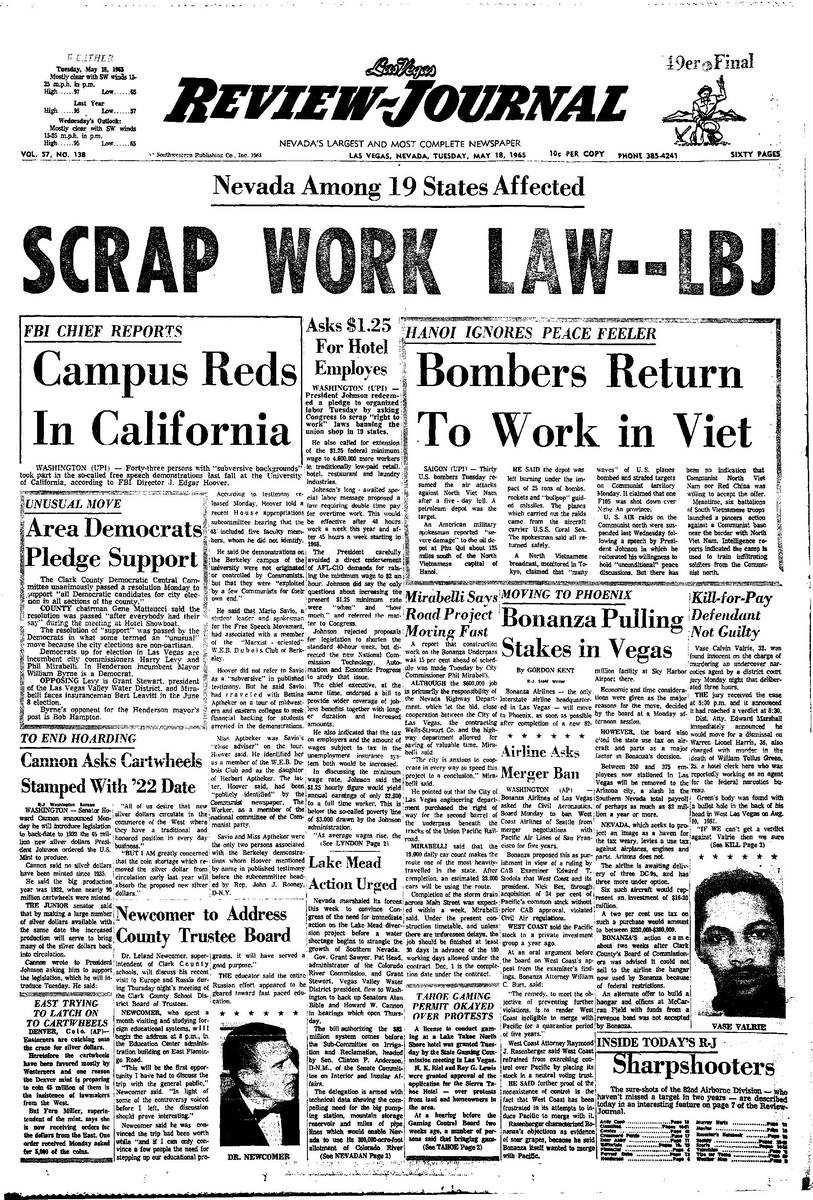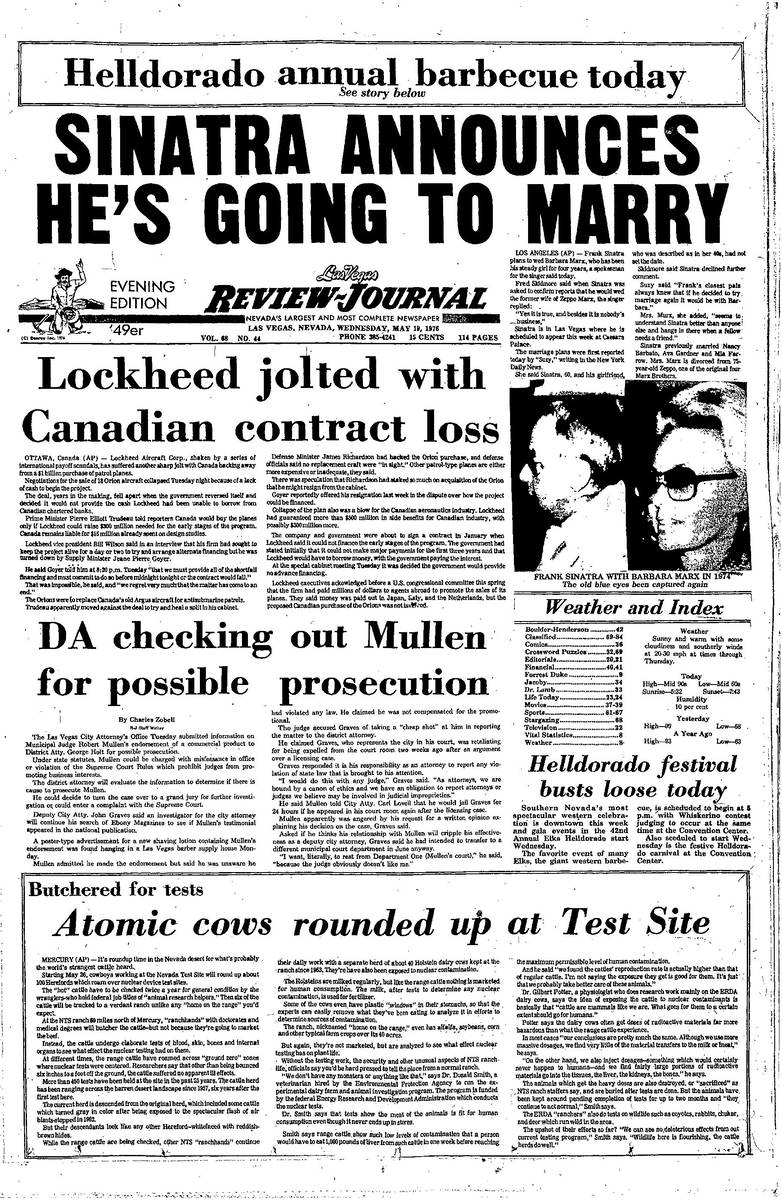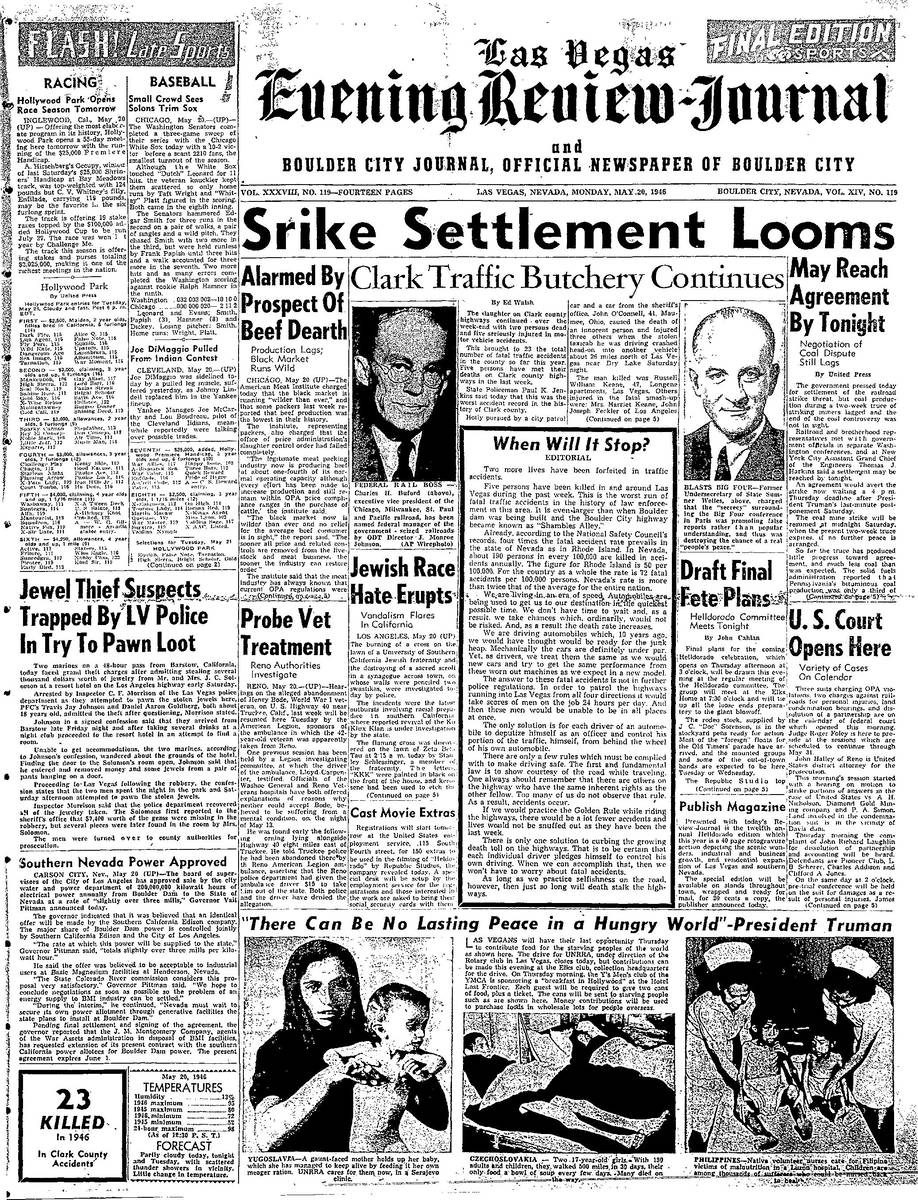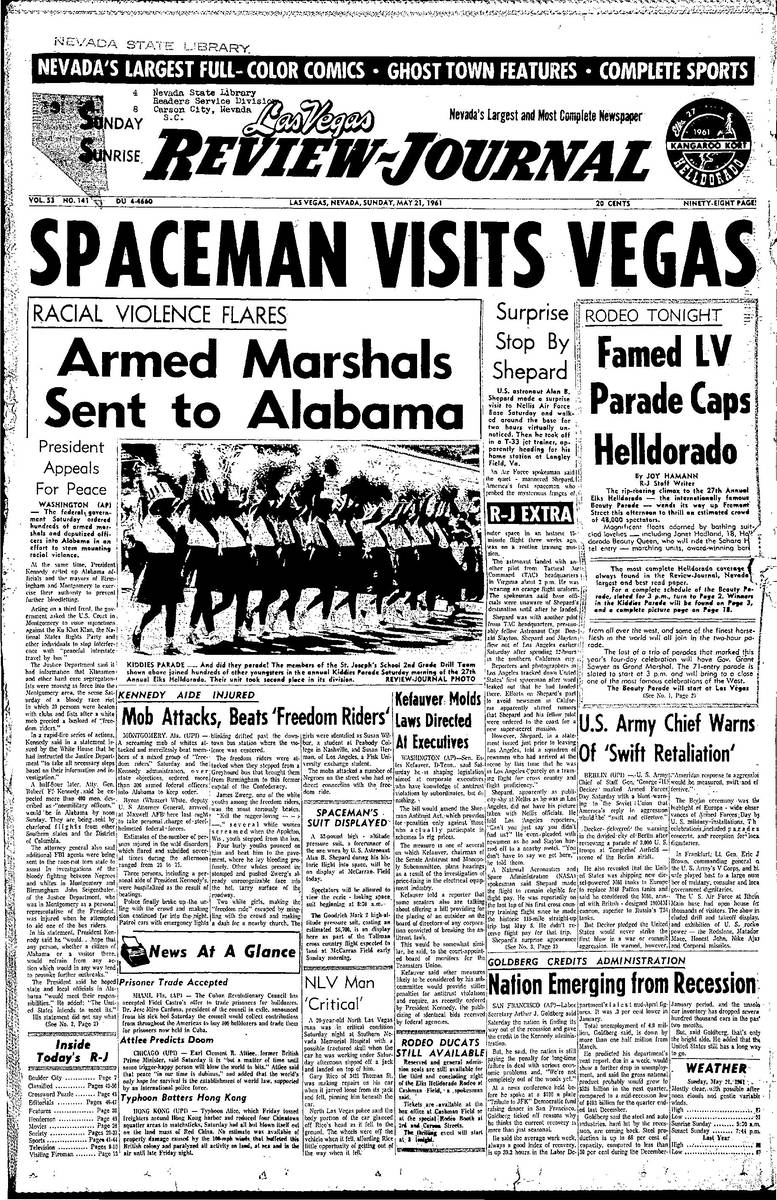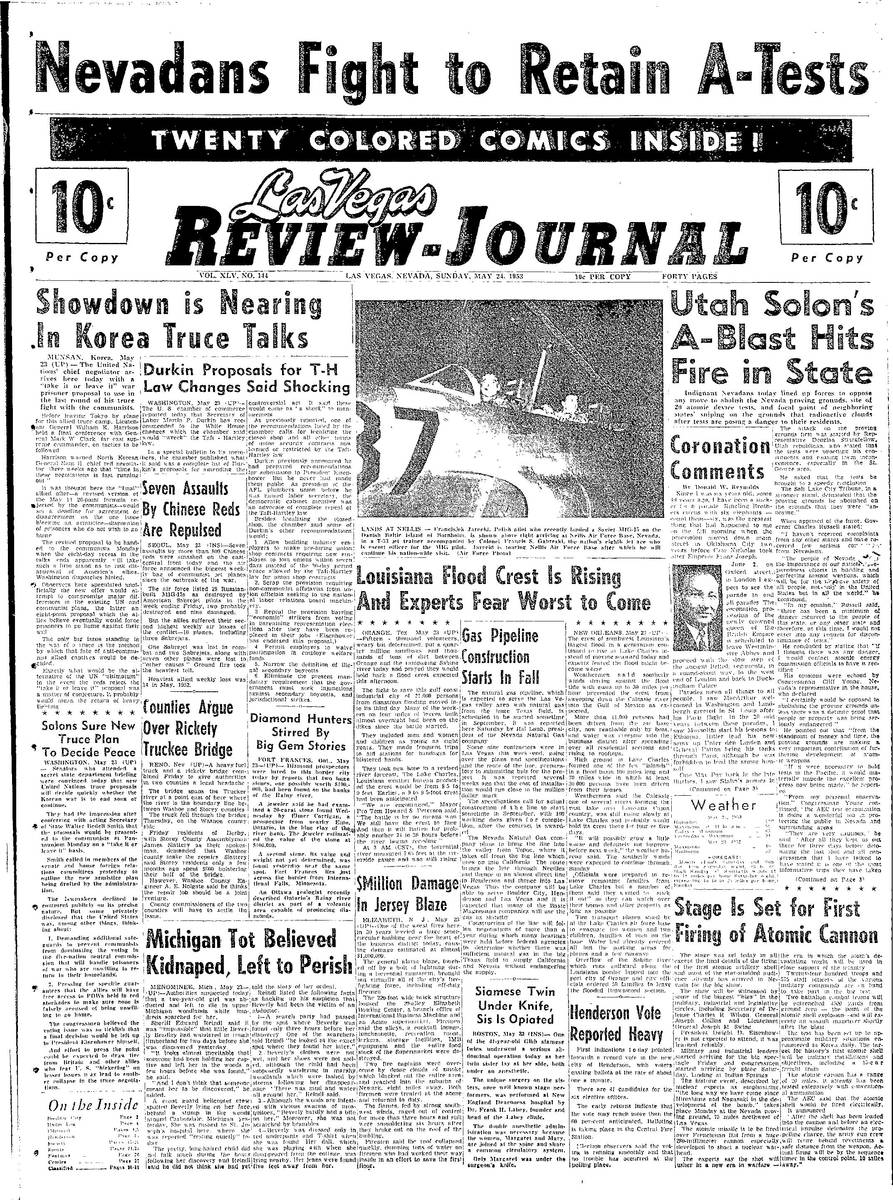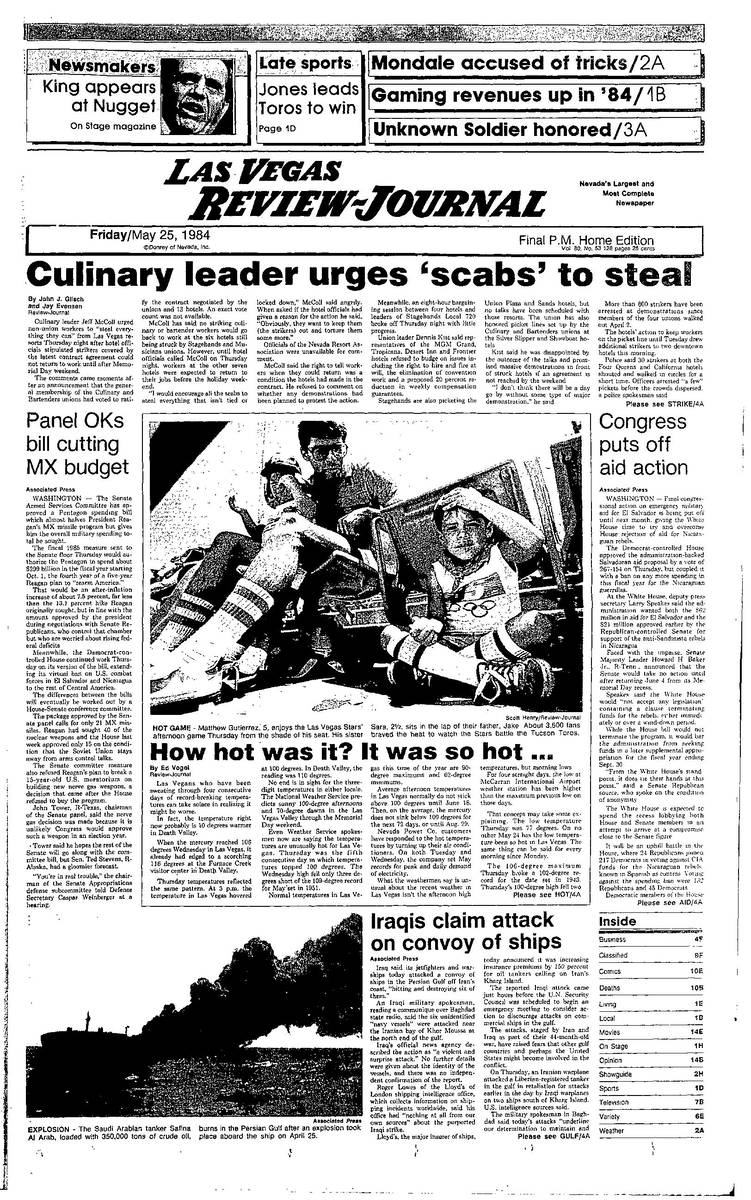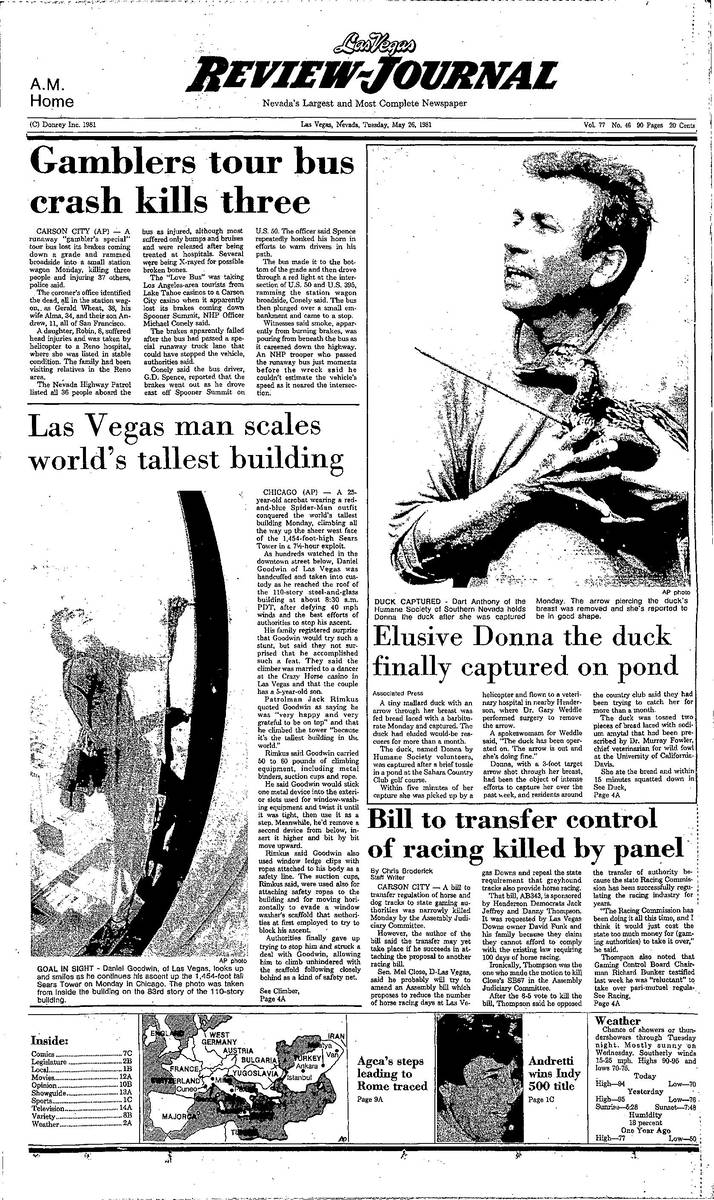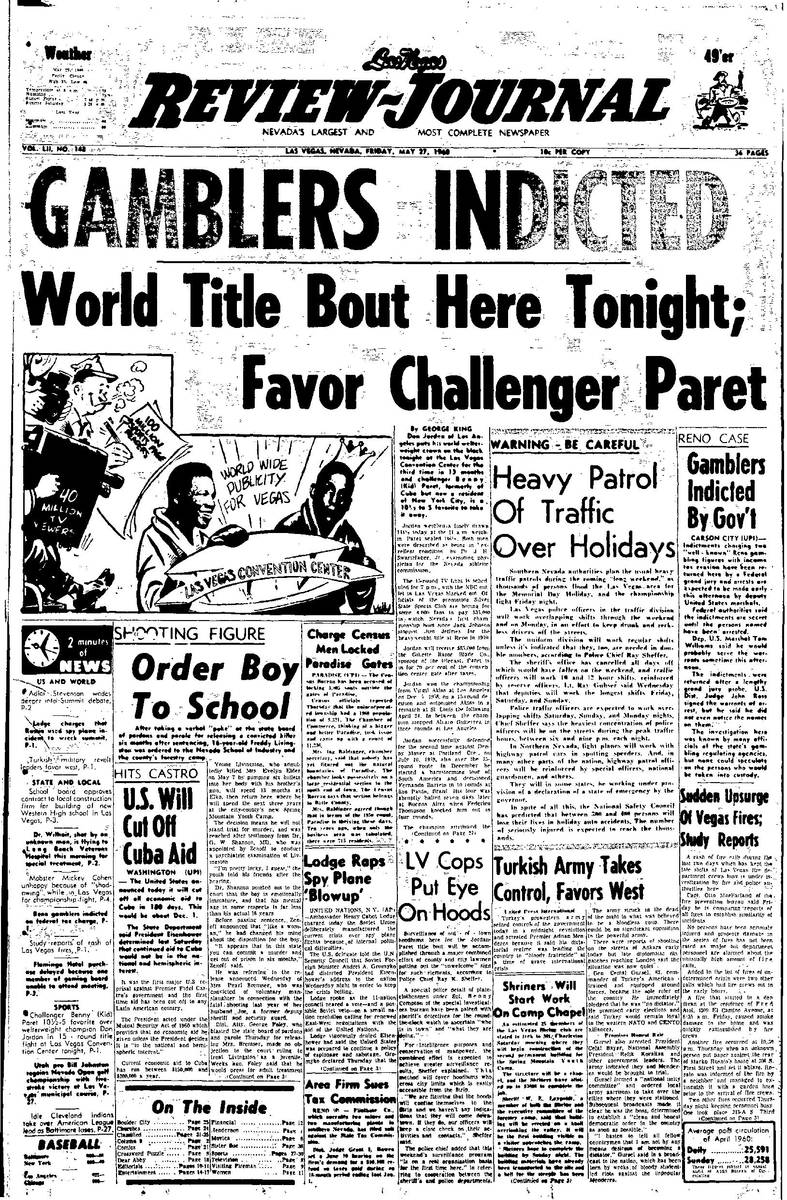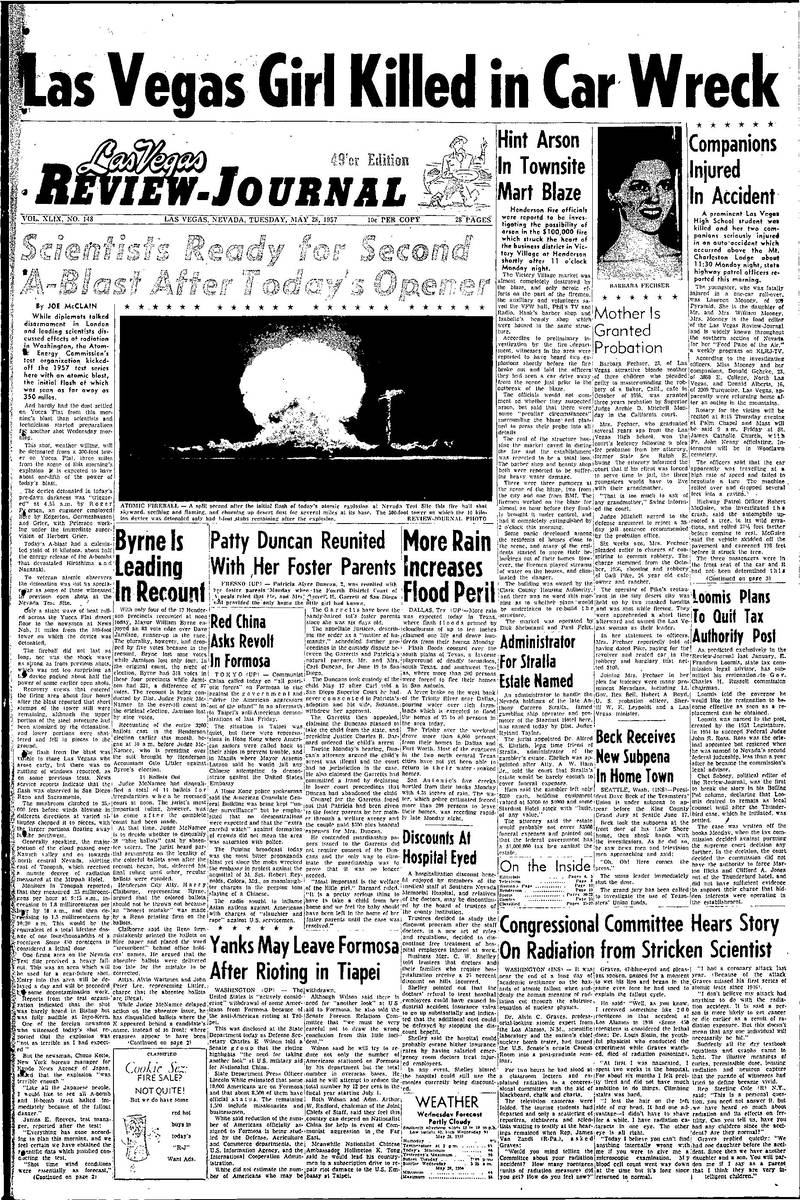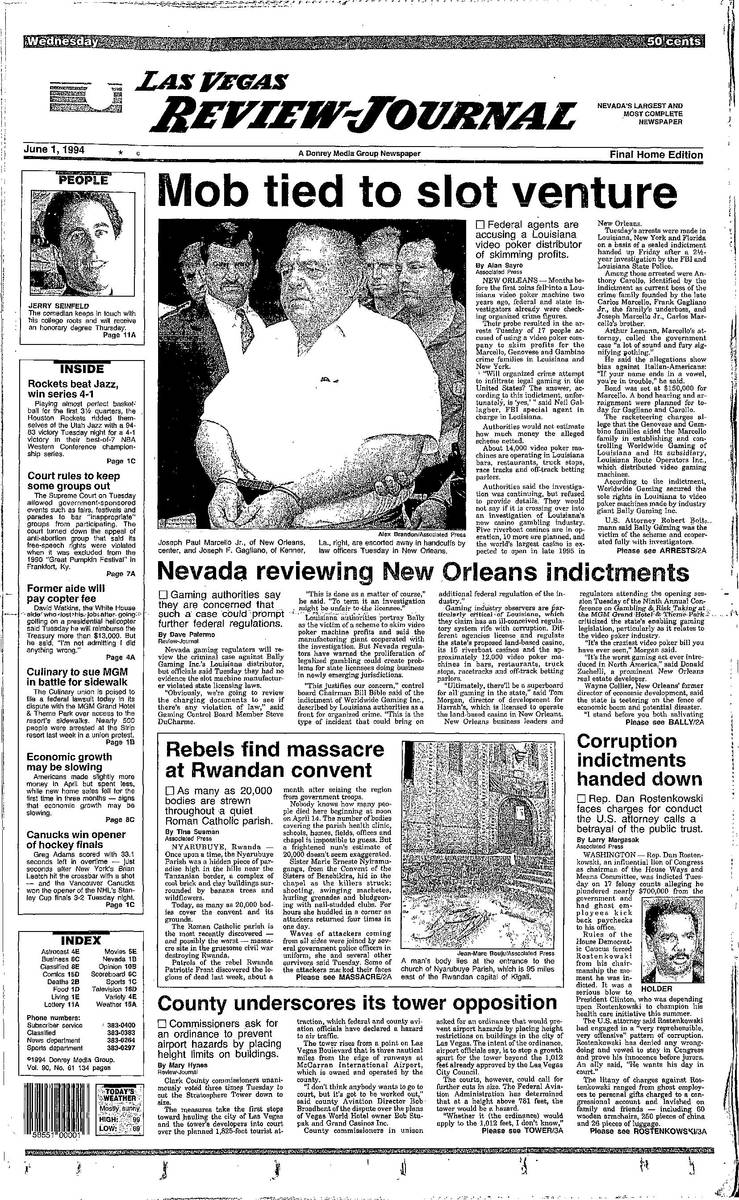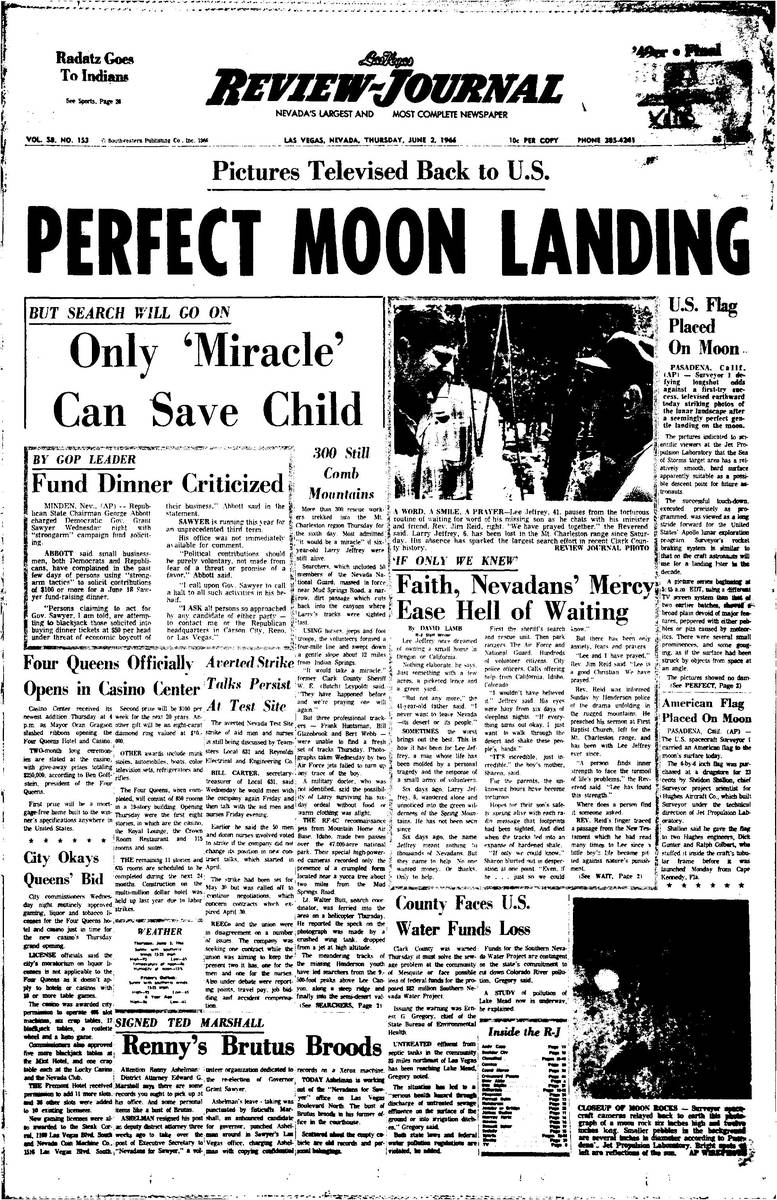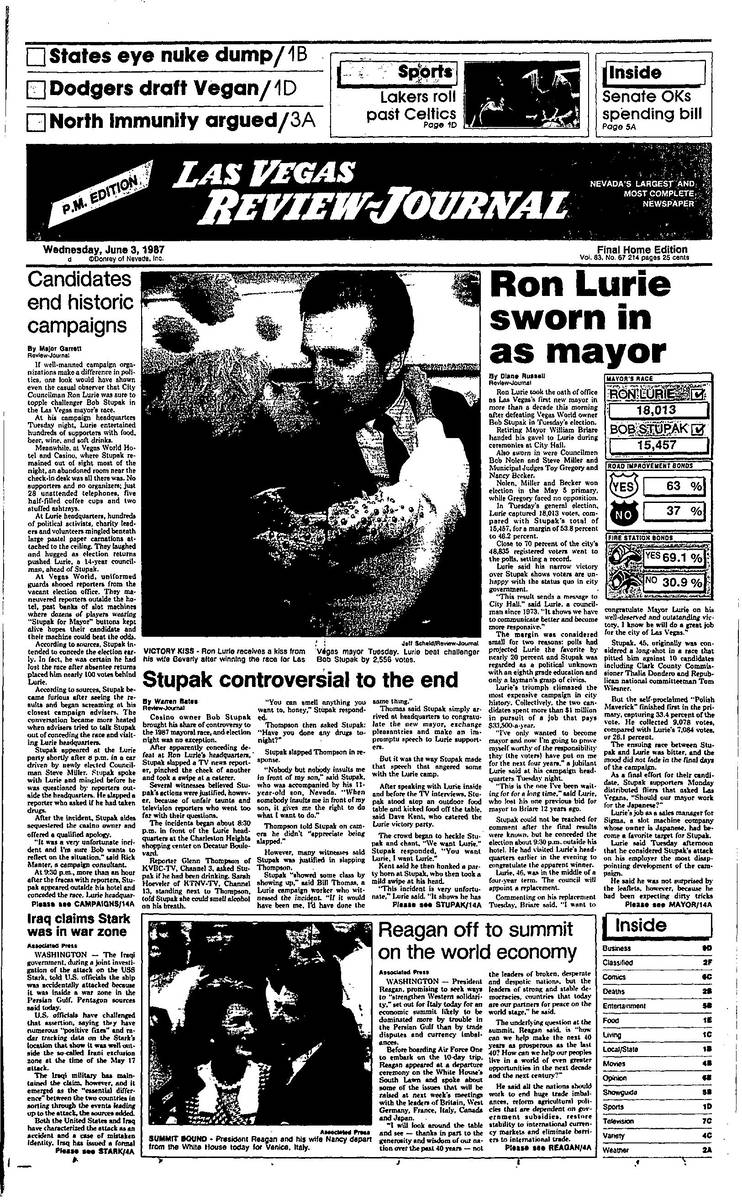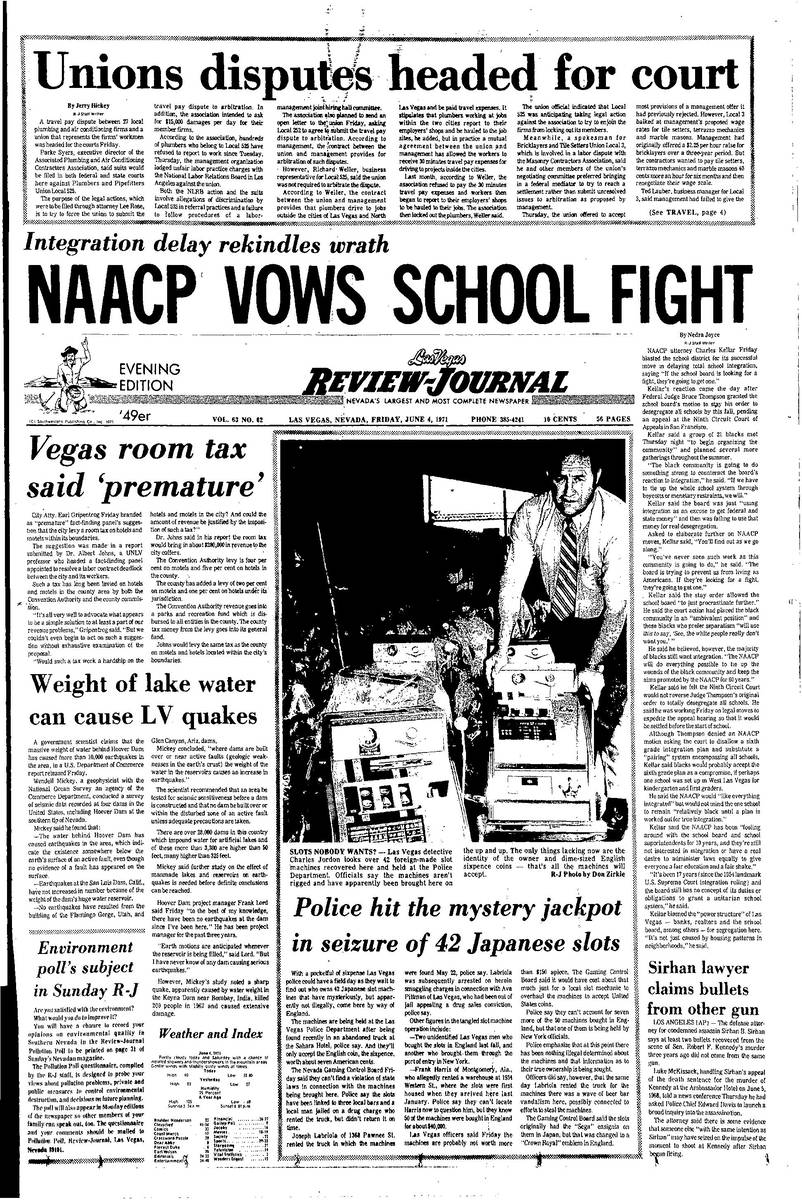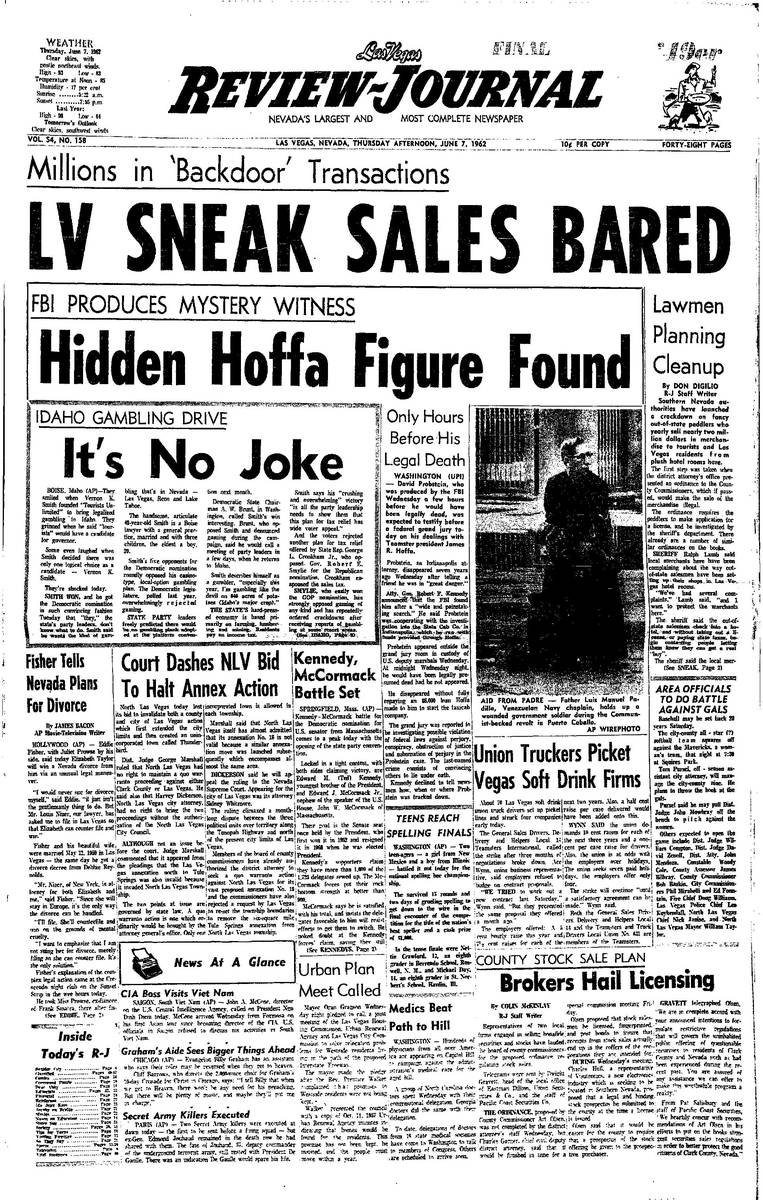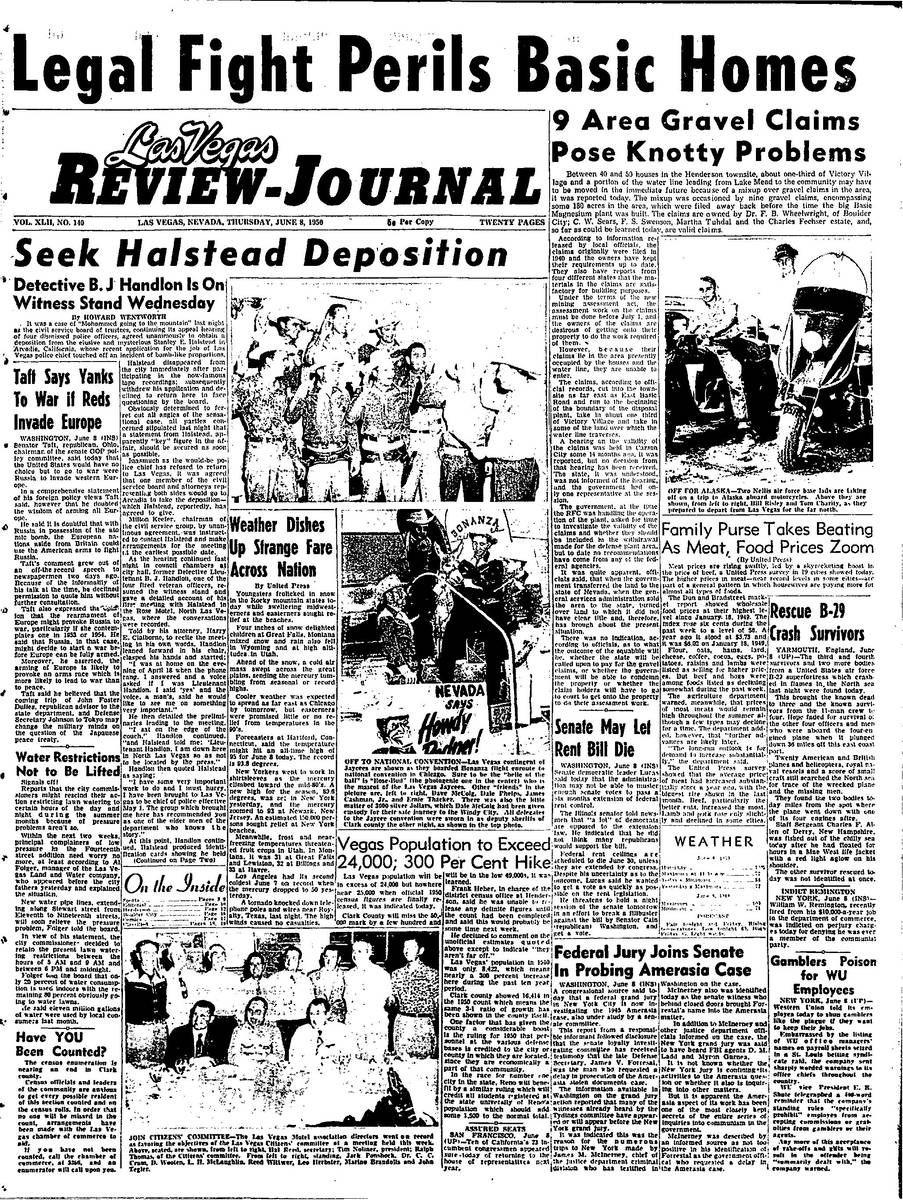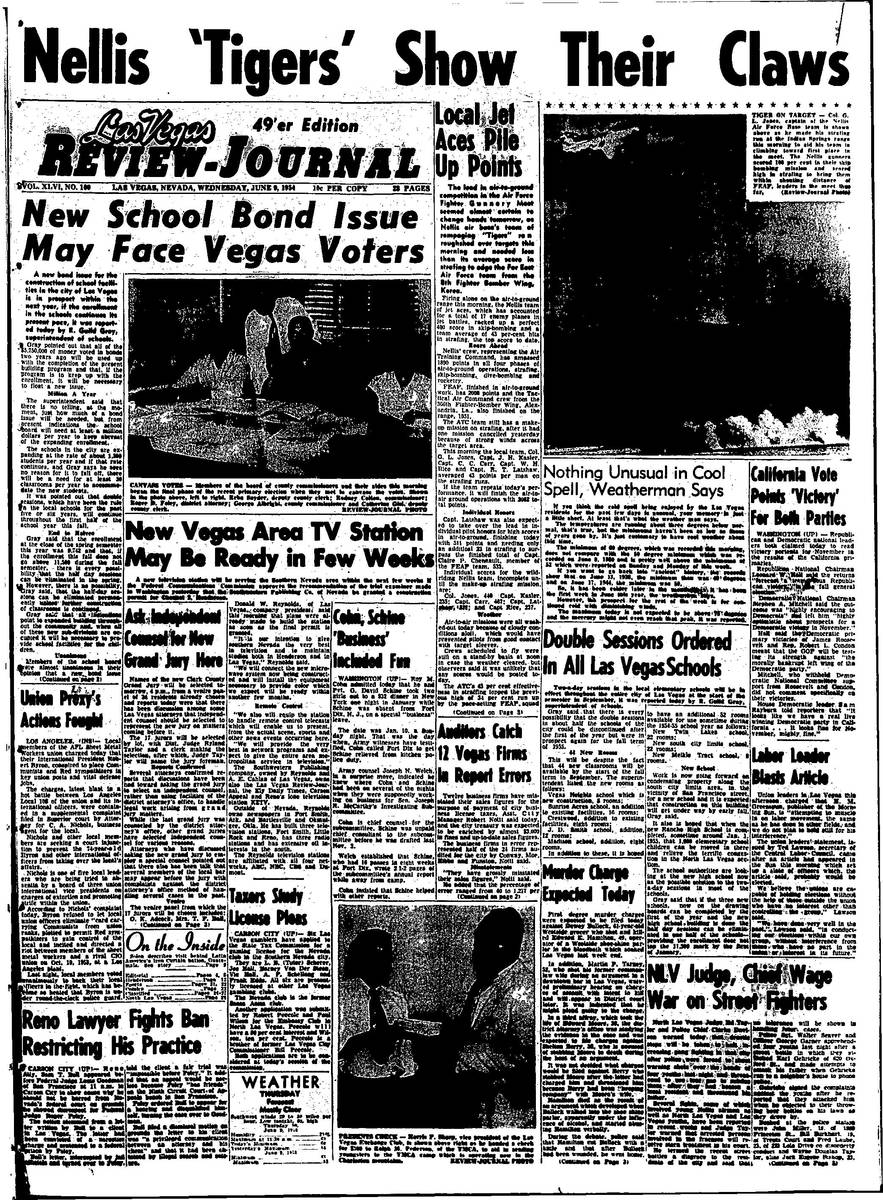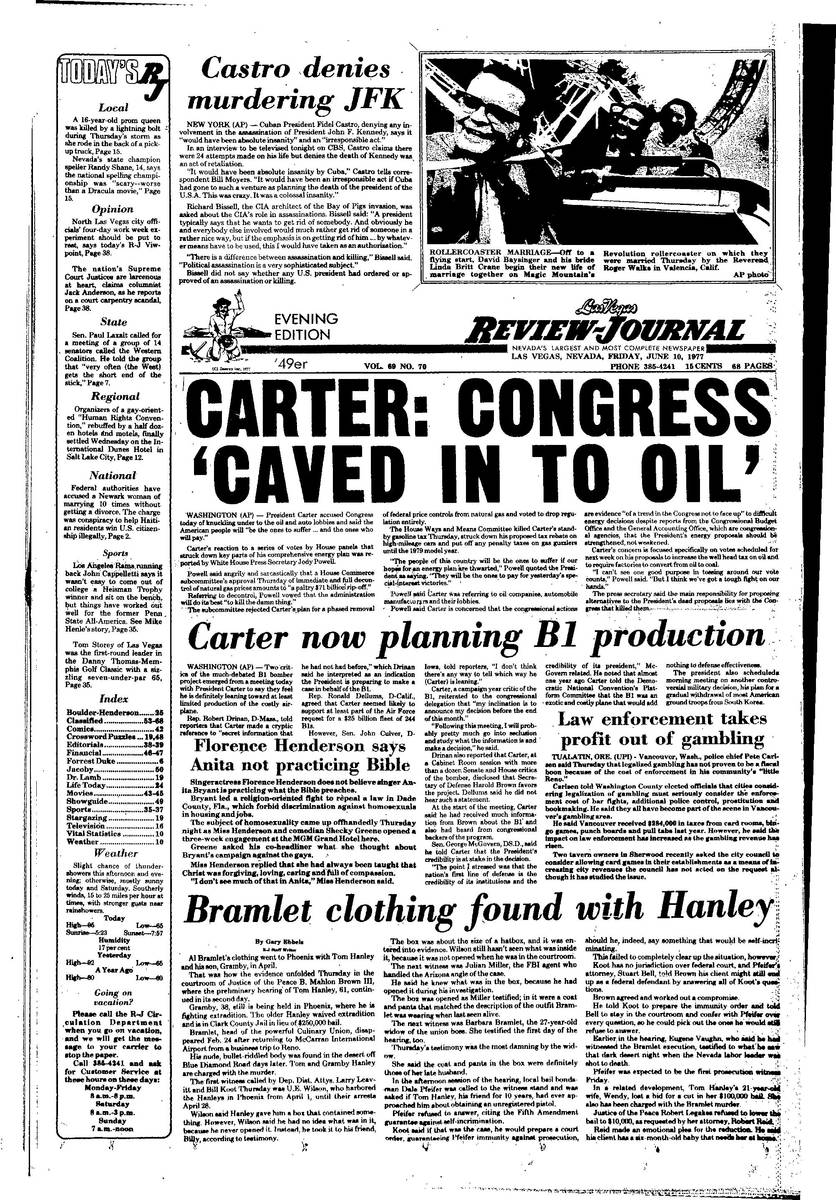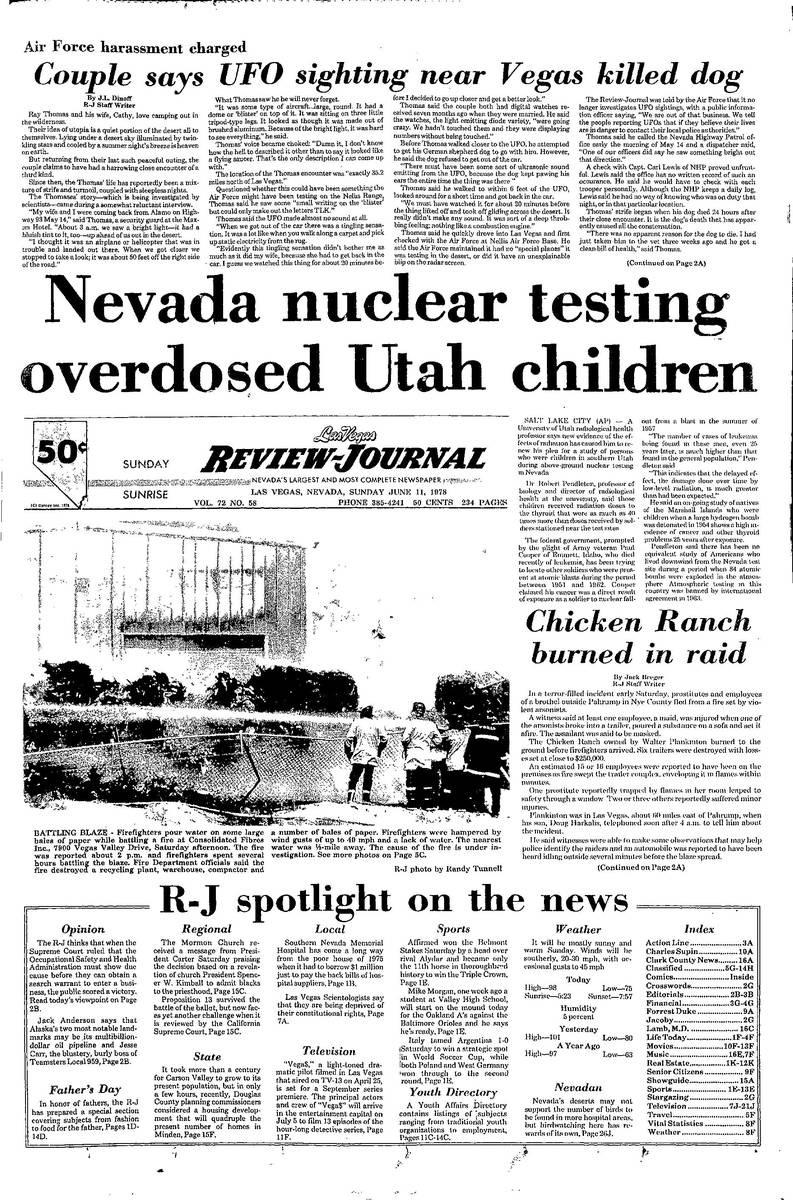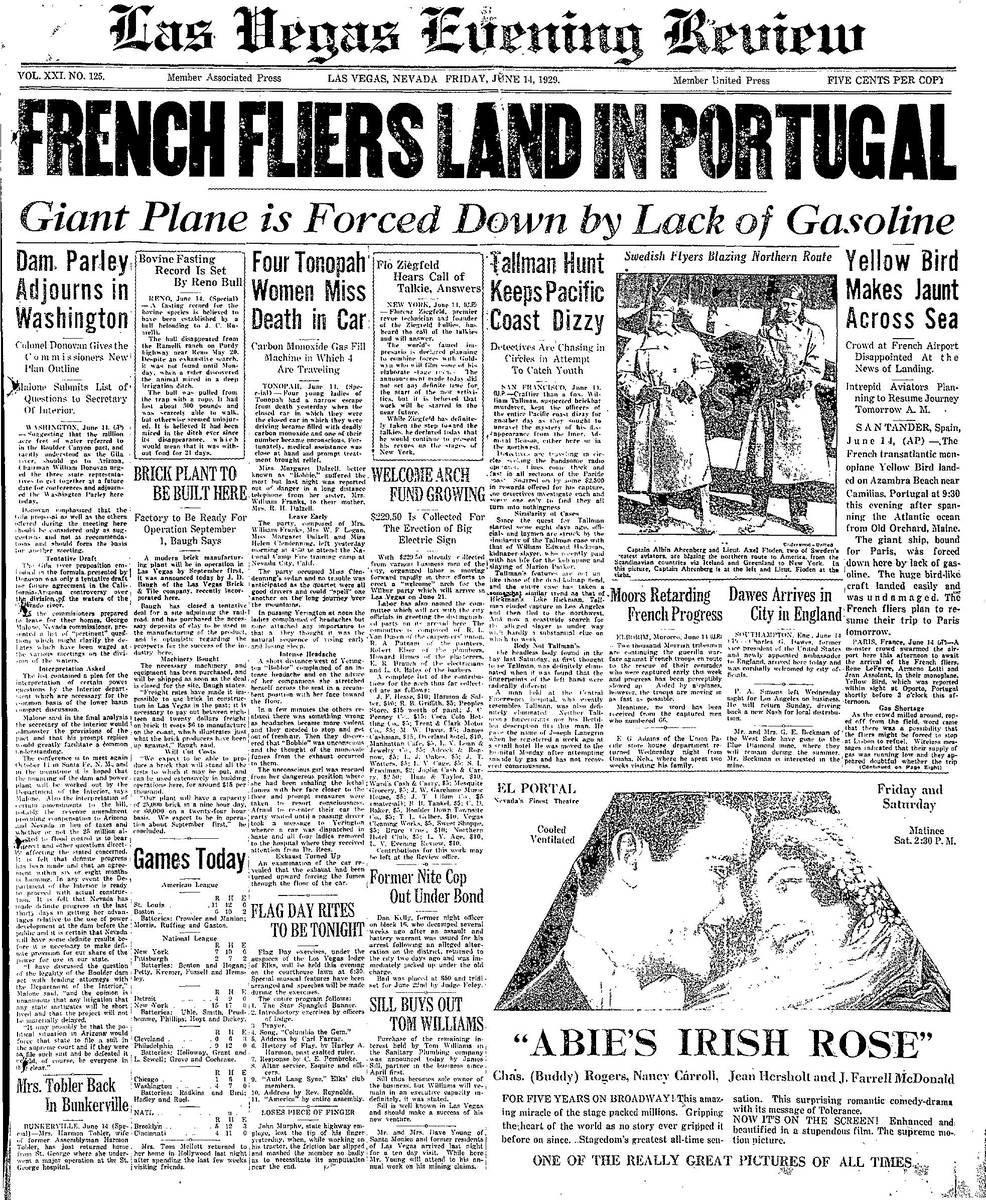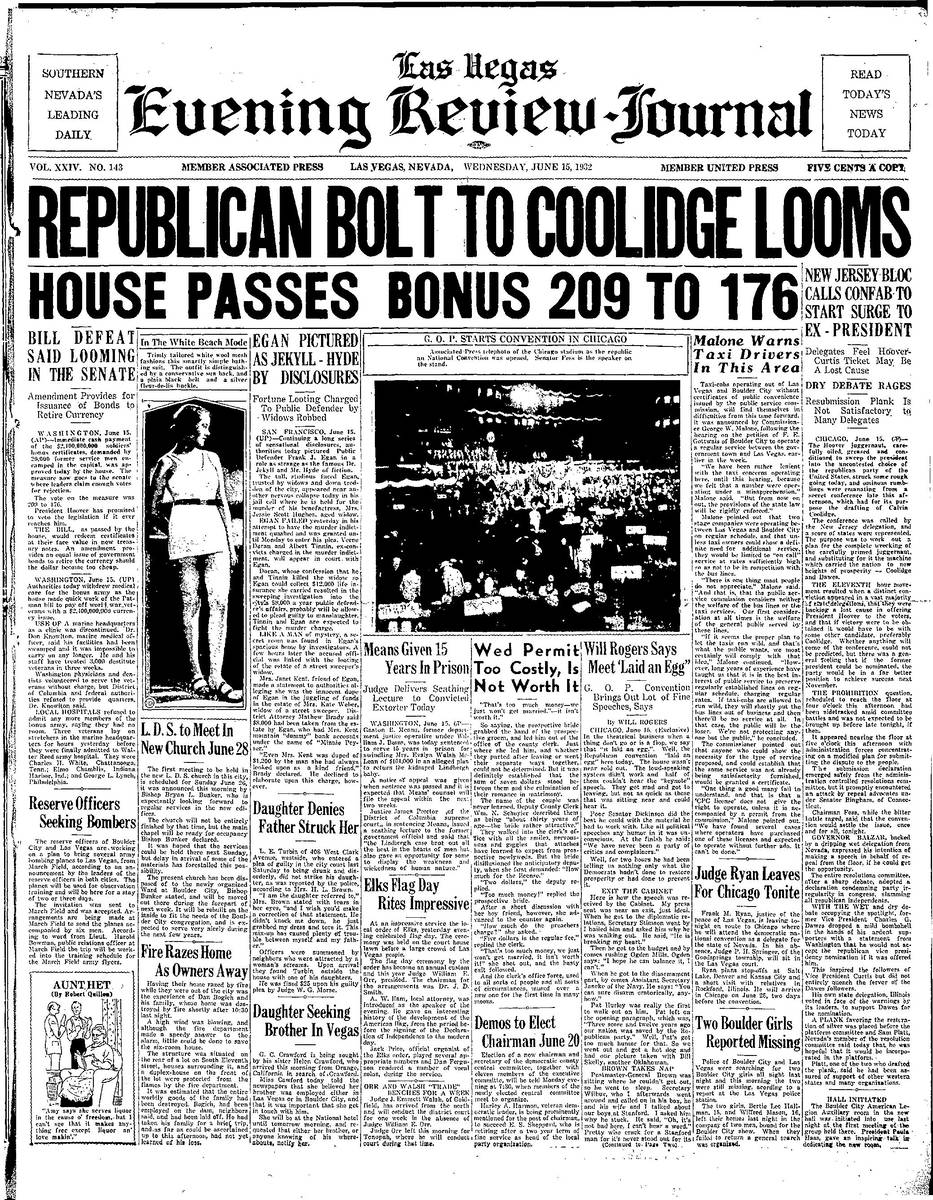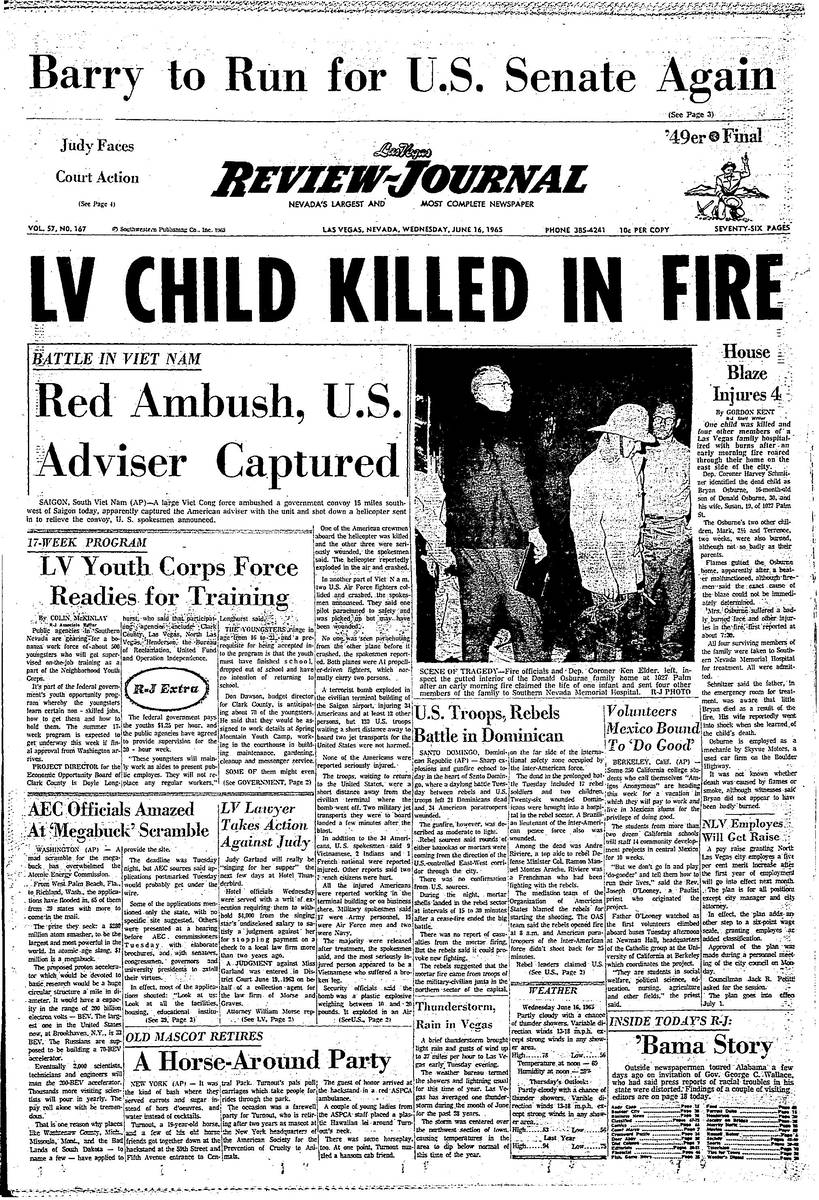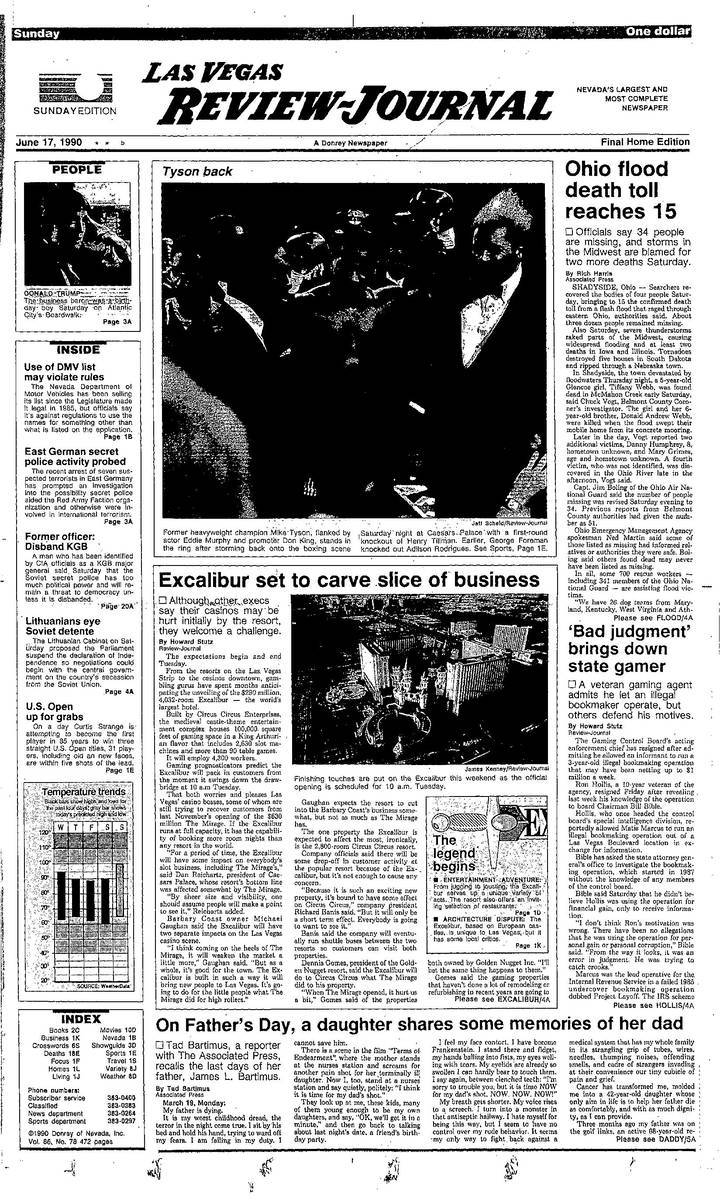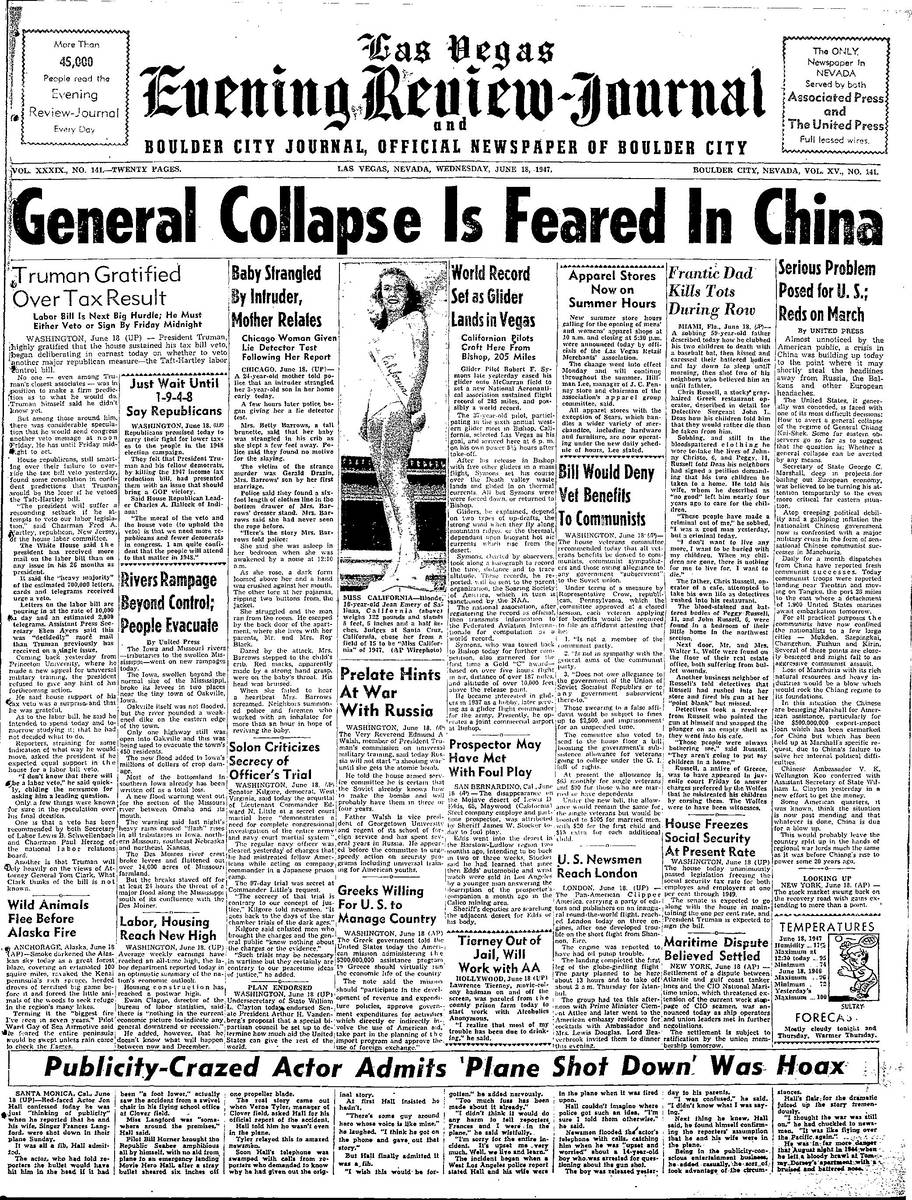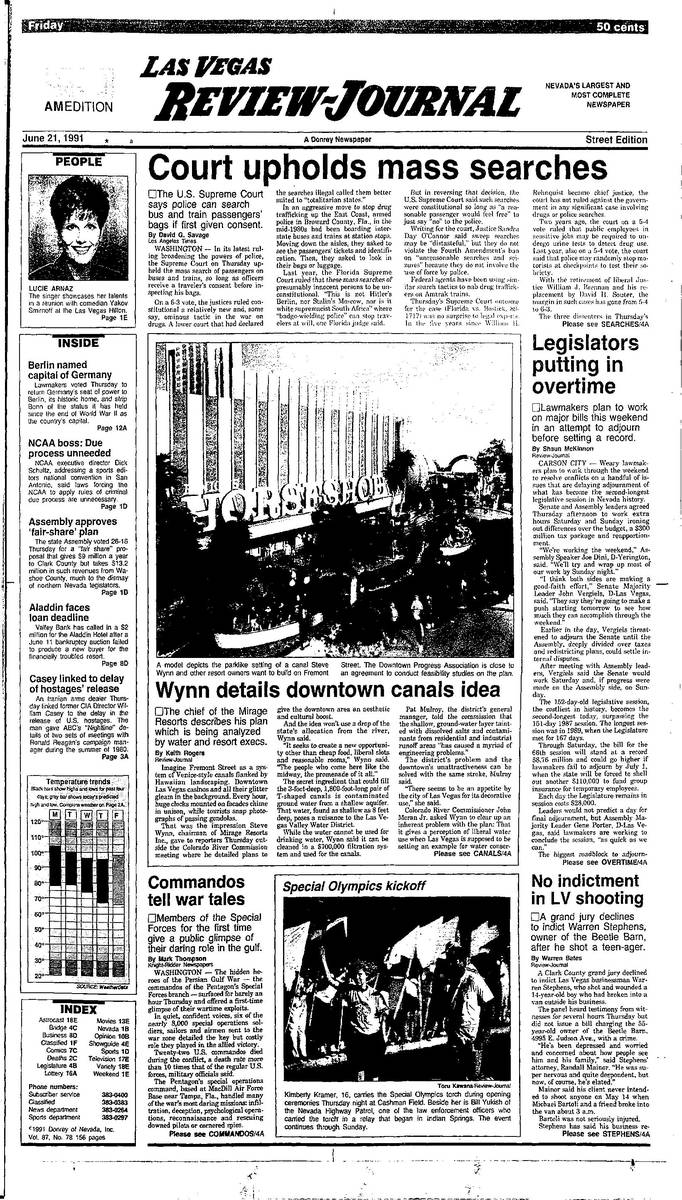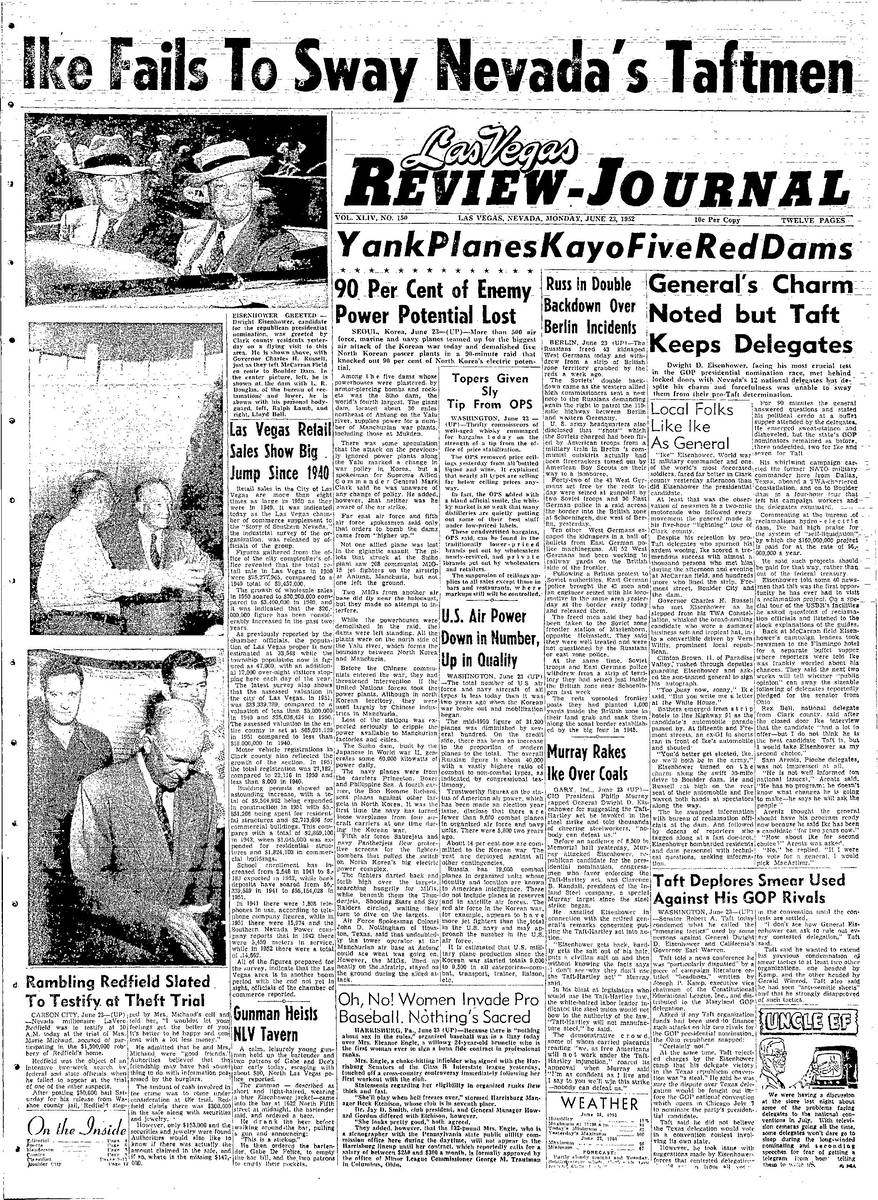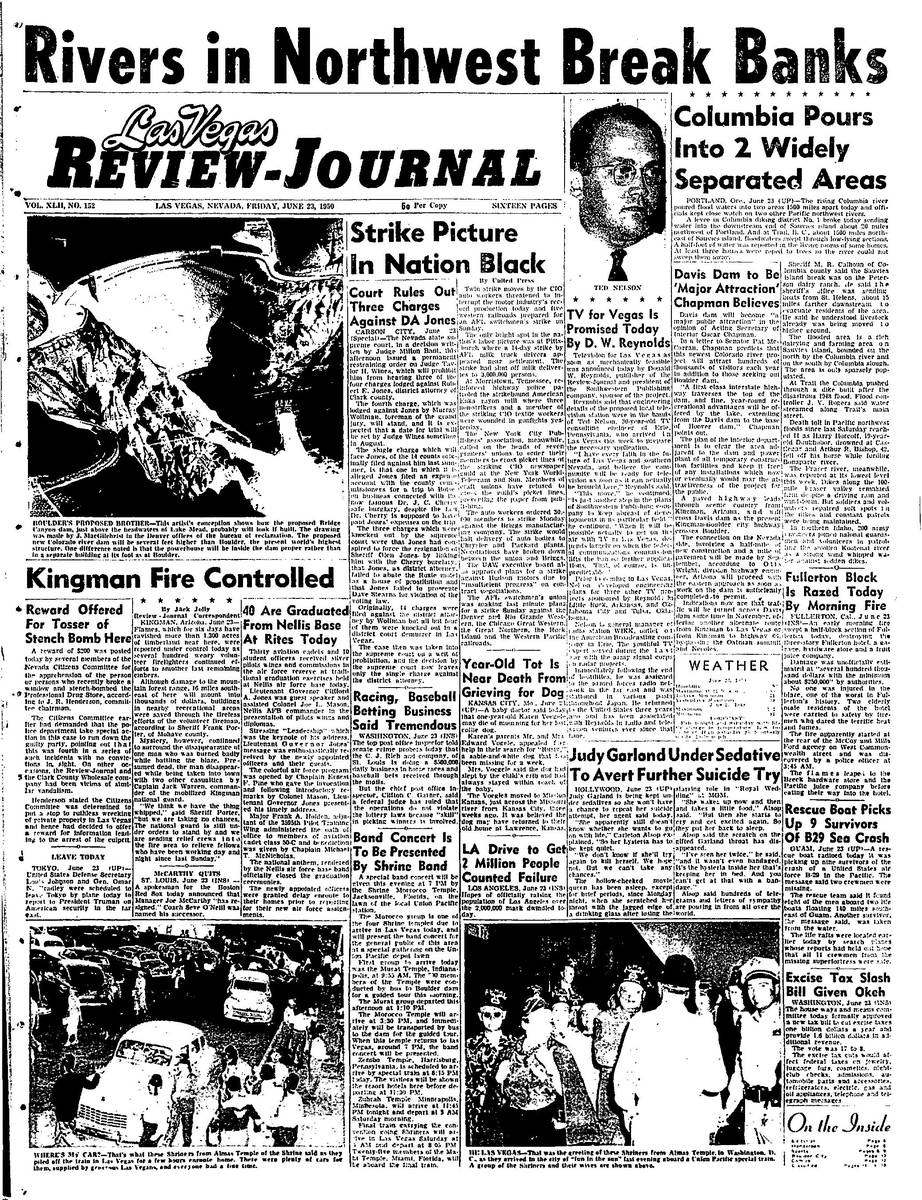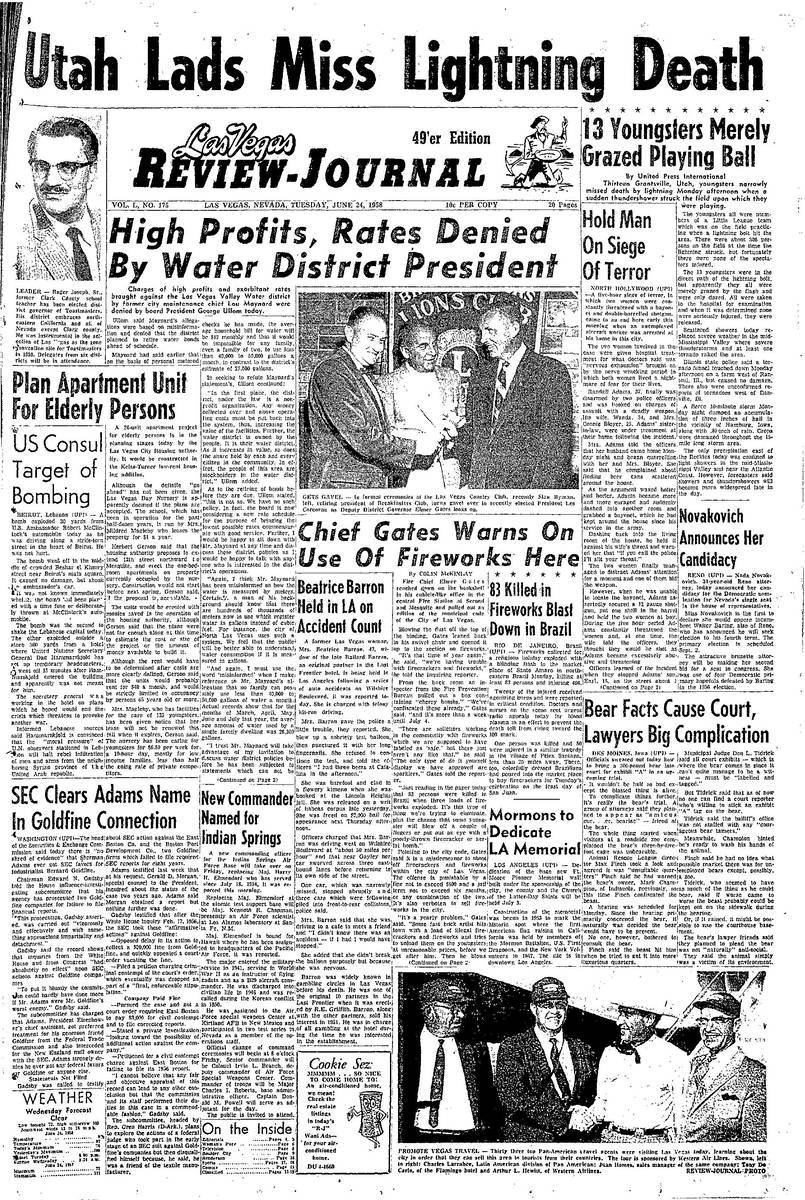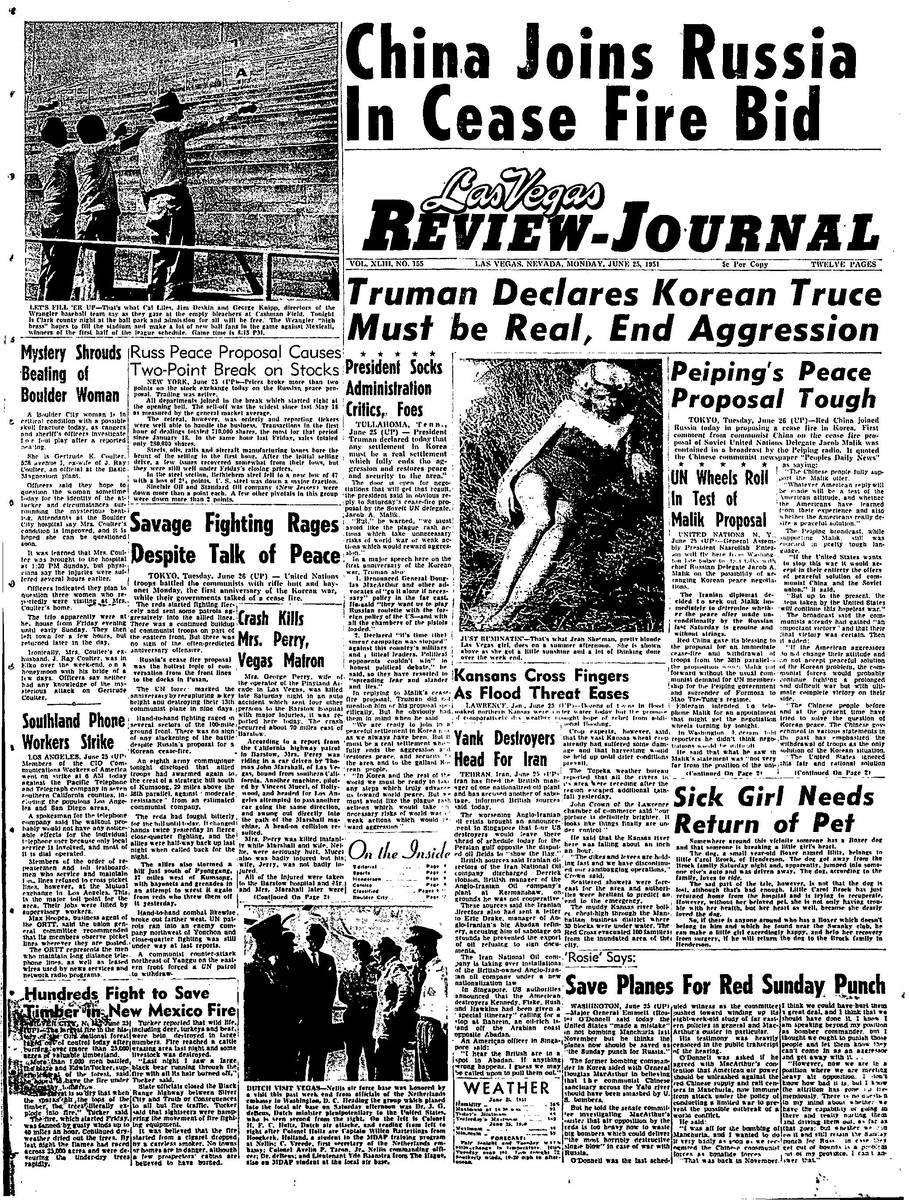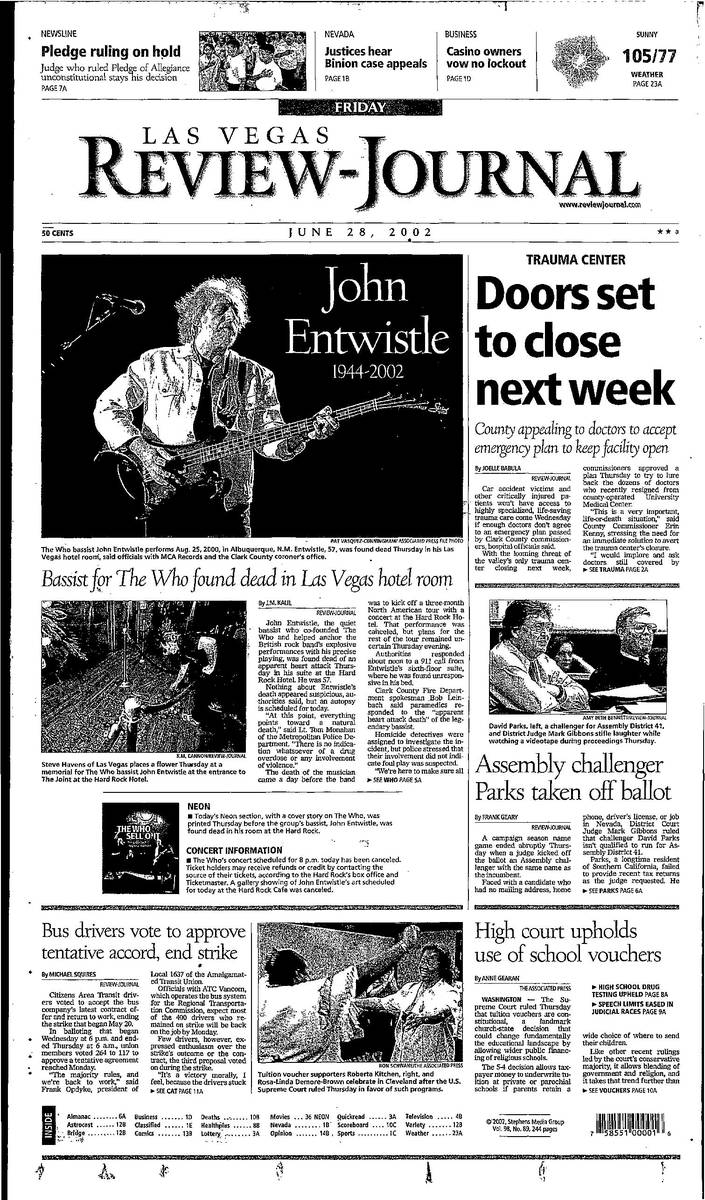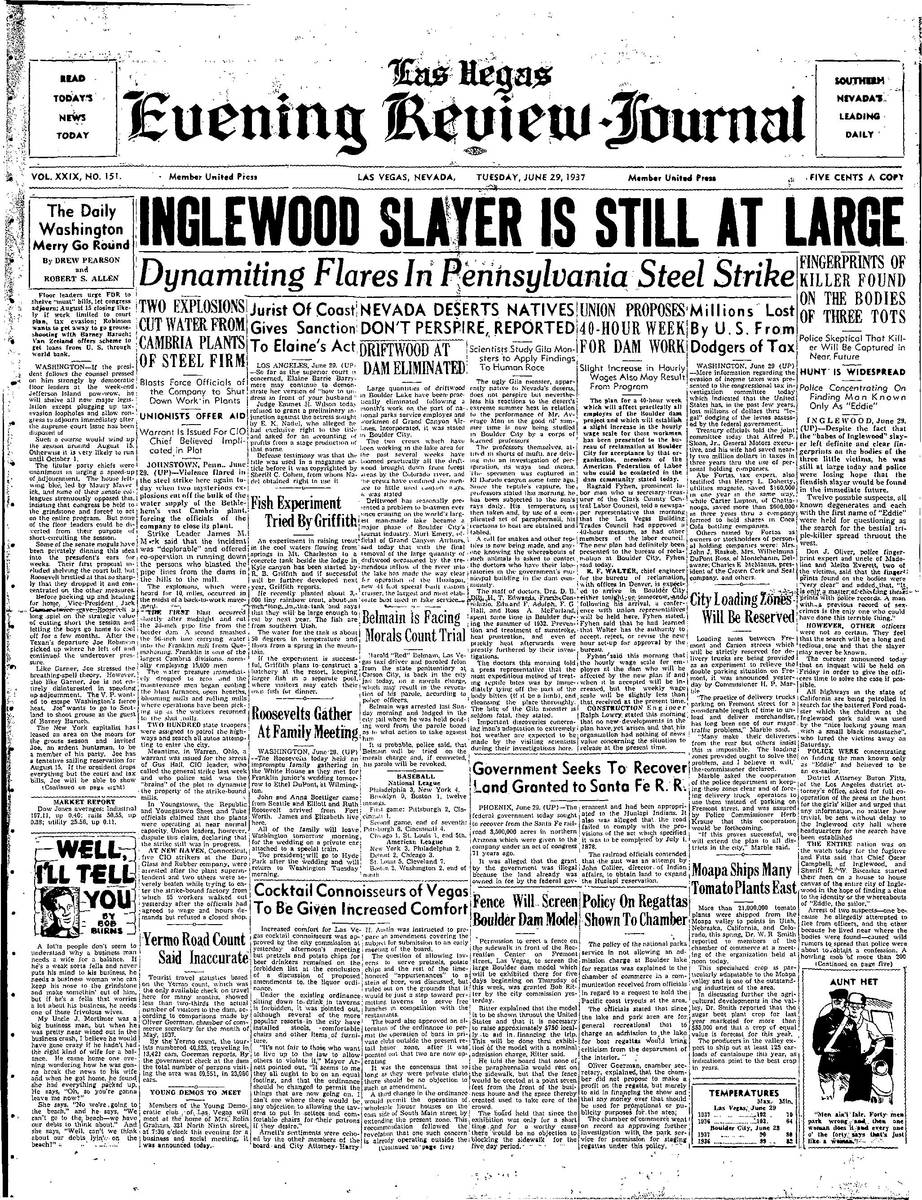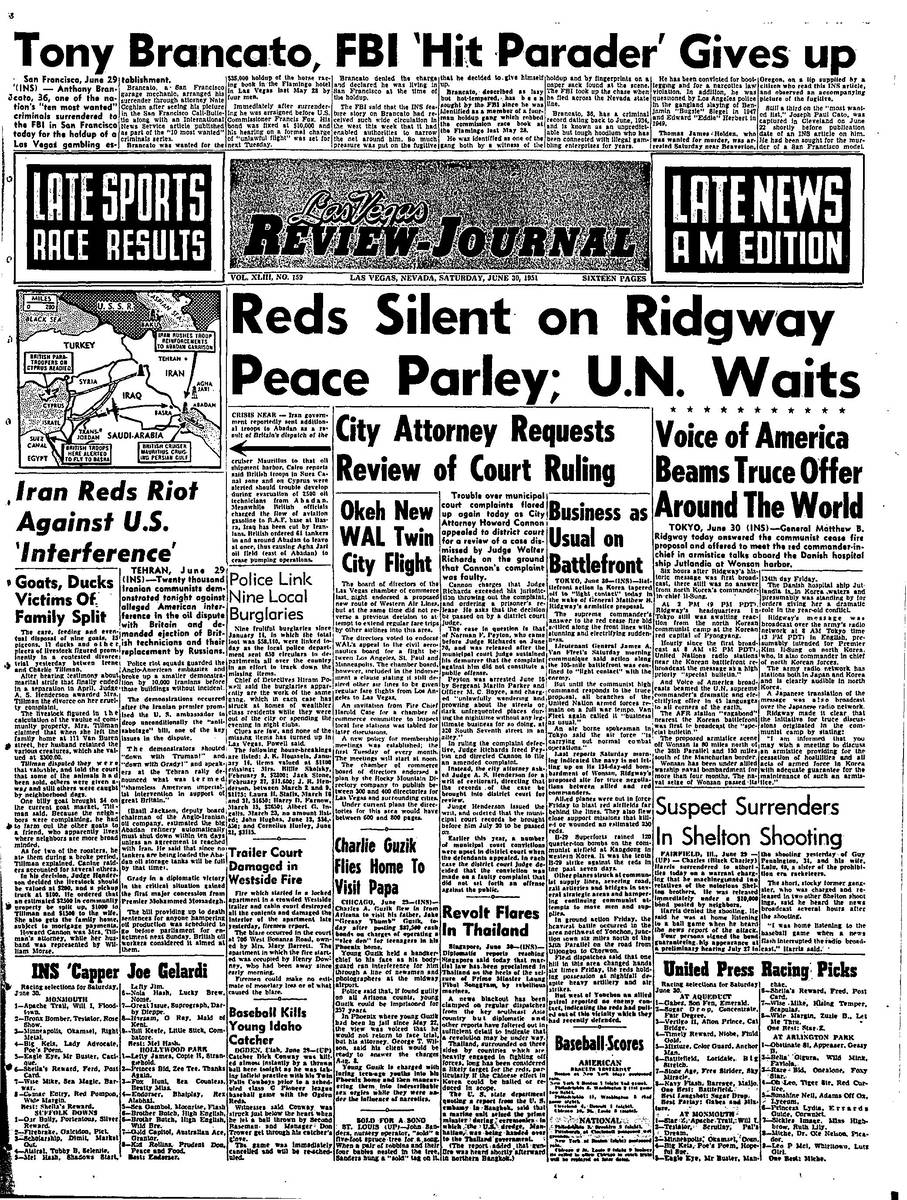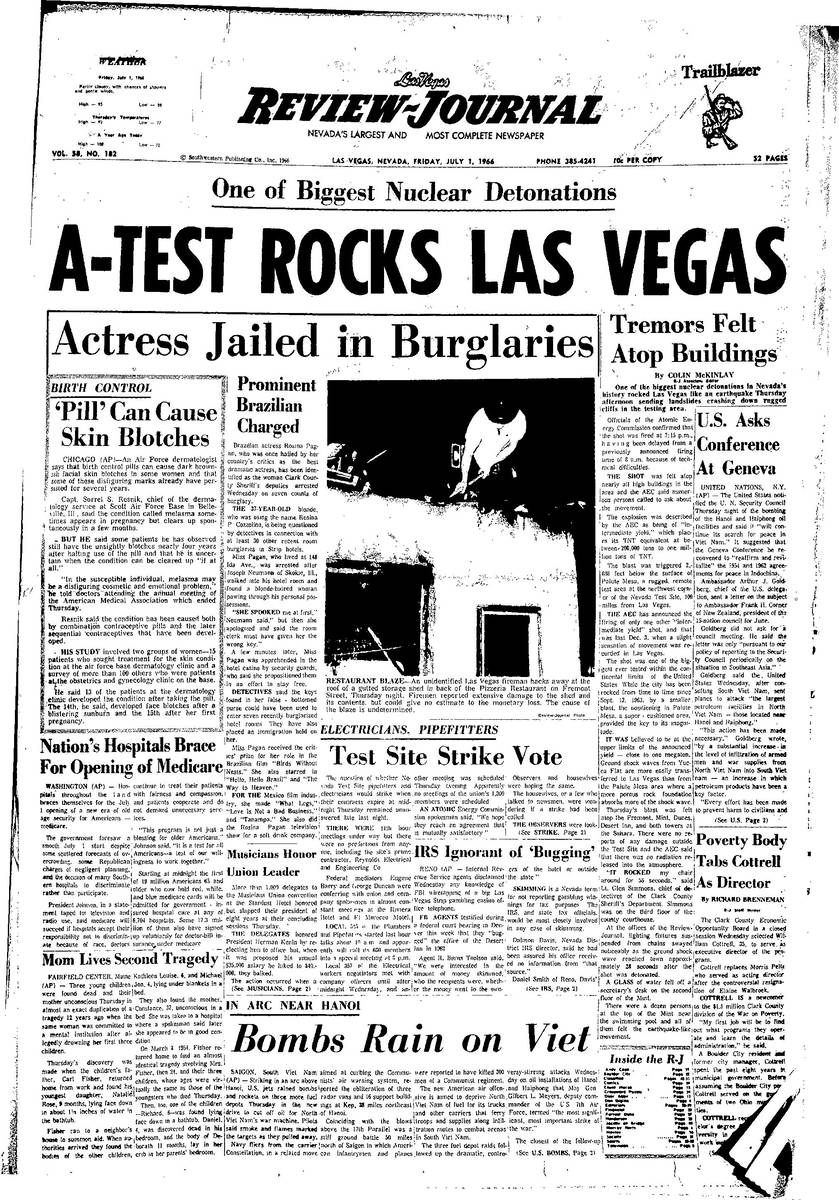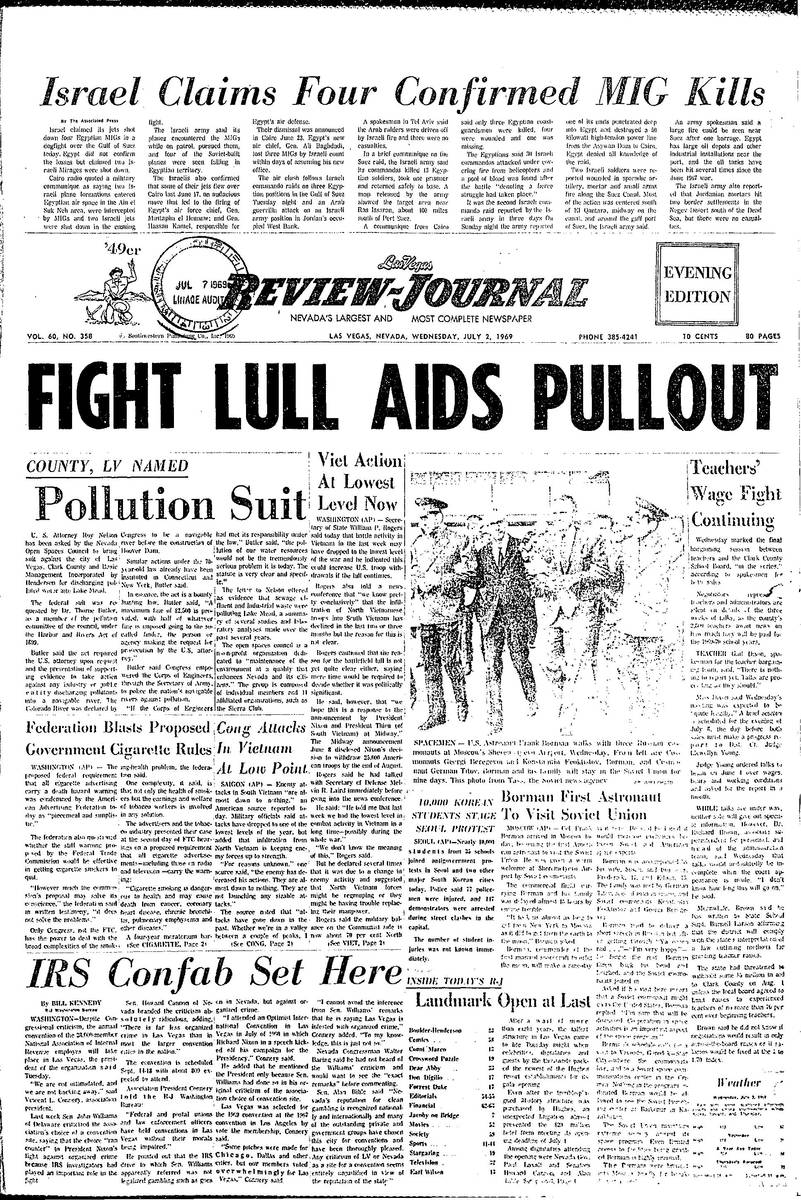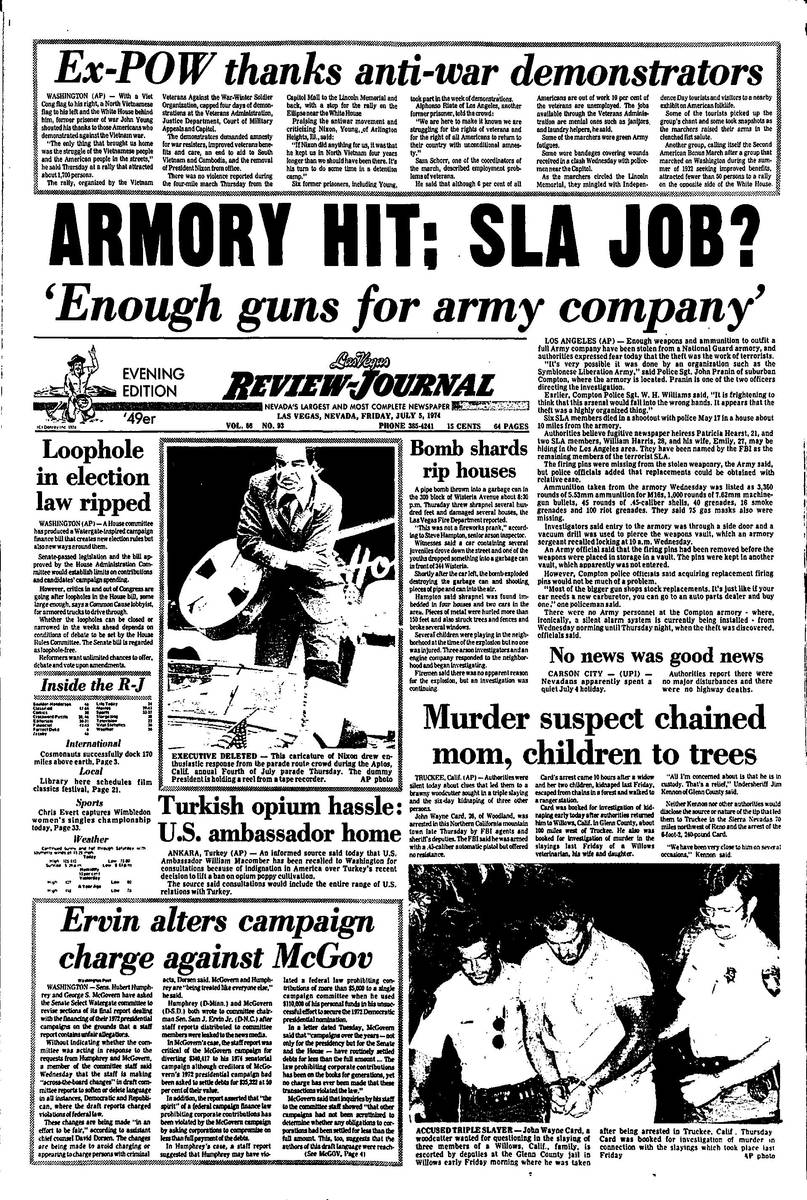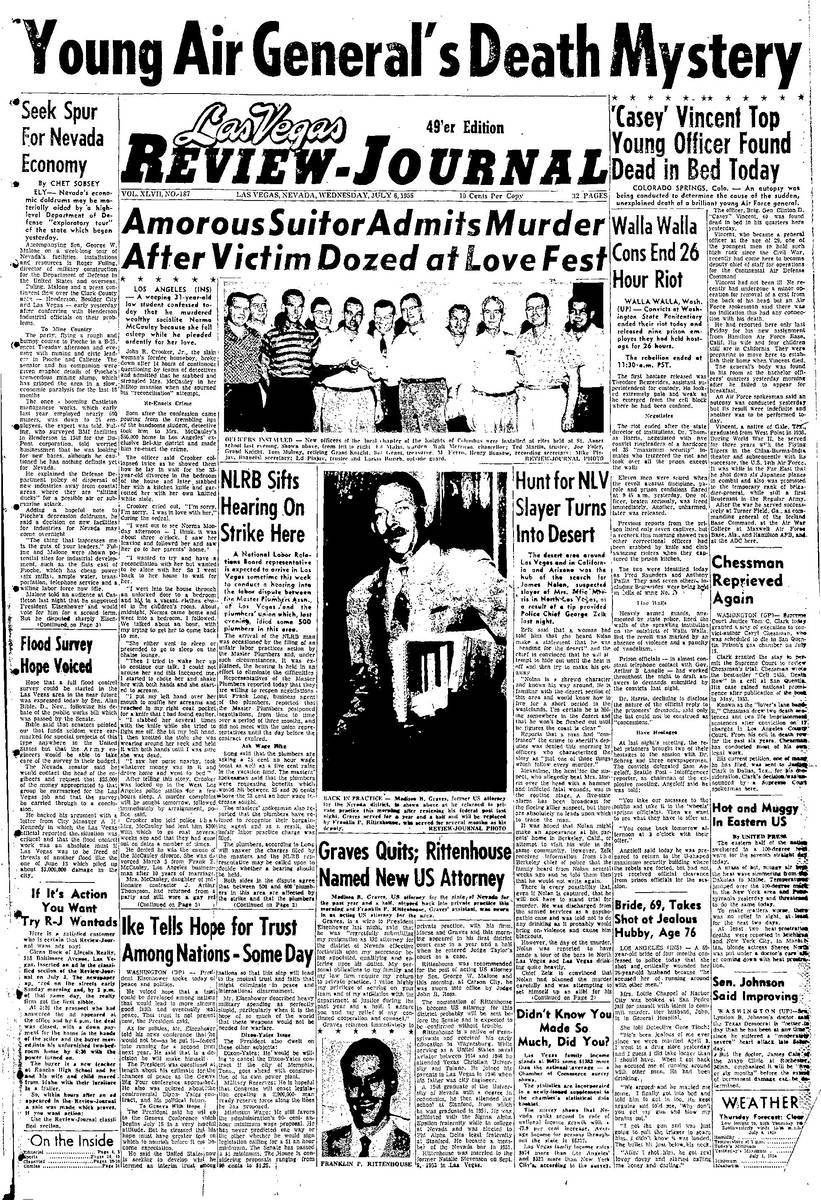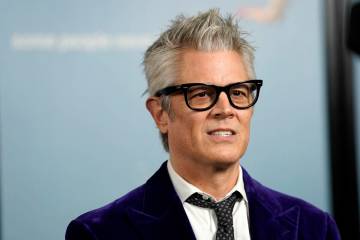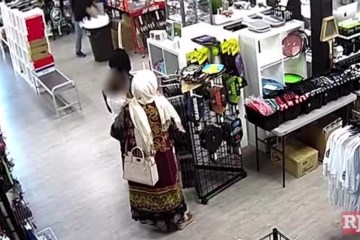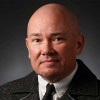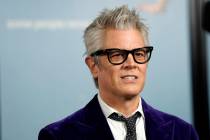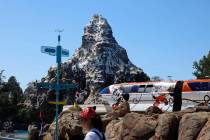Las Vegas history – seen through Review-Journal pages
The Review-Journal has a deep and robust archive of front pages from our print editions, showcasing the top “news of the day” going back decades. Since mid-February, we’ve been featuring pages in our revamped daily newsletter, Starting Point. (Subscribe to that here.) Now you can read a compilation of those short takes.
February
Feb. 2:
On this date in 1931, readers of the Las Vegas Evening Review and Journal learned that work had begun on the construction highway between Boulder City and the site that would become Hoover Dam. A load of lumber to be used in the construction of a labor camp, the first sign of progress, was spotted two days prior. The construction road, we wrote, “will be started to go off down thru the rugged rocky country to the point near the top of the great concrete structure which will hold the waters of the Colorado upon completion in 1935.” There isn’t much actual news in the story, especially considering the giant headline blaring “DAM HIGHWAY STARTED TODAY.” But it helps to look at what else made that day’s front page. A “semi-perfect contract bridge hand” was dealt the previous evening to Mrs. John F. Cahlan. And two teenage runaways were removed from a freight train bound for Salt Lake City by Las Vegas-based Union Pacific officers. The boys, we reported, “are medium well dressed.”
Feb. 3:
On this day in 1991, we were aghast to report that, in his role as coach of the defending national champion UNLV Runnin’ Rebels, Jerry Tarkanian was paid $203,976 by the school. “To keep its coach, UNLV officials made deals that defy explanation — even by those who made them,” we wrote. Tarkanian’s total compensation, including endorsements, was estimated to be more than $600,000. As a sign of just how much things have changed, that base salary, accounting for inflation, equals just $390,091.37 in 2021 dollars. By comparison, current UNLV coach T.J. Otzelberger is earning $1.2 million this season. That $600,000, meanwhile, would equal $1,147,462.56 today — a fraction of the $8 million University of Kentucky coach John Calipari earns each season.
Feb. 4:
On this day in 1961, the Review-Journal’s front page introduced readers to Pittman resident Pete Oliver. Apparently, people told Oliver he looked like Victor Borge, so he went to see the comedian and pianist perform at the Congo Room in the Sahara and posed for a photo with his “twin.” Times were simpler then. Elsewhere that day, the banner headline “LAS VEGAS LOOMS AS TV MECCA” led readers to a story about “Las Vegas Beat,” a proposed TV series starring Peter Graves and Jamie Farr that was filming in the city. The headline got a little ahead of itself. “Las Vegas Beat” aired as an NBC movie and wasn’t picked up to series. It would be another 17 years, and the arrival of Robert Urich in ABC’s “Vega$,” before Las Vegas was truly featured in all its glory as the backdrop of a TV series.
Feb. 9:
Feb. 9: On this day in 1963, the Review-Journal used a headline size usually reserved for the start of world wars to declare “TONY CURTIS MARRIES TEENAGER IN LAS VEGAS.” The actor, who would go on to become a longtime resident of the city, wed 18-year-old German actress Christine Kaufmann, as Kirk Douglas served as best man and his wife, Anne, was maid of honor.
Feb. 12:
On this day in 1958, readers were introduced — or, in some cases, reintroduced — to Ralph Lamb. Before stepping away from the Clark County Sheriff’s Office to launch a private investigative office four years prior, Lamb spent seven years with the department, having risen to the rank of captain of detectives and chief criminal officer. Lamb popped up earlier that day to file his candidacy for sheriff. He would lose that election but was appointed sheriff three years later. It was a position he wouldn’t relinquish until 1979, having served through the modernization of Las Vegas, as well as the arrival of the Mafia, and become something of a legend in law enforcement circles. In 2012, Dennis Quaid starred as Lamb in the short-lived CBS drama “Vegas.”
Feb. 15:
On this day in 1973, readers learned of a referendum, approved by city commissioners, aimed at halting the spread of adult bookstores and X-rated movie theaters. The measure, reported under the banner headline “VEGAS DRAFTS ANTI-SMUT MEASURE FOR JUNE VOTE,” stemmed from angry residents protesting the planned Climax Theater and Forbidden Book Store at 1705 E. Charleston Blvd. “The protesting residents, mostly housewives,” we wrote, “expressed concern the two businesses would be harmful to their children and they asked how they could successfully oppose the operations.” Ian Ross, the assistant city attorney at the time, “suggested the mothers could purchase merchandise in the bookstore, then file claim with the city that such goods were morally offensive.” There was no word as to whether any of the concerned mothers planned to follow through with that advice.
Feb. 16:
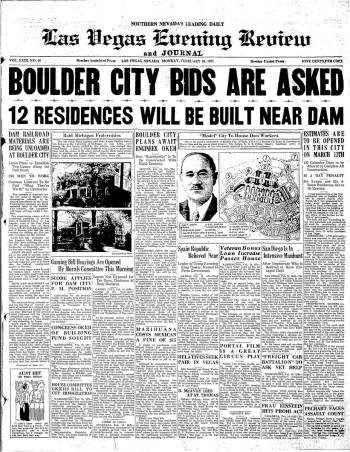
On this day in 1931, readers of the Las Vegas Evening Review first learned of plans for the development of Boulder City. “Designed on the lines of a double triangle, Boulder City is to have no cross streets,” the front page story read. “Boulevards, named after the Colorado river states, will serve as arteries, and there will be open plazas near each of the larger buildings in the business district.” A variety of trees — Southern pine, fig, date, pomegranate and palm — will be planted, the story continued. “Uncle Sam will spare no effort to make his workers in the wasteland as comfortable as possible.” Thankfully, there was a bit of forethought to the proceedings. “Allowance has been made,” the story noted, “for the possible growth and development of Boulder City beyond the eight-year period for which it is being created.”
Feb. 17:
On this day in 1983, fans began saying goodbye to the Las Vegas Convention Center, the home of the UNLV Runnin’ Rebels since 1966. We introduced readers to Jack Spicer, Dan Kempf and Linc Lageson, Tau Kappa Epsilon fraternity brothers who were among those camping out for around 36 hours — along with plenty of beer, we noted, twice — to score tickets to the final two games there. “They only have 100 floor seats for the students,” Spicer noted, “and if we don’t get here early, we wind up in the rafters.” The trio claimed they left a friend behind in each of their classes to take notes for the work they missed. “I’ve never seen this before,” said UNLV great Sydney Green, who was cheered during a brief appearance. “This is what I call student involvement.” UNLV won those final two games — 84-81 against San Diego State and 111-78 over Utah State — before moving to Thomas & Mack that fall. Those also were the final two home games for Green, who would be the fifth overall pick in that year’s NBA draft, kicking off a 10-year NBA career.
Feb. 18:
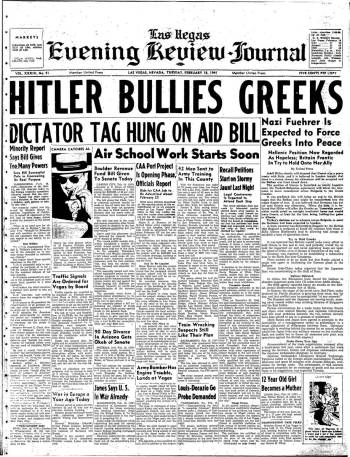
On this day in 1941, amid a front page that also featured Adolf Hitler and the first photo of Al Capone after his release from Alcatraz, readers of the Las Vegas Evening Review-Journal learned that traffic signals were coming to Fremont Street. City commissioners approved spending $1,376.85 for the signals and $1,040.25 for the installation of the lights from Main to Fifth. “Under the present plan, the lights will be installed in the center of the street intersections and will not be equipped with either bells or whistles,” we wrote, forever dashing the hopes of the bells-and-whistles crowd. “They will be three-globe affairs with green, amber and red lights, the green for the go signal, the amber for the warning and pedestrian signal and the red for the stop signal,” we explained. For the record, if you’re still getting the hang of traffic lights, please disregard that advice about amber — or, as we know them, yellow — lights being “a pedestrian signal.”
Feb. 19:
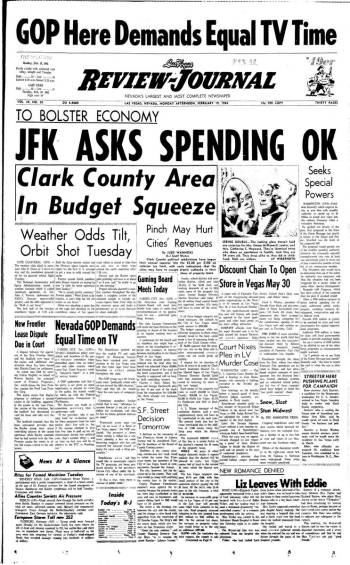
On this day in 1962, readers started getting familiar with the idea of Sahara Avenue. Members of the county planning commission had voted to retain the name San Francisco Street, while the city’s board of commissioners had favored changing it to Sahara Avenue.
County commissioners were to take up the matter the following day. The county planning commissioners were against the idea, we wrote, because “tons of documents and papers dating back to 1932 would have to be altered.” Ownership of the El Rancho Vegas, which bordered on San Francisco Street, also opposed the change. “About the only solution,” County Planning Director Murray Hoyt said at the time, “is to rename the street Rancho-Sahara Avenue.” Obviously, another solution eventually emerged.
Feb. 22:
On this day in 1957, the Review-Journal was obsessed with the weather. Also, we may have thought weathermen were some sort of sorcerers, able to conjure clouds or sunshine at will. “The weatherman,” we wrote, “after threatening to blow up a heavy storm, relented Friday morning and predicted that the huge throngs expected here for the long week end (sic) would be able to get the start of a good sun tan (sic).” Hotels and motels were filling up, we reported, and most of the resorts on the Strip were sold out for the three-day holiday. “It was quite apparent there would be a large throng of tourists in the area to enjoy the sunshine.” Fast forward to the Sunday, Feb. 24, front page: “Mother Nature turned flighty Friday night, bringing a rainstorm to Las Vegas and snow in the Spring Mountain range.”
Feb. 23:
On this day in 1965, readers were informed of a “bold experiment” in the city’s entertainment offerings: live theater in a Strip casino. Not a musical, such as “Guys and Dolls” or even “Flower Drum Song,” which had played the Strip. “Never Too Late,” a straight-up play starring Milton Berle, opened later that night at the Sahara, with shows at 8 p.m. and midnight. In a sign of things to come for producers bringing Broadway shows to casinos, the play’s running time was chopped from 135 minutes to 96. To further illustrate just how big Las Vegas’ entertainment scene was that week, a brief story near the remainder of that front-page tale noted that Debbie Reynolds had a sore throat and wasn’t able to perform the previous night at the Riviera. Frank Sinatra, who was appearing at the Sands, “volunteered to help out” and fill in for her.
Feb. 24:
On this day in 1989, readers learned of what was, at the time, the second-largest fine ever handed down by the Gaming Control Board. Ralph Engelstad, owner of the Imperial Palace, was fined $1.5 million and ordered to “do nothing that would glorify Adolf Hitler” as part of a plea agreement. Engelstad had admitted to hosting birthday parties for Hitler at his casino in 1986 and 1988, we wrote, “in a secret room where he had housed a multi-million-dollar collection of Nazi-era war memorabilia.” Which, yikes! Engelstad had claimed the Nazi collection was going to be open to the public, but state and community leaders had other ideas. The only fine at the time higher than Engelstad’s was the $3.5 million skimming-related penalty assessed to former Stardust owners Herb Tobman and Al Sachs.
Feb. 25:
On this day in 2005, readers were introduced to the latest incarnation of what would become MGM Resorts International. After a hearing lasting more than four hours, the Nevada Gaming Commission unanimously approved MGM Mirage’s $7.9 billion buyout of Mandalay Resort Group. At the time, Mandalay’s portfolio included Mandalay Bay, Luxor, Excalibur, Circus Circus and Slots-A-Fun on the Strip and Railroad Pass in Henderson. The company also operated the Monte Carlo, of which it owned half. The deal, completed two months later on April 25, was the second major acquisition of the decade for MGM, having formed MGM Mirage after taking on Mirage Resorts Inc. in May 2000.
Feb. 26:
On this day in 1958, we teased readers with the sensational headline “Sex-Triggered Urge To Kill Brings Death To High School Girl.” Then we paired it with “Teenagers Kill Cabbie In Rampage.” It’s admittedly tough to look beyond something like that at the top of the front page, even when neither event took place here. Heck, one or the other of those phrases likely was the working title for half the movies playing at drive-ins that year. Below that, though, there’s an interesting look at the battle for bragging rights between Reno and Las Vegas. Under the headline “Reno Claims Lead in Population over Vegas,” we wrote about the Reno Chamber of Commerce having declared the city had 52,500 residents to Las Vegas’ 50,000. The Las Vegas Chamber hadn’t posted new numbers, but Franklin Bills, the city’s planning director, declared Las Vegas “certainly” had more than 52,500 residents. These days, Reno’s population isn’t just well below that of Las Vegas, it’s dropped below Henderson and only ranks slightly ahead of North Las Vegas.
March
March 1:
On this day in 1930, readers of the Las Vegas Evening Review and Journal learned that many of their neighbors were a bunch of filthy animals. Under the headline “WARNING ISSUED TO TOSSERS OF DIRT BY VEGAS POLICE CHIEF,” we reported that Chief of Police Percy Nash was running out of patience with property owners who were dumping refuse in the thoroughfares, often right after they’d been cleaned by “chain gangs.” “Reports indicate that some of our most prominent citizens are thoughtlessly getting the alleys back into the same condition they were before, but this will not be permitted,” Nash said. “A close check is to be kept, and arrests will follow all known violations, no matter how prominent an individual it may be.”
March 2:
On this day in 1948, readers of the Las Vegas Evening Review-Journal were introduced to the looming scourge of daylight saving time. With California almost certain to adopt the practice because of a severe drought and power shortages, and Reno leaders considering the same move, officials began debating the effects those decisions would have on Las Vegas and Clark County. “Mayor E. W. Cragin pointed out this morning that we are dependent, to a large degree, on the people and industries of Los Angeles for our livelihood,” we wrote, “and, if that area goes on daylight saving time, it would seem only reasonable that Las Vegas should conform.” And that, friends, is why you’ll be struggling, even more than usual, to get out of bed in two weeks.
March 3:
On this day in 1962, readers were treated to a wild front page. Wilt Chamberlain’s historic 100-point outburst was teased. President Kennedy approved the first atmospheric atomic tests since 1958, assuming the Soviet Union didn’t agree to a ban. A woman we described as “pretty Margie Chambers” was convicted of prostitution after she was given $35 in marked bills and photographed in the nude. (We helpfully printed “pretty Margie’s” complete address, in case anyone was interested in her services.) And two impatient cocktail waitresses were arrested “on charges of disorderly person and investigation of grand larceny.” Apparently, they called a taxi to the Showboat Hotel, waited a bit, then drove off in the first unattended cab they saw. They were soon apprehended on Fremont Street.
March 4:
On this day in 1953, readers were given a peek into the future of downtown Las Vegas. City commissioners were to vote that evening on abandoning the 40-foot height restriction on buildings. Mayor C. D. Baker stood alone in his support of the height limit, we reported, because tall structures here would “stand out like a lily in a cabbage patch.” Worried about “the terrific prices asked for front footage in the downtown area,” we wrote, three city commissioners agreed “it is necessary that the buildings go upward instead of taking up a great area on the ground.” The plan voted on that night was to allow structures up to 12 stories tall. Circa, the newest addition to the downtown landscape, stands at 35 stories.
March 5:
On this day in 1936, readers of the Las Vegas Evening Review-Journal were reminded of what a quaint town they called home. A petition signed by “nearly 100 per cent (sic) of the larger retail grocery, meat and vegetable stores in the city” had signed a petition asking that city commissioners pass an ordinance requiring them to close on Sundays. During the commission meeting, it was decided that simply having the retailers agree to do that themselves was somehow less practical.
March 8:
On this day in 1940, readers of the Las Vegas Evening Review-Journal were treated to sensational news out of Hollywood concerning a plot to kidnap 17-year-old Judy Garland. Police rushed to protect the starlet who, according to the wire service report, “was quite thrilled about the whole thing.” There was a bit of Hollywood in Las Vegas on that day’s front page, as well. Oliver Hardy, who we described as “plump movie comedian” and “the ponderous half of the Laurel and Hardy comic team,” wed studio script girl Virginia Lucille Jones here.
March 9:
On this day in 1949, readers of the Las Vegas Evening Review-Journal learned of the revival of a plan to make Bonanza Road the longest street in the world. The proposal would have called for the main street in every community between Lake Tahoe and Lake Mead to be renamed Bonanza Road, we wrote, “as a colorful tribute to Nevada’s picturesque history.” The idea gained steam years before until it was derailed by World War II. One of the streets that would have been renamed? Fremont.
March 10:
On this day in 1989, readers learned of the approval of plans for the $3.5 billion project then known as Lake at Las Vegas. Members of the Flood Control District approved a variance allowing for the construction of a 318-acre lake five miles east of the Sam Boyd Silver Bowl. The proposed development was to include six hotels, five golf courses and about 3,000 residences. “We’re now going to be a key player as a resort-destination community,” Henderson City Manager Phil Speight said at the time. “It offers the state of Nevada something that it doesn’t traditionally have, and for us it means a lot of money, too.” Preliminary studies, we wrote, showed the project will bring about $15 million annually in tax revenues to Henderson. Much of the project, eventually simplified as Lake Las Vegas, filed for bankruptcy protection in 2008.
March 11:
On this day in 1974, we were very captivated by streakers. Sure, there was much ado about kidnappings elsewhere on the front page, but they didn’t seem to capture our imagination quite like the idea of people running around nekkid in public. As part of a roundup on the fad, we reported that two sneaker-clad streakers gave motorists on the Hoover Dam a “here-they-come, there-they-go” view before they escaped in a car parked on the Arizona side. Three streakers were reported during separate incidents at the Golden Valley Acres Trailer Park. Club Bingo in downtown Las Vegas was hit by a streaker. Then there was the story of the Las Vegas Outlaws hockey match at the International Ice Palace that was twice interrupted by streakers on the ice. Under the headline “Bare pair sweetens game,” we credited the streakers for spurring on the home team to a wild 16-7 win over West Covina. Given the sheer volume of public nudity seemingly on display, perhaps we should have been more taken with the idea of a 16-7 hockey score.
March 12:
On this day in 1940, readers of the Las Vegas Evening Review-Journal were once again reminded of what a small town they called home. The front page told of a photographer, writer and two models from Look magazine who were arriving by plane from Chicago the next day to document the city. And, for the second straight year, “all stores and business houses” agreed to close between noon and 3 p.m. on Good Friday. Las Vegas was one of few cities to do that the previous year, we reported. “Everyone seems willing to go along,” we quoted a group of pastors as saying, “because they believe it a worthy occasion and because they are mindful of the fine publicity this ‘frontier town’ received as a result of last year’s closing.”
March 15:
On this day in 1970, readers learned that the four-day strike by hotel workers and the culinary and bartenders unions that had all but shut down the Strip had come to an end. When picket lines were set up at the International Hotel, the Desert Inn and Caesars Palace, management locked out unions at the other 13 hotels represented by the Nevada Resort Association. Room guests were then asked to leave as the 16 hotels closed for the first time in their history. Estimates of the economic loss ranged up to $3 million a day. “Caesars Palace flung open the doors to its casino one minute after midnight, turned on the Roman fountains and blinked its ‘welcome’ sign out front,” we reported. “Ironically it was the Ides of March.”
March 16:
On this day in 1931, readers of the Las Vegas Evening Review and Journal could begin bracing for the influx of the unhappily married. The state senate passed a house measure that day that cut the residency requirement to obtain a divorce in Nevada from three months to six weeks. At the time, many states required a year for a divorce to be finalized. Divorce ranches, places where women (and some men) could essentially vacation in luxury while waiting for the end of their marriages, began springing up in Reno and Las Vegas, adding to the state’s burgeoning tourism market. You can still visit the sites of two divorce ranches at what is now Lorenzi Park and Floyd Lamb Park at Tule Springs.
March 17:
On this day in 1960, readers learned that the local chapter of the NAACP had called for the complete integration of hotels and all other businesses in the city. “Basically, we want the segregation practice dropped for we feel it is the right of all people to patronize these places as long as their conduct is good,” said Dr. James B. McMillan, the local president. He added that he had requested a meeting with city officials and business leaders as soon as possible. Should a solution not be found rapidly, McMillan alluded to the possibility of a “spontaneous” peaceful demonstration. With the idea of a march down the Strip firmly implanted in the minds of local leaders, an agreement on integration was reached March 26, 1960, during a meeting at the Moulin Rouge.
March 18:
On this day in 1953, readers of the Las Vegas Morning Review-Journal were treated to accounts of a “man-made atomic earthquake” in stories datelined Atom Bomb Site, Nevada. “Of 1,000 troops and 500 other military and press observers, not a one was scratched or burned or suffered ill effects from radiation,” according to a wire service report about the atomic test. Of the two test houses, the one 3,500 feet from the detonation point was collapsed by the blast, while the one 7,500 feet away was littered with broken glass and declared uninhabitable. “I was among those in the front trenches,” reporter Elton C. Fay wrote. “First you are shaken by ungodly power. You can’t see a thing for the dust. A pressure wave surges over you. Rocks hiss by, carrying death. But you live and are surprised to find that you are not greatly frightened. But you are awed.”
March 19:
On this day in 1946, readers of the Las Vegas Evening Review-Journal got their first taste of a hotel that sounds an awful lot like the Flamingo, the resort that’s widely credited for shaping the Strip. “Construction of an elaborate, modern, 120 room resort hotel, to cost approximately $1,250,000, is under way on the Los Angeles highway, approximately two miles south of Las Vegas, it was announced this morning by Billy Wilkerson and associates, owners,” we wrote. “The rooms are patterned after those in the Statler hotel in Washington, which is considered the last word in modern hotel construction. Beds will make up into davenports for day use, each room will be individually air-conditioned with guests able to regulate the temperature to suit.” Plans call for a formal opening around Thanksgiving, we added. Wilkerson, founder of The Hollywood Reporter, started the Flamingo, which eventually opened on Dec. 26 that year. Wilkerson ran into massive cost overruns as a result of high wartime costs of materials, allowing Benjamin “Bugsy” Siegel an opening to seize control of the resort.
March 22:
On this day in 1949, readers of the Las Vegas Evening Review-Journal were treated to a couple of sensational stories. It’s hard to look at that front page and see anything other than the headline at the bottom: “Medics Count 400 Wounds in Girls Knifed During Teen-age Petting Orgy.” (This was in San Diego, and the two girls were expected to recover.) Earlier that day, Vail Pittman, Nevada’s governor, had vetoed a local option prostitution bill, saying he did so “with full knowledge that morals and virtue cannot be legislated into a people.” He also wanted to ensure that the “name of Nevada should be synonymous with personal liberty but not licentiousness.” Tied up in the story, and Gov. Pittman’s decision, was another round of calls by angry locals to shutter the Roxie motel, where prostitution was an open secret. The unfortunate headline on that story? “Aroused Vegans Demand Closing Of Roxie Club.”
March 23:
On this day in 1934, readers of the Las Vegas Evening Review-Journal were greeted with a banner headline warning of the anticipated record number of visitors. “With all known accommodations completely sold out for the next two week-ends (sic), officials of the Las Vegas chamber of commerce were working feverishly today in an effort to line up rooms for the horde of visitors slated to descend on the community tomorrow and next Saturday,” we wrote. “This is not merely a question of renting rooms,” said chamber president A. C. Grant. “It is a question of Las Vegas’ ability to take care of her visitors. It is of the utmost importance to us that no tourist goes away with an unfavorable impression, and I am calling on every resident of the city to go out of his way to provide quarters for visitors. We MUST take care of them all.” A couple of groups whose members numbered in the dozens were expected to visit the under-construction Boulder dam. “There will be many groups numbering from 10 to 12 persons,” we wrote, “and an expected additional 3,000 unattached persons.”
March 24:
On this day in 1994, readers learned that UNLV was in need of a new president. Robert C. Maxson, who’d held that post since 1984, resigned to take the same position at Long Beach State University. Maxson “leaves a legacy of rapid campus growth,” we wrote, “that was sometimes overshadowed by bickering over the basketball team.” That “bickering” led many Las Vegans to blame Maxson for the ouster of legendary coach Jerry Tarkanian. A victory march was planned in front of the campus by a group who’d been calling for Maxson’s removal. “I’m obviously really happy for the university, and I think it’s the right move for him,” Tarkanian said. “I think as long as he was there (at UNLV), there was going to be nothing but problems. I hope it works out well.” Tarkanian, we noted, was speaking on the phone from Daytona Beach, Florida, where he was judging a swimsuit competition.
March 25:
On this day in 1958, readers learned that three local housewives had not, in fact, struck oil. When they turned on their faucets the previous day, in addition to water, the women were met by a gush of oil. Their perceived fortune, however, was short lived. “Oil slick from a well pump in the District’s well field escaped into the reservoir and by a long-shot mishap entered a discharge line,” we wrote. Service crews were dispatched to the three homes to clear the lines and, presumably, deliver the bad news.
March 26:
On this day in 1957, readers were greeted with a headline fat-shaming the president of the International Brotherhood of Teamsters (“Portly Dave Beck, Teamster’s Boss, Defies Senate Probers”). Elsewhere on the front page, a local grocer was heading to court over the calibration of his butcher scale. Lida Hunt claimed she purchased a ham that weighed six pounds on the scale at Elite Market on Main Street, only for the same ham to weigh five pounds, three ounces elsewhere. Earl Voss, we wrote, was charged with violating the state’s false weight statute.
March 29:
On this day in 1940, readers of the Las Vegas Evening Review-Journal were treated to the tale of a well-dressed robber. “An audacious ‘gentleman’ burglar, perfectly groomed and using quite, quite correct speech,” we wrote, ransacked the bedroom dresser of one Ryland Taylor of South Sixth Street. “The burglar quite leisurely and quite pleasantly conversed with the Taylors as he completed his job of getting his loot,” we added, “and when he was finished he excused himself and departed.” According to the Taylors, he was “quite well dressed and appeared to be almost freshly shaven.” The “gentleman” made off with $10 and a string of pearls.
March 30:
On this day in 1979, readers learned of the looming local effects of the ongoing energy crisis. Of the 60 gas stations polled by the Review-Journal, 41 were planning to be closed that Sunday because of fuel shortages. Employees of Shell, Mobil and Union 76 said their April supply would be lowered between 5 and 10 percent because of the reductions in oil imports from the Middle East. More than half the stations polled reported they were closing earlier, and several 24-hour stations had begun closing between 10 p.m. and 6 a.m. “We might have enough gas to last the rest of the night,” reported an employee of Walt’s Chevron Station on Bonanza Road. “We are supposed to get another allocation gas shipment on April 1, but until then, we’re playing it by ear.”
March 31:
On this day in 1973, readers were greeted with some good news: Three former prisoners of war were honored during their return to Nellis Air Force Base. Col. Richard Dutton of North Las Vegas, Col. Dwight Sullivan of Las Vegas and Maj. Richard Smith of Las Vegas had been in captivity since October 1967. “All three of the men were slightly thin, but appeared to be in good spirits,” we wrote. “Like their wives, they wore smiles from ear to ear throughout the homecoming proceedings.” Dutton said he had been enjoying eating meat, fruits and fresh vegetables since he was freed. Sullivan was looking forward to getting reacquainted with his children and relaxing. Smith was met by his three children, who couldn’t wait to show him the horses they’d acquired since he’d been gone. The three men were given keys to the city, city flags and plaques bearing the city emblem. Their wives were presented with orchid corsages, coasters and hot plates engraved with the city seal.
April
April 1:
It takes a lot to look past a banner headline blaring “MURDER HUNT IN VEGAS,” but on this day in 1964, there was a very good reason to do just that. Local beauticians were apparently enraged by the idea that the town’s barbers were trying to force them to join the International Barbers Union. “Ordinarily a peace-loving group by anybody’s standards,” we wrote, “the mild-voiced artisans who usually occupy themselves with the delicate duty of directing traffic on milady’s scalp Tuesday resembled stevedores at a dock rumble.” Mondel Myers, president of the Las Vegas Hairdressers Association, warned against infighting among the assembled groomers. “But his words,” we added, “obviously failed to penetrate some of the shaggier sideburns.”
April 2:
On this day in 1983, readers had a vivid account of the opening of Cashman Field. Steve Garvey scored the first run in the new stadium as the San Diego Padres tied the Seattle Mariners 1-1. A crowd of 13,878 crammed into the stadium built for 9,370 to see the game that was called after 10 innings because the Mariners had to catch a plane. “The prices of the food are outrageous,” complained baseball fan Cary Degrosa. “The beers are $2 and a dinky Coke costs $1.” San Diego manager Dick Williams noticed the smell of marijuana that drifted onto the field. For anyone who’s followed one of the biggest complaints about the stadium during its decades of use, you’ll be glad to know that the plumbing backed up into the dugouts before that game, too.
April 5:
On this day in 1950, readers learned of a movement to allow liquor and gambling licenses in Henderson. During a meeting of the Colorado River Commission, William Byrne, one of the group’s leaders, presented petitions containing several hundred names in support of the idea. Petitions containing approximately 500 names who backed the current ban were presented, as were letters from Stauffer Chemical and Western Electrochemical in favor of the status quo. The ban began in 1948, when the commission requested the county licensing board refrain from issuing and gaming or liquor licenses in Henderson, which was still being referred to as a “townsite.” The City of Henderson wouldn’t be incorporated until April 16, 1953.
April 6:
On this date in 1955, readers got more details about what may have been the first atomic fireball they’d ever seen. “For about five seconds this morning brilliance (sic) of the sun over Las Vegas was supplanted by a stronger light when an Air Force B-36 intercontinental bomber dropped a ‘baby’ atomic device at 10 a.m. over Yucca Flat at an altitude in excess of 30,000 feet,” we wrote. “John F. Cahlan, managing editor of the Las Vegas Review-Journal, who witnessed this morning’s air burst, said the flash appeared as a ‘brilliant orbit, whose outer edges were blindingly white, with a core of orange and yellow.’” The altitude meant the blast was visible to more Las Vegans. It also meant, we reported, that little radioactive fallout was expected.
April 7:
On this day in 1933, editors of the Las Vegas Evening Review-Journal were concerned with one thing: beer. Four stories on that day’s front page helped cover the return of legal beer after the Cullen-Harrison Act, which removed the beverage from the ranks of Prohibition, went into effect. “That pale, amber fluid, known to the oldsters of the city of Las Vegas as ‘good, old-fashioned beer’ and hailed by the younger generation as just plain brew,” we wrote, “was to make its bow in the city of Las Vegas this afternoon sometime after five o’clock, with a huge flock of citizens raising a thirst, waiting for its welcome.”
April 8:
On this day in 1940, readers of the Las Vegas Evening Review-Journal were updated on the plans for Boulder City’s first high school. A construction contract was awarded to an Elko firm, which had 150 days to complete the project. The new structure will be 96 feet by 102 feet, we reported, “and will include a gymnasium, a manual arts room, a science laboratory, a domestic science room, lavatories” — always a welcome addition to any high school — “shower rooms and dressing rooms.” The winning bid: $48,124 for the building and $1,320 for plumbing. Until the new school was ready, some 100 high school students from Boulder City were attending classes in Las Vegas.
April 9:
On this day in 1958, readers were treated to some pretty important news. No, not the banner story about the fact that construction on the new Clark County courthouse could begin the following week, although that was important. Farther down the front page, we declared that spring had officially begun. “No matter what the groundhog does with his shadow, and no matter what the weather experts declare,” we wrote, “spring does not come to Las Vegas until the cotton begins to fly.” Apparently that stemmed from the tradition of waiting until the cottonwoods had budded before planting spring crops, and that day, cotton was in the air. Another old-timey tip from that story: mesquite trees “are always the last to bud out, and when the leaves come on them, hot weather is only weeks away.”
April 12:
On this day in 1951, when most of the front page was dedicated to the furor over President Harry Truman’s dismissal of Gen. Douglas MacArthur, we still found room for a little local crime news. “A touchy French butcher was in jail today,” we wrote, “after assertedly stabbing a co-worker in the chest for ‘making fun of him.’ ” French native Jean Pierre Artaut was being held on assault charges after police say he charged across the kitchen of an unnamed Strip hotel and stabbed one of the cooks with a boning knife. Witnesses said the victim, who hadn’t yet decided if he would sign a formal complaint, was laughing about something the head chef said to one of the waitresses that had nothing to do with Artaut.
April 13:
On this day in 1936, readers of the Las Vegas Evening Review-Journal learned that the city was being overrun by newlyweds. Under the headline “Honeymoon Pairs Besiege Las Vegas,” we reported that over the past weekend, 28 couples were granted marriage licenses. That closely approximated the highest number ever for the area. More licenses already had been granted that year (605) than during the entire previous year (554). By comparison, in pre-COVID 2019, Clark County issued 73,143 marriage licenses.
April 14:
On this day in 1941, readers of the Las Vegas Evening Review-Journal were introduced to what would become the El Cortez. Under the headline “Work Is Started on New $245,000 Las Vegas Hotel,” we wrote about the new three-story, 91-room project. “It will be modern in every respect and is expected to help in answering the growing problem of housing facilities for the increasing number of tourists who are coming to Las Vegas,” we wrote. The building we be air-conditioned, we added, and “there will be sun decks on the roof and a patio in the rear of the hotel for those who desire sun bathing on the desert.”
April 15:
On this date in 1947, readers of the Las Vegas Evening Review-Journal got a taste of what could have become a decent Wesley Snipes movie. “Knife Fight Staged Above Vegas Endangers 54 Airliner Passengers,” the headline blared. Two passengers, one from Pasadena, California, the other from Oklahoma City, apparently became unruly shortly after the Denver-bound plane left Los Angeles. One of them then picked up a dinner knife and threatened the other. “About half the passengers were running up toward the front to see the fight and the other half were running toward the back to get away from it,” said E.A. Duarte, the off-duty Los Angeles police sergeant who broke up the fight. The pilot circled Las Vegas for 20 minutes waiting for the brawl to end so he could land and get them off the plane, we wrote. In their jail cells that morning, neither man could remember why the fight started.
April 16:
On this day in 1976, readers learned that State Sen. Floyd Lamb had been indicted by a federal grand jury on charges that he filed false income tax returns for the years 1969-72. “I am absolutely innocent of the charges and I’ll prove it in court,” Lamb said in a statement. Lamb was acquitted of those charges, but in 1983, he was convicted for attempted extortion in the FBI sting dubbed Operation Yobo and sentenced to three years in prison. Lamb, the older brother of longtime sheriff Ralph Lamb, died in 2002.
April 19:
On this day in 1934, readers of the Las Vegas Evening Review-Journal got an early taste of the tourism boom that was to come. Below a story about the hunt for John Dillinger and an update on a human leg that was found in a sand dune just west of town, we reported a 118 percent jump in tourists over the previous March. Much like now, the vast majority of visitors arriving by car — 81 percent — came from California. Travelers were starting to spread out their vacations throughout the week, we reported. Boulder Dam saw its most visitors ever — 5,461 — over the March 24-25 weekend, we wrote. By comparison, with approximately 7 million visitors each year, Hoover Dam now welcomes an average of 38,356 guests every two days.
April 20:
Las Vegans have been worried about the water level in Lake Mead almost as long as there’s been a Lake Mead. On this day in 1946, readers of the Las Vegas Evening Review-Journal learned that Lake Mead was at its lowest ebb in history. A dry winter in the watershed suggested levels wouldn’t bring the water level back to anywhere near normal, we reported. The previous Saturday, the lake was 0.05 feet away from its all time low mark of 1,146.54 feet above sea level, due in part to a years long ramp up of its energy production for the war effort. As of April 19, 2021, the level was 1,081.98 feet.
April 21:
On this day in 1971, readers learned of some old-fashioned corporal punishment doled out by a municipal judge. In sentencing an unemployed 22-year-old North Las Vegan convicted of whipping a 4-year-old girl with a belt, Judge Ray H. Daines gave the man a choice between 20 days in jail or 10 lashes. He chose the lashes. The man reported to the front steps of city hall, where a municipal court bailiff removed his belt, we wrote, had the man “bend over and touch his knees, and let fire with 10 stiff lashes.” When some observers referred to the public punishment a flogging, Daines deemed it a “spanking in return.”
April 22:
On this day in 1990, readers got their first look at the formerly top secret F-117A Stealth fighter — that is, assuming they weren’t part of the estimated 100,000 people who caught a glimpse at Nellis Air Force Base during its first public display. “Some aviation buffs were flabbergasted that the aircraft’s engines aren’t visible and that weapons are carried inside,” we wrote. “They also marveled at the aircraft’s shape, as angular and faceted as the Nevada mountains serving as the backdrop.”
April 23:
On this day in 1940, readers of the Las Vegas Evening Review-Journal learned of a father’s hunger strike. Cement and lumber contractor H.L. Evans said his wife left with their 2-year-old child seven days ago. Since they left, Evans said he had subsisted solely on six or seven cups of coffee a day. He vowed that he won’t eat again “until my baby is returned to me.” “A husky 200-pounder,” we wrote, “Evans at 38 has a splendid physique and appears able to stand the fueling test he has set for himself.” Evans, though, said he didn’t know how he would get word to his wife of his determination.
April 26:
On this day in 1968, readers learned just how little gamblers on the Strip cared about the Atomic Energy Commission’s largest underground test up to that point. “Chandeliers swayed, pictures tilted, plumbers and electricians stood at the ready,” we wrote. But, according to a pit boss at The Dunes, “The dice kept rolling through it all.” Some players left to stand in the street, but feeling nothing soon returned. The 7 a.m. test near Beatty “blasted out a cavern big enough to swallow up Hoover Dam.”
April 27:
On this day in 1999, readers got a preview of the new interchange connecting eastbound U.S. Highway 95 and Interstate 15 South in the Spaghetti Bowl. “Nearly 39 feet wide, the ramp will carry two lanes of traffic and accommodate more than 3,600 vehicles an hour,” we wrote. “The existing one-lane ramp, which will be dismantled, handles about 1,600 vehicles an hour.” Following a ribbon-cutting ceremony, the first vehicles were expected to be allowed on the new ramp sometime after that day’s evening rush hour. The 1,581-foot ramp was ready to open more than four months ahead of schedule.
April 28:
On this day in 1950, readers were informed of the renaming of Las Vegas Air Force Base. The base was to be known as Nellis Air Force Base effective April 30. The action, we wrote, was in conjunction with the Air Force policy of renaming bases in honor of Air Force heroes killed during World War II. Lieutenant William H. Nellis, a Clark County resident who lost his life in aerial combat, was a unanimous choice by local civic organizations, we wrote.
April 29:
On this day in 1973, readers learned of a “small scale riot” at a local concert. More than 50 members of law enforcement responded to the disturbance at the Las Vegas Convention Center, which received “quite a bit of property damage.” About 6,000 people were at the concert when it was announced the headlining act couldn’t appear because of an illness. Tempers flared. Eleven adults were booked for investigation of malicious destruction of private property, we wrote, with five juveniles facing similar charges. The band whose absence started all the destruction? Deep Purple.
April 30:
On this day in 1946, readers of the Las Vegas Evening Review-Journal were treated to plans for a flying casino. The idea wasn’t quite as futuristic as it sounds, though. Back when air travel was seen as something exotic, local casino operators Duke Wiley and Eddie Alias announced their idea for a gaming airline that would service Las Vegas and Reno. Music and other entertainment would be available, as would games of chance, during the three-hour flight between Nevada’s two largest cities. The most remarkable part of the announcement, in retrospect, is that it used to take three hours to fly to Reno.
May
May 3:
On this day in 1985, readers learned of a scam so outlandish, it’s hard to believe anyone was taken by it. A Hawaiian businessman told Las Vegas police he met a man who claimed to have “secret chemicals” that turned $1 bills into $100 bills. After thinking two of the bills “changed” while he was distracted by an accomplice, the target returned to Hawaii and borrowed $30,000 from friends. After the target “accidentally ruined” that batch of chemicals and bills, he wired for an additional $24,000. Days later, when the second batch of bills was supposed to have been “changed,” yet obviously didn’t, the target finally contacted police.
May 4:
On this day in 1984, readers learned of a breakthrough in the monthlong strike by members of the Culinary, Bartender, Musicians and Stagehands unions against 32 hotels. Members began returning to work that day at the Las Vegas Hilton and Flamingo Hilton, after their unions reached agreements with those properties. Casino legend Jackie Gaughan said he would sign the same contract for his El Cortez and Western hotels. More than 3,000 workers, who’d been on strike since April 2, were expected to return to work that day.
May 5:
On this day in 1987, readers were treated to coverage of the opening of Don Laughlin’s bridge. For years, the casino owner had tried to get Nevada, Arizona or both to build a bridge between Bullhead City, Arizona, and the town that bears his name. He even offered to pay for it to shorten the 12-mile trip north across Davis Dam and south again. With no takers, Laughlin contracted a construction company and paid the $2.7 million cost himself. The previous day, his birthday, Laughlin celebrated the opening with a ribbon cutting before donating the bridge to the two states.
May 6:
On this day in 1935, readers of the Las Vegas Evening Review-Journal were greeted with news of the impending arrival of fish. So very many fish. Black bass will be added to the lake above Boulder Dam, we wrote, and “30,000 of these finny hordes” will leave a federal hatchery in Dexter, New Mexico, on June 15. They were expected to arrive two days later. Every five days, 30,000 more would set out for the lake until it was stocked with 180,000 bass. There would be a two-year ban on fishing those waters so the bass could mature, we wrote. “It is expected, when the waters of the lake are finally thrown open to the fishermen, they will provide one of the best game fish areas in the southwest, outside of the Pacific Ocean.”
May 7:
On this day in 1980, readers learned of yet another attempt by Wayne Newton to purchase the Aladdin. The singer had signed a letter of understanding, we wrote, after a bid by Johnny. Carson and Ed Nigro, the Aladdin’s general manager, was rejected. The purchase price was not reported, although Gaming Commission Chairman Harry Reid said it was similar to the $103 million offered by Nigro and “The Tonight Show” host. Newton had been trying to buy the resort for months. The Carson-Nigro deal was at least the fourth to fall through, we wrote, since four Aladdin officers were convicted of hidden ownership charges last March by a Detroit federal jury.
May 10:
On this day in 1941, readers of the Las Vegas Evening Review-Journal were treated to a good, old-fashioned tale of sensationalism. There were reports that Alfred Wells, aka the “mad hunchback killer of Cajon Pass,” had been spotted in Las Vegas, with the “death car” said to have been found in a local garage. Wells, we wrote, “slew his sister-in-law and her girl friend, and is believed to have done away with his own brother before coming to Las Vegas.” Wells was captured in Spokane, Washington, a month later and executed in the San Quentin gas chamber in December 1942.
May 11:
On this day in 1939, readers of the Las Vegas Evening Review-Journal got an early taste of that evening’s kickoff to the fifth annual Helldorado celebration. While waiting for the parade, a horse and buggy, operated by the General Motor Parts store, got loose and collided with an automobile — with the auto sustaining the worst damage. After the buggy smashed into the parked car, we wrote, “The horse pulled the seat out of the wagon and continued on his way, leaving the vehicle he was hitched to draped around the automobile.” Cowboys on horses chased down the horse after about 10 blocks in what we reported was the first incident involving a runaway horse in the city in 30 years.
May 12:
On this day in 1930, readers of the Las Vegas Evening Review-Journal learned that many of them would be getting mail delivery for the first time later that week. As part of a local post office expansion, an additional 62 blocks on the city’s East Side would be gaining service, along with an extra 48 blocks on the West Side. Parcel post deliveries also were being added. In order to receive mail delivery, which would be conducted by bicycle, we wrote, residents would have to notify the post office that they wanted the service, erect a mailbox on their property and number their house.
May 13:
On this day in 1955, readers were greeted with the eye-catching headline “Vegas ‘Love Captive’ Found Dead.” For those of you unfamiliar with 1938 scandals, Thomas. W. “Tommy” Warner Jr. moved to Las Vegas that year and “was quite a familiar figure around the casinos and night clubs of that era,” we wrote. The son of a prominent businessman, Warner was spending so much time with divorcee Jean McDonald, his father accused her of holding the 21-year-old as a “love captive.” Warner reported that he was “perfectly contented” and later married McDonald. Warner, described as a “multi-millionaire playboy,” was found dead at his mother’s estate in Pasadena, California. He’d apparently gone to the rear of the mansion to enter without waking her, tumbled off an embankment and broken his neck.
May 14:
On this day in 1979, readers learned of the effects the gasoline crunch — one far more serious than what’s currently being felt in parts of the Southeast — was having on Las Vegas. As opposed to hotels, motels in the city relied mostly on drive-in traffic back when travelers apparently made such distinctions. Motels in the city saw significant drops over the previous weekend as many drivers stayed home. An “awful lot of cancellations” were to blame at motels, which had become accustomed to selling out during May. Because of fuel fears, several motels reported being less than half full.
May 17:
On this day in 1960, readers learned of the demise of the “headless skier.” The papier-mâché statue of a crouched skier, a gift from the Olympic Games Committee in Squaw Valley, California, had been mocked since its arrival at the Dula Memorial Center at Bonanza Road and Las Vegas Boulevard. After plenty of comments from residents, including “this is a sight that will cause tourists to think we’re nuts,” someone lopped off the statue’s head. A few days later, the rest of the statue was nowhere to be seen.
May 18:
On this day in 1965, readers learned of the loss of Bonanza Airlines. The only interstate airline based in Las Vegas announced it was moving its operations to Phoenix, with the company’s board citing the state’s use tax on aircraft and parts as a major factor. Between 350 and 375 Las Vegas-based employees would be relocated, we reported, slashing some $3 million from local payrolls. Had that move not occurred — and had the airline not gotten lost in a series of mergers and acquisitions — that gleaming black orb along Interstate 15 could have been known as Bonanza Stadium.
May 19:
On this day in 1976, readers were greeted with a headline that took up more space than the story it accompanied: “SINATRA ANNOUNCES HE’S GOING TO MARRY.” Frank Sinatra, who was performing at Caesars Palace that week, had confirmed his plans to wed Barbara Marx, the former wife of entertainer Zeppo Marx. Because this was 1976, she was referred to as having been Sinatra’s “steady girl for four years.” Fred Skidmore, a spokesman for the singer, said, when asked about the wedding, that Sinatra replied in true Sinatra style: “Yes it is true, and besides, it is nobody’s … business.” The marriage was Sinatra’s fourth, final and longest, lasting until his death in 1998.
May 20:
On this day in 1946, readers of the Las Vegas Evening Review-Journal were confronted with a front-page editorial beneath a story, headlined “Clark Traffic Butchery Continues,” about weekend car wrecks that claimed two lives. Those raised the death toll to five in the previous week. “We are living in an era of speed,” we wrote. “Automobiles are being used to get us to our destination in the quickest possible time. We don’t have time to wait and, as a result, we take chances which, ordinarily, would not be risked.” We added: “One always should remember that there are others on the highway who have the same inherent rights as the other fellow. Too many of us do not observe that rule. As a result, accidents occur.”
May 21:
On this day in 1961, readers were met with possibly the only story that could have overshadowed the turmoil in Alabama and the violent beatings of the Freedom Riders in Montgomery on the front page.. The previous day, Alan B. Shepard had made a surprise visit to Nellis Air Force base, two weeks after he’d become the first American in space. “He wasn’t noticed for several minutes after his arrival,” we wrote, “but when word got around, Nellis Air Force Base was reportedly a beehive of whispers and excited comments that ‘the astronaut is here!’” Shepard strolled around the base for about two hours and signed autographs for excited waitresses in the commissary. A NASA spokesman said he made the cross-country training trip to remain eligible for flight pay, something he did not receive for his historic trip to outer space.
May 24:
On this day in 1953, readers learned that the state was fighting to keep its atomic tests. The Nevada proving grounds, we wrote, had become the “focal point of neighboring states’ sniping on the grounds that radioactive clouds after tests are posing a danger to their residents.” Rep. Douglas Stringfellow of Utah had asked that the tests be brought to a speedy conclusion because they were inconveniencing his constituents in St. George. The Salt Lake Tribune demanded they be abolished on the grounds that they were “annoying,” we added. “In my opinion,” Gov. Charles Russell said, “there has been a minimum of danger incurred to the people of this state or any other state.”
May 25:
On this day in 1984, readers got an inside look into the strike by members of the Culinary and Bartenders unions that had affected business at 13 hotels since April 2. Shortly after reaching an agreement the previous night, a Thursday, Culinary leader Jeff McColl learned the union members wouldn’t be allowed to return to their jobs until after the upcoming Memorial Day weekend, during which replacement workers would continue to be paid. “I would encourage all the scabs to steal everything that isn’t tied or locked down,” McColl fumed.
May 26:
On this day in 1981, readers learned of the exploits of their fellow Las Vegan Daniel Goodwin. The 25-year-old, clad in a Spider-Man costume, scaled the outside of the Sears Tower as police and bystanders watched. Goodwin, the Associated Press wrote, “was handcuffed and taken into custody as he reached the roof of the 110-story steel-and-glass building … after defying 40 mph winds and the best efforts of authorities to stop his ascent.” Patrolman Jack Rimkus said Goodwin carried 50 to 60 pounds of equipment during his climb, including rope, suction cups and metal binders.
May 27:
On this day in 1960, readers got a preview of that night’s welterweight title bout between Don Jordan and Benny “Kid” Paret. With the fight at the convention center, Las Vegas law enforcement was planning to be out in force to surveil “out-of-town hoodlums,” we wrote. City and county lawmen, we added, were “putting out the ‘unwelcome’ sign.” Apparently, though, as long as those ne’er do wells stayed on the Strip, everything was hunky dory. “We are figuring that the hoods will confine themselves to the Strip, and we haven’t any indications that they will come downtown,” said Police Chief Ray K. Sheffer. “If they do, our officers will keep a close check on their activities and contacts.” Paret took the belt off Jordan by unanimous decision.
May 28:
On this day in 1957, readers learned that Barbara Fechser, 23, of Las Vegas, described as “an attractive blonde mother of three children,” had been granted three years probation. Fechser had pleaded guilty to masterminding the robbery of a cafe in Baker, California, the previous fall. She reportedly told police she had previously dated the cafe’s owner, rented the car that was used in the robbery and paid for the revolver that was used to shoot him as he ran away. Fechser’s attorney, former state senator Ralph E. Swing, had informed the court that she had three children and, if she were sent to jail for the recommended 30 days, the children would have to live with their grandmother. “That is too much to ask of any grandmother,” he told the court. Many prominent Nevadans joined Swing’s plea for leniency, we wrote. Left unsaid was the fact that his client’s full name was Barbara Binion Fechser, and her father was gambling icon Benny Binion.
June
June 1:
On this day in 1994, readers learned that Clark County officials were running out of patience with the under-construction Stratosphere. City officials had approved a height of 1,012 feet for the tower, but the project’s developers were seeking an increase to 1,825 feet. The Federal Aviation Administration had determined that, based on its location, any structure taller than 781 feet would be considered hazardous. County commissioners, who were responsible under state law for mitigating any such hazards, authorized the district attorney’s office to use any legal means necessary to stop the tower’s expansion. Spoiler alert: The tower now stands at 1,149 feet.
June 2:
On this day in 1966, readers read about the Survey 1 lunar lander having arrived safely on the moon and having transmitted images of its surface. Lower on the front page, we wrote about that day’s opening of the Four Queens — or, at least, the first eight stories of it. The remainder was to be built over the following 24 months. Among the grand opening celebrations was a giveaway offering “a mortgage-free home built to the winner’s specifications anywhere in the United States.” Other awards included an eight-carat diamond ring, mink stoles, color television sets, boats, refrigerators and rifles.
June 3:
On this day in 1987, readers learned that City Councilman Ron Lurie had been sworn in as Las Vegas mayor, having outpolled his challenger, gaming legend Bob Stupak. “At his campaign headquarters Tuesday night, Lurie entertained hundreds of supporters with food, beer, wine and soft drinks,” wrote Major Garrett, the then RJ reporter who’s currently the chief Washington correspondent for CBS News. “Meanwhile, at Vegas World Hotel and Casino, where Stupak remained out of sight most of the night, an abandoned room near the hotel check-in was all there was. No supporters and no organizers; just 28 unattended telephones, five half-filled coffee cups and two stuffed ashtrays.”
June 4:
On this day in 1971, readers learned that City Attorney Earl Gripentrog was pumping the brakes on the idea of the city levying a room tax. “Would such a tax work a hardship on the hotels and motels in the city?” he asked. “And could the amount of revenue be justified by the imposition of such a tax?” At the time, the Convention Authority was adding a tax of 4 percent on motels and 5 percent on hotels, while the county was adding 2 percent to motels and 1 percent to hotels. The current room tax is 13.38 percent in the primary gaming corridor and 13 percent outside it.
June 7:
On this day in 1962, readers got an update on Eddie Fisher’s plans for a Las Vegas-based divorce from Elizabeth Taylor. “I would never sue for divorce myself. It just isn’t the gentlemanly thing to do,” Fisher said. “I’ll file. She’ll counter file and win on the grounds of mental cruelty,” he added. “I want to emphasize that I am not suing her for divorce, merely filing so she can counter file. It’s the only solution.” Fisher and Taylor were married in Las Vegas on May 12, 1959, the same day he received a divorce decree from Debbie Reynolds.
June 8:
On this day in 1950, readers learned that the population of Las Vegas had nearly tripled during the past decade. The results of the census were expected to be released the following week, but Clark County’s population was expected to see a similar increase. The city had approximately 24,000 people, up from 8,422 in 1940, we reported. The county’s new population was between 49,000 and 50,000, a significant increase from the 16,414 counted 10 years prior.
June 9:
On this day in 1954, readers got their first hints of what’s now known as KSNV-TV, Channel 3. “It is our intention to give Southern Nevada the very best in television and to maintain studios in both Henderson and Las Vegas,” said Donald. W. Reynolds, the president of Southwestern Publishing Co., which also owned the Review-Journal at the time. “We will also equip the station to handle remote control telecasts which will enable us to present, from the actual scene, sports and other news events occurring here.” Originally known as KLRJ, the station began broadcasting on Jan. 23, 1955.
June 10:
On this day in 1977, Florence Henderson became an ally to gay and lesbian readers. The night before, Henderson was opening a three-week engagement at the MGM Grand, alongside comedian Shecky Greene, when he asked for her thoughts on Anita Bryant. The singer had been making headlines during her campaign for the repeal of a local ordinance in Florida that prohibited discrimination against homosexuals. Henderson said she’d “always been taught that Christ was forgiving, loving, caring and full of compassion,” we wrote, before quoting her as saying, “I don’t see much of that in Anita.”
June 11:
On this day in 1978, readers were greeted with the sensational headline “Couple says UFO sighting near Vegas killed dog.” For anyone who read beyond that, there was the story of the Chicken Ranch having been set upon by arsonists. “One prostitute, reportedly trapped by flames in her room, leaped to safety through a window,” we wrote. Two or three others were said to have sustained minor injuries. Six trailers were destroyed, we reported, with losses estimated at close to $250,000.
June 14:
On this day in 1929, readers of the Las Vegas Evening Review received an update on the whereabouts of a bull that had gone missing. The animal had disappeared from a ranch near Reno on May 20 and wasn’t located until June 10, when it was discovered mired in an irrigation ditch. It was thought the bull had been stuck there, without food, for 21 days. The animal, we reported, “had lost about 300 pounds and was scarcely able to walk.”
June 15:
On this day in 1932, readers of the Las Vegas Evening Review-Journal got a firsthand account of the true expense of a Las Vegas wedding. A couple, described as “about 30 years of age, the bride rather attractive,” walked into the county clerk’s office to inquire about the cost of a marriage license. Told it was $2, the woman declared it was too much. After a brief conversation with the prospective groom, she returned to ask about the preacher’s fee. That, she was told, was another $5. “That’s too much money, we just won’t get married, it isn’t worth it,” she said, before beating a hasty retreat with the gentleman, we reported. “Just where she led him, and whether they parted after leaving or went their separate ways together, could not be determined,” we wrote.
June 16:
On this day in 1965, readers learned that some of Judy Garland’s salary was being withheld from her two-week engagement at the Thunderbird to cover an outstanding legal bill. “Judy Garland will really be ‘singing for her supper’ the next few days,” we wrote. The dispute centered around a $3,000 check Garland wrote to the Las Vegas law firm of Morse and Graves for their work on a potential divorce. She later stopped payment on the check for undisclosed reasons, we reported, and Thunderbird officials were required to withhold $4,000, which included $1,000 in legal fees.
June 17:
On this day in 1990, we previewed Excalibur, two days ahead of its opening. The $290 million, 4,032-room hotel was, at the time, the largest hotel in the world. “Gaming prognosticators predict the Excalibur will pack in customers from the moment it swings down the drawbridge at 10 a.m. Tuesday,” we wrote. “By sheer size and visibility, one should assume people will make a point to see it,” said Dan Reichartz, president of Caesars Palace. Gaming professionals tried to compare its impact to the opening of The Mirage, the previous November, which revolutionized the idea of a Strip resort. “The Excalibur is built in such a way it will bring new people to Las Vegas,” said gaming icon Michael Gaughan, who owned the Barbary Coast at the time. “It’s going to do for the little people what The Mirage did for high rollers.”
June 18:
On this day in 1947, readers of the Las Vegas Evening Review-Journal learned that “summer hours” had gone into effect at local apparel shops. Throughout the summer, clothing stores across the city would open at 10 a.m. and close at 5:30 p.m. Sears was the exception, we reported, because the store carried a wider array of merchandise than just clothes.
June 21:
On this day in 1991, readers learned of Steve Wynn’s plan to install Venice-style canals in downtown Las Vegas. Under the proposal, two T-shaped canals would run east and west on Fremont Street and north and south on First and Third streets between Fremont and Stewart Avenue. “In all, the canal system would cost $25 million to construct, including the 22-foot-wide canals and 80-foot right of ways,” we wrote, “where tropical trees and shrubs would stand in a parklike setting, patrolled by plainclothes security guards and kept clean by custodians, similar to those who care for Disneyland.”
June 23:
On this day in 1950, readers heard from Oscar Chapman, the acting Secretary of the Interior, who predicted that Davis Dam would “attract hundreds of thousands of visitors each year.” In a letter to Sen. Pat McCarran, Chapman wrote, “A first-class interstate highway traverses the top of the dam, and fine, year-round recreational advantages will be offered by the lake, extending from the Davis Dam to the base of Hoover Dam.” Davis Dam, which formed Lake Mohave, opened the following year.
June 24:
It turns out Las Vegans have been bothered by illegal fireworks for more than 60 years. On this day in 1958, readers heard from Fire Chief Elmer Gates, who’d already confiscated a box of cherry bombs more than a week before the Fourth of July. “The only type of do it yourself display we have approved are sparklers,” he said. Gates reminded readers that it was a misdemeanor, punishable by a fine of up to $500 and up to to six months in jail, to shoot fireworks within Las Vegas. “It’s a yearly problem,” he admitted.
June 25:
On this day in 1951, readers were presented with a tale of woe involving a sick girl and her missing dog. Apparently, a 1-year-old Boxer named Blitz had gotten loose over the weekend, jumped into someone else’s vehicle and was driven away. The dog, we reported, “loves to ride.” To make matters worse, we wrote, “Little Carol Brock has just returned home from the hospital and is trying to recuperate. However, without her beloved pet, she is not only having trouble with her health, but her heart as well, because she dearly loved the dog.” We ended with a plea for anyone who found Blitz to contact the Brock family of Henderson. We also don’t seem to have written a follow-up story about a happy ending.
June 28:
On this day in 2002, Las Vegas was the center of the music world. “John Entwistle, the quiet bassist who co-founded The Who and helped anchor the British rock band’s explosive performances with his precise playing, was found dead of an apparent heart attack in his suite at the Hard Rock Hotel,” we wrote. “He was 57.” The band was in town to kick off a three-month North American tour at the hotel. Entwistle was found unresponsive in his bed in that sixth-floor suite around noon. His body remained there until just after 5 p.m.
June 29:
On this day in 1937, readers of the Las Vegas Evening Review-Journal learned of a proposed update to the city’s rather odd local liquor laws. “Under the existing ordinance, sitting down to drink in taverns is forbidden, it was pointed out,” we wrote of that day’s city commission meeting, “although several of the more popular resorts have installed stools, comfortable chairs and other items of furniture.” Mayor Leonard Arnett suggested the ordinance be updated to allow that type of seating for all establishments. In other drinking-related news, we wrote, “The question of allowing taverns to serve pretzels, potato chips and the rest of the time-honored ‘appurtenances’ to a stein of beer was discussed but ruled out on the grounds that it would be just a step toward permitting taverns to serve free lunches in competition with the restaurants.”
June 30:
On this day in 1951, readers were presented with a sad tale of farm animals and love gone wrong. “The care, feeding and eventual disposal of nine goats, 15 pigeons, 17 ducks and other pieces of livestock figured prominently in a contested divorce trial yesterday between Irene and Charlie Tillman,” we wrote. Mrs. Tillman said that when she left the family home, her husband kept the animals, which she valued at $300. Mr. Tillman disputed that amount. One billy goat was sold for $4, he said. “Because the neighbors were complaining, he had to farm out the other goats to a friend, who apparently lives where neighbors are more broad minded,” we added. “As for two of the roosters, he ate them during a broke period, Tillman explained.” Judge A .S. Henderson ultimately valued the animals at $200.
July
July 1:
On this day in 1966, we wrote about the local effects of one of the largest nuclear detonations in the state at the time. The blast, triggered 2,688 feet below the surface of Paiute Mesa some 100 miles from Las Vegas, was believed to have had a yield of close to one megaton, roughly the equivalent of 1 million tons of TNT. The blast was felt atop the Fremont, Mint, Dunes, Desert Inn and both towers at the Sahara, we reported, but there were no claims of damage outside the test site. “It rocked my chair around for 55 seconds,” said Lt. Glen Simmons, chief of detectives, who was on the third floor of the county courthouse. “At the offices of the Review-Journal, lighting fixtures suspended from chains swayed noticeably as the ground shock wave reached town approximately 28 seconds after the shot was detonated,” we wrote. Also, a glass of water fell from a secretary’s desk on the second floor of the Mint.
July 2:
Compared to all the stories we wrote about the Resorts World debut, our coverage of the opening of the Landmark on this day in 1969 seems downright stingy. That’s it at the bottom of the page in the center, next to the index. “After a wait of more than eight years, the tallest structure in Las Vegas came to life Tuesday night when celebrities, dignitaries and guests by the thousands packed the newest of the Hughes resort establishments for its gala opening,” we wrote. Among the dignitaries were Gov. Paul Laxalt, Sen. Howard Cannon and Sen. Alan Bible.



